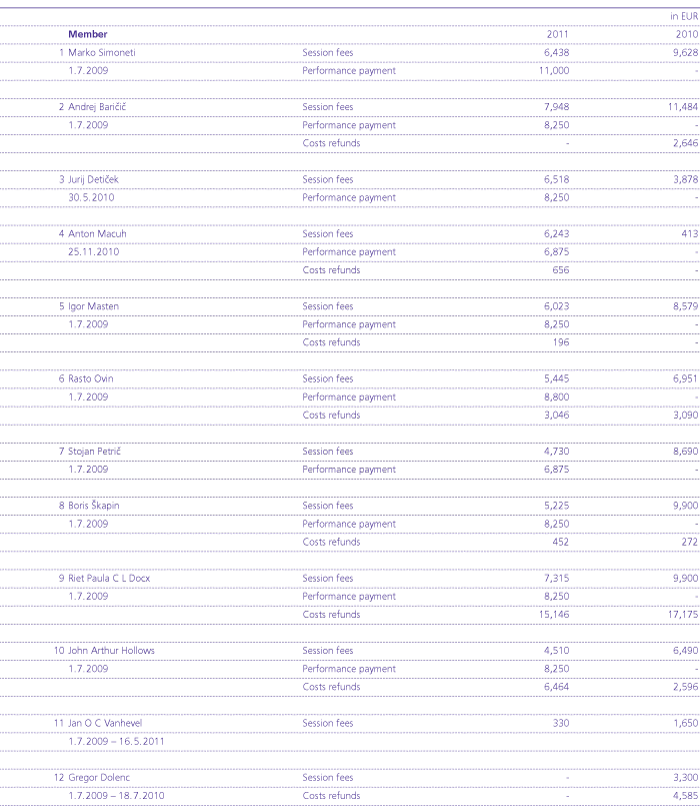Audited financial statements for NLB d.d. and the NLB Group
Notes to the financial statements

Notes to the financial statements
1. GENERAL INFORMATION
Nova Ljubljanska banka d.d. Ljubljana (hereinafter: NLB) is a joint stock entity providing universal banking services. The NLB Group operates in more than thirteen countries.
NLB is incorporated and domiciled in Slovenia. The address of its registered office is Trg Republike 2, Ljubljana. NLB’s shares are not listed on the stock exchange.
NLB’s largest shareholders as at December 31, 2011 are the Republic of Slovenia, owning 45.62% of shares (December 31, 2010: 33.10%), and KBC Bank N.V. Brussels, owning 25.00% of shares (December 31, 2010: 30.57%). By increasing the capital of NLB, the Republic of Slovenia and its controlled companies exceeded 50% ownership in NLB. Republic of Slovenia together with its related companies presents the ultimate controlling party of NLB.
All amounts in the financial statements and in the notes to the financial statements are expressed in thousands of euros unless otherwise stated.
2. SUMMARY OF SIGNIFICANT ACCOUNTING POLICIES
The principal accounting policies adopted for the preparation of the separate and consolidated financial statements are set out below. Policies have been consistently applied to all the years presented.
2.1. Statement of compliance
The principal accounting policies applied in the preparation of the separate and consolidated financial statements have been prepared in accordance with the International Financial Accounting Standards (hereinafter: the IFRS) as adopted by the European Union (hereinafter: EU). Additional requirements under the national legislation are included where appropriate.
The separate and consolidated financial statements comprise the income statement and statement of comprehensive income, the statement of financial position, the statement of changes in equity, the statement of cash flows, significant accounting policies and the notes.
2.2. Basis of presentation of financial statements
The financial statements have been prepared under the historical cost convention as modified by the revaluation of available for sale financial assets and financial assets and financial liabilities at fair value through profit or loss, including all derivative contracts, and investment property.
The preparation of financial statements pursuant to the IFRS requires the use of estimates and assumptions that affect the reported amounts of assets and liabilities and the disclosure of contingent assets and liabilities at the date of the financial statements, and the reported amounts of revenue and expenses during the reporting period. Although these estimates are based on management’s best knowledge of current events and activities, actual results may ultimately differ from those estimates. Accounting estimates and underlying assumptions are reviewed on an ongoing basis. Revisions to accounting estimates are recognized in the period in which the estimate is revised. Critical accounting policies and estimates are disclosed in note 2.31.
2.3. Comparative amounts
Except when a standard or an interpretation permits or requires otherwise, all amounts are reported or disclosed with comparative amounts. Where IAS 8 applies, comparative figures have been adjusted to conform to changes in presentation in the current year.
2.4. Consolidation
In the consolidated financial statements subsidiary undertakings, which are those entities in which the NLB Group, directly or indirectly, has an interest of more than one half of the voting rights or otherwise has the power to exercise control over operations, have been fully consolidated. Subsidiaries are consolidated from the date on which effective control is transferred to the NLB Group and are no longer consolidated from the date that control ceases. Where necessary, the accounting policies of subsidiaries have been amended to ensure consistency with the policies adopted by the NLB Group. The financial statements of consolidated subsidiaries were prepared as of the parent entity’s reporting date. Non-controlling interests are disclosed in the consolidated statement of changes in equity. Non-controlling interest is that part of the net results and of the equity of a subsidiary attributable to interests which are not owned, directly or indirectly, by NLB. The NLB Group measures non-controlling interest on a transaction by transaction basis, either at fair value, or the non-controlling interest's proportionate share of net assets of the acquiree.
Inter-company transactions, balances and unrealized gains on transactions between NLB Group entities are eliminated. Unrealized losses are also eliminated unless the transaction provides evidence of impairment of the asset transferred.
The NLB Group treats transactions with noncontrolling interests as transactions with equity owners of the NLB Group. For purchases from non-controlling interests, the difference between any consideration paid and the relevant share acquired of the carrying value of net assets of the subsidiary is deducted from equity. Gains or losses on sales to non-controlling interests are also recorded in equity. For sales to noncontrolling interests, the differences between any proceeds received and the relevant share of noncontrolling interests are also recorded in equity.
The NLB Group’s subsidiaries are presented in note 5.14.
2.5. Investments in subsidiaries, associates and joint ventures
In the separate financial statements, investments in subsidiaries, associates and joint ventures are accounted for at cost. Dividends from a subsidiaries, joint ventures or associates are recognized in income statement when NLB’s right to receive the dividend is established.
In the consolidated financial statements, investments in associates are accounted for using the equity method of accounting. These are undertakings in which the NLB Group generally holds between 20% and 50% of voting rights, and over which the NLB Group exercises significant influence, but does not have control.
The NLB Group’s share of its associates’ postacquisition profits or losses is recognized in the income statement, its share of other comprehensive income is recognized in other comprehensive income. The cumulative post-acquisition movements are adjusted against the carrying amount of the investment. When the NLB Group’s share of losses in an associate equals or exceeds its interest in the associate, including any other unsecured receivables, the NLB Group does not recognize further losses, unless it has incurred obligations or made payments on behalf of the associate.
Joint ventures are those entities over whose activities the NLB Group has joint control, as established by contractual agreement. In the consolidated financial statements investments in joint ventures are accounted for using the equity method of accounting.
The NLB Group’s principal associates and joint ventures are presented in note 5.14.
2.6. Goodwill and bargain purchases
Goodwill is measured by deducting the net assets of the acquiree from the aggregate of the consideration transferred for the acquiree, the amount of noncontrolling interest in the acquiree and fair value of an interest in the acquiree held immediately before the acquisition date. Any negative amount (“negative goodwill”) is recognized in profit or loss, after management reassesses whether it identified all the assets acquired and all liabilities and contingent liabilities assumed and reviews appropriateness of their measurement.
The consideration transferred for the acquiree is measured at the fair value of the assets given up, equity instruments issued and liabilities incurred or assumed, including fair value of assets or liabilities from contingent consideration arrangements but excludes acquisition related costs such as advisory, legal, valuation and similar professional services. Transaction costs incurred for issuing equity instruments are deducted from equity; transaction costs incurred for issuing debt are deducted from its carrying amount and all other transaction costs associated with the acquisition are expensed.
The goodwill of associates and joint ventures is included in the carrying value of investments.
2.7. Mergers of NLB Group entities
A merger of entities within the NLB Group is a business combination involving entities under common control. For such mergers the NLB Group applies merger accounting principles and uses the carrying amounts of merged entities, as reported in the consolidated financial statements. No goodwill arises on mergers of NLB Group entities and any difference between net assets merged and the cost of investment is recorded directly in equity.
Mergers of entities within the NLB Group do not affect the consolidated financial statements.
2.8. Foreign currency translation
Functional and presentation currency
Items included in the financial statements of each of the NLB Group's entities are measured using the currency of the primary economic environment in which the entity operates (i.e. the functional currency). The financial statements are presented in euros, which is the NLB Group’s presentation currency.
Transactions and balances
Foreign currency transactions are translated into the functional currency at the exchange rates prevailing at the dates of the transactions. Foreign exchange gains and losses resulting from the settlement of such transactions and from the translation of monetary assets and liabilities denominated in foreign currencies are recognized in the income statement, except when deferred in other comprehensive income as qualifying cash flow hedges.
Translation differences resulting from changes in the amortized cost of monetary items denominated in foreign currency and classified as available for sale financial assets, are recognized in the income statement.
Translation differences on non-monetary items, such as equities at fair value through profit or loss, are reported as part of the fair value gain or loss in the income statement. Translation differences on nonmonetary items, such as equities classified as available for sale, are included together with valuation reserves in the valuation (losses)/gains taken to other comprehensive income and accumulated in revaluation reserve in equity.
Gains and losses resulting from foreign currency purchases and sales for trading purposes are included in the income statement as gains less losses from financial assets and liabilities held for trading.
NLB Group entities
The financial statements of all the NLB Group entities that have a functional currency different from the presentation currency are translated into the presentation currency as follows:
- assets and liabilities for each statement of financial position presented are translated at the closing rate at the reporting date;
- income and expenses for each income statement are translated at average exchange rates;
- components of equity are translated at the historic rate; and
- all resulting exchange differences are recognized in other comprehensive income.
Goodwill and fair value adjustments arising from the acquisition of a foreign entity are treated as assets and liabilities of the foreign entity and translated at the closing rate.
During consolidation, exchange differences arising from the translation of the net investment in foreign operations are transferred to other comprehensive income. When control over a foreign operation is lost, the previously recognized exchange differences on translations to a different presentation currency are reclassified from other comprehensive income to profit and loss for the year as part of the gain or loss on disposal. On partial disposal of a subsidiary without loss of control, the related portion of accumulated currency translation differences is reclassified to noncontrolling interest within equity.
2.9. Interest income and expenses
Interest income and expenses are recognized in the income statement for all interest-bearing instruments on an accrual basis using the effective interest rate method. The effective interest rate method is a method used to calculate the amortized cost of a financial asset or financial liability and to allocate the interest income or interest expense over the relevant period. The effective interest rate is the rate that precisely discounts estimated future cash payments or receipts over the expected life of the financial instrument or a shorter period when appropriate, to the net carrying amount of the financial asset or financial liability. Interest income includes coupons earned on fixed-yield investments and trading securities and accrued discounts and premiums on securities. The calculation of the effective interest rate includes all fees and points paid or received between parties to the contract and all transaction costs, but excludes future credit risk losses. Once a financial asset or a group of similar financial assets has been impaired, interest income is recognized using the rate of interest used to discount the future cash flows for the purpose of measuring the impairment loss.
2.10. Fee and commission income
Fees and commissions are generally recognized when the service has been provided. Fees and commissions consist mainly of fees received from payment services and from the managing of funds on behalf of legal entities and individuals, together with commissions from guarantees. Fees and commissions that are integral to the effective interest rate of financial assets and liabilities are presented within interest income or expenses.
2.11. Dividend income
Dividends are recognized in the income statement when the NLB Group’s right to receive payment is established and inflow of economic benefits is probable. In consolidated financial statement dividends received from associates and joint ventures reduce the carrying value of the investment.
2.12. Financial instruments
a) Classification
The classification of financial instruments on initial recognition depends on the instruments’ characteristics and management’s intention. In general, the following criteria are taken into account:
Financial instruments at fair value through profit or loss
This category has two sub-categories: financial instruments held for trading and financial instruments designated at fair value through profit or loss at inception. A financial instrument is classified in this group if acquired principally for the purpose of selling in the short term or if so designated by management.
The NLB Group designates financial instruments at fair value through profit or loss if:
- it eliminates or significantly reduces a measurement or recognition inconsistency that would otherwise arise from measuring assets or liabilities on a different basis;
- a group of financial assets, financial liabilities or both is managed and its performance is evaluated on a fair value basis, in accordance with a documented risk management or investment strategy, and information about the group is provided internally on that basis to the NLB Group’s key management; or
- a financial instrument contains one or more embedded derivatives that could significantly modify the cash flows otherwise required by the contract.
Derivatives are also categorized as held for trading unless they are designated as hedging instruments.
Loans and advances
Loans and advances are non-derivative financial instruments with fixed or determinable payments that are not quoted on an active market, other than: (a) those that the NLB Group intends to sell immediately or in the short term, which are classified as held for trading, and those that the NLB Group, upon initial recognition, classifies at fair value through profit or loss; (b) those that the NLB Group, upon initial recognition, classifies as available for sale; or (c) those for which the NLB Group may not recover substantially all of its initial investment, for reasons other than deterioration in creditworthiness.
Held to maturity investments
Held to maturity investments are non-derivative financial instruments that are traded in an active market with fixed or determinable payments and a fixed maturity that the NLB Group has both the intention and ability to hold to maturity. An investment is not classified as held to maturity investment if the NLB Group has the right to require that the issuer repays or redeems the investment before its maturity, because paying for such a feature is inconsistent with expressing an intention to hold the assets until the maturity.
Available for sale financial assets
Available for sale financial assets are those intended to be held for an indefinite period of time, which may be sold in response to needs for liquidity or changes in interest rates, exchange rates or equity prices.
b) Measurement and recognition
Financial assets are initially recognized at fair value plus transaction costs for all financial assets not carried at fair value through profit or loss.
Financial assets carried at fair value through profit or loss are initially recognized at fair value and transaction costs are expensed in the income statement.
Regular way purchases and sales of financial assets at fair value through profit or loss, and assets held to maturity and available for sale, are recognized on the trade date. Loans and advances are recognized when cash is advanced to the borrowers.
Financial assets at fair value through profit or loss and available for sale financial assets are subsequently measured at fair value. Gains and losses from changes in the fair value of financial assets at fair value through profit or loss are included in the income statement in the period in which they arise. Gains and losses from changes in the fair value of available for sale financial assets are recognized in other comprehensive income until the financial asset is derecognized or impaired, at which time the cumulative amount previously included in other comprehensive income is recycled in the income statement. However, interest calculated using the effective interest rate method and foreign currency gains and losses on monetary assets classified as available for sale are recognized in the income statement. Dividends on available for sale equity instruments are recognized in the income statement when the NLB Group’s right to receive payment is established.
Loans and held to maturity investments are carried at amortized cost.
c) Day one gains or losses
The best evidence of fair value at initial recognition is the transaction price (i.e. the fair value of the consideration given or received), unless the fair value of that instrument is evidenced by comparison with other observable current market transactions in the same instrument (i.e. without modification or repackaging) or based on a valuation technique whose variables include only data from observable markets.
If the transaction price on a non-active market is different than the fair value from other observable current market transactions in the same instrument or is based on a valuation technique whose variables include only data from observable markets, the difference between the transaction price and fair value is recognized immediately in the income statement (“day one gains or losses”).
In cases where the data used for valuation is not fully observable in financial markets, day one gains or losses are not recognized immediately in the income statement. The timing of recognition of deferred day one gains or losses is determined individually. It is either amortized over the life of the transaction, deferred until the instrument’s fair value can be determined using market observable inputs or realized through settlement.
d) Reclassification
Financial assets that are eligible for classification as loans and advances can be reclassified out of the held for trading category if they are no longer held for the purpose of selling or repurchasing them in the near term. Financial assets that are not eligible for classification as loans and receivables may be transferred from the held for trading category only in rare circumstances. Additionally, instruments designated at fair value through profit and loss cannot be reclassified.
e) Derecognition
A financial asset is derecognized when the contractual rights to the cash flows from the financial asset expire or the financial asset is transferred and the transfer qualifies for derecognition. A financial liability is derecognized only when it is extinguished, i.e. when the obligation specified in the contract is discharged, cancelled or expires.
f) Fair value measurement principles
The fair value of financial instruments traded on active markets is based on the current bid price at the reporting date, excluding transaction costs. If there is no active market, the fair value of the instruments is estimated using discounted cash flow techniques or pricing models.
If discounted cash flow techniques are used, estimated future cash flows are based on management’s best estimates and the discount rate is a market based rate at the reporting date for an instrument with similar terms and conditions. If pricing models are used, inputs are based on market based measurements at the reporting date.
g) Derivative financial instruments and hedge accounting
Derivative financial instruments, including forward and futures contracts, swaps and options, are initially recognized in the statement of financial position at fair value. Derivative financial instruments are subsequently re-measured at their fair value. Fair values are obtained from quoted market prices, discounted cash flow models or pricing models, as appropriate. All derivatives are carried at their fair value within assets when the derivative position is favourable to the NLB Group and within liabilities when the derivative position is unfavourable to the NLB Group.
The method of recognizing the resulting fair value gain or loss depends on whether the derivative is designated as a hedging instrument, and if so, the nature of the item being hedged. The NLB Group designates certain derivatives as either:
- hedges of the fair value of recognized assets or liabilities or firm commitments (fair value hedge),
- hedges of highly probable future cash flows attributable to a recognized asset or liability, or a highly probable forecasted transaction (cash flow hedge) or
- hedges of a net investment in a foreign operation (net investment hedge).
Hedge accounting is used for derivatives designated in this way provided certain criteria are met.
The NLB Group documents, at the inception of the transaction, the relationship between hedged items and hedging instruments, as well as its risk management objective and strategy for undertaking various hedge transactions. The NLB Group also documents its assessment, both at hedge inception and on an ongoing basis, whether the derivatives that are used in hedging transactions are highly effective in offsetting changes in fair values or cash flows of hedged items. The actual results of a hedge must always fall within a range of 80% to 125%.
Fair value hedge
Changes in the fair value of derivatives that are designated and qualify as fair value hedges are recognized in the income statement, together with any changes in the fair value of the hedged asset or liability that are attributable to the hedged risk. Effective changes in the fair value of hedging instruments and related hedged items are reflected in “fair value adjustments in hedge accounting” in the income statement. Any ineffectiveness is recorded in “Gains less losses on financial assets and liabilities held for trading”.
If a hedge no longer meets the hedge accounting criteria, the adjustment to the carrying amount of the hedged item for which the effective interest rate method is used is amortized to profit or loss over the remaining period to maturity. The adjustment to the carrying amount of a hedged equity security is included in the income statement upon disposal of the equity security.
Cash flow hedge
The effective portion of changes in the fair value of derivatives that are designated and qualify as cash flow hedges is recognized in other comprehensive income. The gain or loss relating to the ineffective portion is recognized immediately in the income statement in “Gains less losses on financial assets and liabilities held for trading”.
Amounts accumulated in equity are recycled as a reclassification from other comprehensive income to the income statement in the periods when the hedged item affects profit or loss.
When a hedging instrument expires or is sold, or when a hedge no longer meets hedge accounting criteria, any cumulative gain or loss existing in other comprehensive income and previously accumulated in equity at that time remains in other comprehensive income and in equity and is recognized in profit or loss only when the forecasted transaction is ultimately recognized in the income statement. When a forecasted transaction is no longer expected to occur, the cumulative gain or loss that was reported in other comprehensive income is immediately transferred to the income statement.
Hedge of a net investment in a foreign operation
Hedges of net investments in foreign operations are accounted for similarly to cash flow hedges. Any gain or loss on the hedging instrument relating to the effective portion of the hedge is recognized directly in equity. The gain or loss relating to the ineffective portion is recognized immediately in the consolidated income statement in “Gains less losses on financial assets and liabilities held for trading”. Gains and losses accumulated in other comprehensive income are included in the consolidated income statement when the foreign operation is disposed of as part of the gain or loss on the disposal.
In the separate financial statements the hedge of the net investment in foreign operation is accounted for as fair value hedge.
2.13. Impairment of financial assets
a) Assets carried at amortized cost
The NLB Group assesses impairments of financial assets individually for all individually significant assets where there is objective evidence of impairment; all other financial assets are impaired collectively. According to the Regulation on credit risk loss assessment of the Bank of Slovenia financial asset or off-balance sheet liability is individually significant if total exposure to the client exceeds 0.5% of bank’s equity. In years 2011 and 2010 all exposures to banks, all exposures to other legal entities with A and B rating whose exposure exceeds EUR 6,500 thousand, all legal entities rated C, whose exposure exceeds EUR 500 thousand and all exposures to D and E legal entities, whose exposure exceeds EUR 10 thousand are considered individually significant assets by NLB. If the NLB Group determines that no objective evidence of impairment exists for an individually assessed financial asset, it includes the asset in a group of financial assets with similar credit risk characteristic and collectively assesses them for impairment.
The NLB Group assesses at each reporting date whether there is objective evidence that a financial asset or group of financial assets is impaired. A financial asset or group of financial assets is impaired and impairment losses are incurred if, and only if, there is objective evidence of impairment as a result of one or more events that occurred after the initial recognition of the asset and that event has an impact on the future cash flows of the financial asset or group of financial assets that can be reliably estimated.
The criteria that the NLB Group uses to determine that there is objective evidence of an impairment loss include:
- delinquency in contractual payments of principal or interest;
- cash flow difficulties experienced by the borrower;
- breach of loan covenants or conditions;
- initiation of bankruptcy proceedings;
- deterioration of the borrower’s competitive position;
- deterioration in the value of collateral; and
- downgrading below investment grade level.
The estimated period between the occurrence of problems, which prevent the client from paying his obligations to the NLB Group, and identification of these problems by the NLB Group varies from between three and six months.
If there is objective evidence that an impairment loss on loans and advances or held to maturity investment has been incurred, the amount of the loss is measured as the difference between the asset’s carrying amount and the present value of estimated future cash flows. The carrying amount of the asset is reduced through an allowance account and the amount of the loss is recognized in the income statement. The calculation of the present value of the estimated future cash flows of collateralized financial assets reflects the cash flows that may result from foreclosure, less cost of obtaining and selling the collateral. Off-balance sheet liabilities are also assessed individually and where necessary related provision are recognized as liabilities.
For the purpose of collective evaluation of impairment, the NLB Group uses migration matrices, which illustrate the expected migration of customers between internal rating classes. The probability of migration is assessed on the basis of past years’ experience, i.e. annual migration matrices for different types of customers. These data may be adopted for the predicted future trends since historic experience does not necessarily reflect the actual economic movements. Exposures to individuals are additionally analyzed with regard to type of products. Based on the expected migration of clients to D and E rating class and assessment of average repayment rate for D and E rated customers, the NLB Group recognizes collective impairments.
If the amount of impairment subsequently decreases due to an event occurring after the write down, the reversal of the loss is recognized as a reduction in the allowance for loan impairment.
When a loan is uncollectible, it is written off against the related allowance for loan impairment. Such loans are written off after all the necessary procedures have been completed and the amount of the loss has been determined. Subsequent recoveries of amounts previously written off decrease the amount of the provision for loan impairment in the income statement.
The objective criteria that the NLB Group uses to determine that a loan should be written off include:
- the debtor no longer performs his regular activities (termination of the legal entity);
- the NLB Group holds no adequate collateral to be used for repayment; and
- judicial recovery proceedings have been concluded.
b) Assets classified as available for sale
The NLB Group assesses at each reporting date whether there is objective evidence that available for sale financial assets are impaired. In the case of equity investments classified as available for sale, a significant or prolonged decline in the fair value of a security below its cost is considered in determining whether the assets are impaired. If any such evidence exists for available for sale financial assets, the cumulative loss is reclassified from other comprehensive income and recognized in the income statement as an impairment loss. Impairment losses recognized in the income statement on equity instruments are not reversed through the income statement; subsequent increases in their fair value after impairment are recognized in other comprehensive income.
If, in a subsequent period, the fair value of a debt instrument classified as available for sale increases and the increase can be objectively related to an event occurring after the impairment loss was recognized, the impairment loss is reversed through the income statement.
The following factors are considered in determining impairment losses on debt instruments:
- default or delinquency in interest or principal payments,
- liquidity difficulties of the issuer,
- breach of contract covenants or conditions,
- bankruptcy of the issuer,
- deterioration of economic and market conditions and
- deterioration in the credit rating of the issuer below the acceptable level.
Impairment losses recognized in the income statement are measured as the difference between the carrying amount of the financial asset and its current fair value. The current fair value of the instrument is its market price or discounted future cash flows, when the market price is not obtainable.
c) Renegotiated loans
Loans that are subject to either collective or individual impairment assessment and whose terms have been renegotiated due to deterioration of the borrower’s financial position are no longer considered to be past due but are treated as new loans. Such loans continue to be discounted using the original effective interest rate.
d) Repossessed assets
In certain circumstances, assets are repossessed following the foreclosure on loans that are in default. Repossessed assets are initially recognized in the financial statements at their fair values and are sold as soon as practical in order to reduce exposure (note 7.1.j). After initial recognition, repossessed assets are measured and accounted for in accordance with the policies applicable for the relevant assets categories.
In 2011 the NLB Group changed the accounting policy regarding the initial recognition for repossessed assets. Due to that repossessed assets in amount of EUR 1,288 thousand in NLB (December 31, 2010: EUR 1,292 thousand) and in the NLB Group in amount of EUR 28,709 thousand (December 31, 2010: EUR 27,572 thousand) were reclassified from non-current assets and disposal group held for sale to other assets (note 5.10.d).
2.14. Offsetting
Financial assets and liabilities are offset and the net amount reported in the statement of financial position when there is a legally enforceable right to offset the recognized amounts and there is an intention to settle on a net basis, or to realize the asset and settle the liability simultaneously.
2.15. Sale and repurchase agreements
Securities sold under sale and repurchase agreements (repos) are retained in the financial statements and the counterparty liability is included in financial liabilities associated with the transferred assets. Securities sold subject to sale and repurchase agreements are reclassified in the financial statements as pledged assets when the transferee has the right by contract or custom to sell or re-pledge the collateral. Securities purchased under agreements to resell (reverse repos) are recorded as loans and advances to other banks or customers, as appropriate.
The difference between the sale and repurchase price is treated as interest and accrued over the life of the repo agreements using the effective interest rate method.
2.16. Property and equipment
All items of property and equipment are initially recognized at cost. They are subsequently measured at cost less accumulated depreciation and any accumulated impairment loss.
Each year, the NLB Group assesses whether there are indications that assets may be impaired. If any such indication exists, the recoverable amounts are estimated. The recoverable amount is the higher of the fair value less costs to sell and value in use. If the recoverable amount exceeds the carrying value, the assets are not impaired. If the carrying amount exceeds the recoverable amount, the difference is recognized as a loss in the income statement.
Items of property and equipment, which do not generate cash flows that are largely independent, are included in cash generating unit and later tested for possible impairment.
Depreciation is calculated on a straight-line basis over the assets’ estimated useful lives. The following annual depreciation rates were applied:
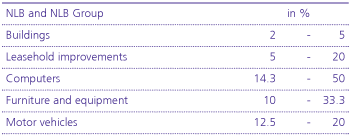
Depreciation does not begin until the assets are available for use.
The assets' residual values and useful lives are reviewed, and adjusted if appropriate, on each reporting date.
Gains and losses on the disposal of items of property and equipment are determined as a difference between the sale proceeds and their carrying amount, and are recognized in the income statement.
Maintenance and repairs are charged to the income statement during the financial period in which they are incurred. Subsequent costs that increase future economic benefits are recognized in the carrying amount of an asset and the replaced part, if any, is derecognized.
2.17. Intangible assets
Intangible assets include software licenses, goodwill (note 2.6.) and customer relationships. Intangible assets are stated at cost, less accumulated amortization and impairment losses.
Amortization is calculated on a straight-line basis at rates designed to write down the cost of intangible asset over its estimated useful life. The core banking system is amortized over a period of ten years, other software over a period of three to five years and customer relationships over a period of twelve to fifteen years.
Amortization does not begin until the assets are available for use.
2.18. Investment property
Investment property includes buildings held for leasing and not occupied by the NLB Group. Investment property is stated at fair value determined by a certified appraiser. Fair value is based on current market prices. Any gain or loss arising from a change in fair value is recognized in the income statement. If there is a change in use due to the commencement of owner occupation, investment property is transferred to owner occupied property.
2.19. Non-current assets and disposal group classified as held for sale
Non-current assets and disposal group are classified as held for sale if their carrying amount will be recovered through a sale transaction rather than through continuing use. This condition is deemed to be met only when the sale is highly probable and the asset is available for immediate sale in its present condition. Management must be committed to the sale, which should be expected to qualify for recognition as a completed sale within one year from the date of classification. Non-current assets and disposal group classified as held for sale are measured at the lower of the assets’ previous carrying amount and fair value less costs to sell.
During subsequent measurement, certain assets and liabilities of disposal group that are outside the scope of IFRS 5 measurement requirements are measured in accordance with the applicable standards (e.g. deferred tax assets, assets arising from employee benefits, financial instruments, investment property measured at fair value and contractual rights under insurance contracts). Tangible and intangible assets are not depreciated. The effects of sale and valuation are included in the income statement as a gain or loss from non-current assets held for sale.
Liabilities directly associated with disposal groups are reclassified and presented separately in the statement of financial position.
2.20. Accounting for leases
A lease is an agreement whereby the lessor conveys to the lessee, in return for a payment or series of payments, the right to use an asset for an agreed period of time. Lease agreements are accounted for in accordance with their classification as finance leases or operating leases at the inception of the lease. The key classification factor is the extent to which the risks and rewards incidental to ownership of a leased asset lie with the lessor or lessee.
The NLB Group as lessee
Leases in which a significant portion of the risk and rewards of ownership are retained by the lessor are classified as operating leases. Payments made under operating leases are charged to the income statement on a straight-line basis over the period of the lease. When an operating lease is terminated before the lease period has expired, any payment required to be made to the lessor by way of penalty is recognized as an expense in the period in which termination takes place.
Finance leases are recognized as an asset and liability at amounts equal to the fair value of the leased asset or, if lower, the present value of the minimum lease payments. Leased assets are depreciated in accordance with the NLB Group’s policy over the shorter of the estimated useful life of the asset and the lease term, if there is no reasonable certainty that the NLB Group will obtain ownership by the end of the lease term. Lease payments are apportioned between interest expenses and the reduction of the outstanding liability so as to produce constant periodic rate of interest on the remaining balance of the liability.
The NLB Group as lessor
Payments under operating leases are recognized as income on a straight-line basis over the period of the lease. Assets leased under operating leases are presented in the statement of financial position as investment property or as property and equipment.
The NLB Group classifies a lease as a finance lease when the risks and rewards incidental to ownership of a leased asset lie with the lessee. When assets are leased under a finance lease, the present value of the lease payments is recognized as a receivable. Income from finance lease transactions is amortized over the lifetime of the lease using the effective interest rate method. Finance lease receivables are recognized at an amount equal to the net investment in the lease, including the unguaranteed residual value.
Sale-and-leaseback transactions
The NLB Group also enters into sale-and-leaseback transactions (in which the NLB Group is primarily a lessor), under which the leased assets are purchased from and then leased back to the lessee. These contracts are classified as finance leases or operating leases, depending on the contractual terms of the leaseback agreement.
2.21. Cash and cash equivalents
For the purpose of the statement of cash flows, cash and cash equivalents comprise cash and balances with central banks, debt securities held for trading, loans to banks and debt securities not held for trading with an original maturity of up to 90 days. Cash and cash equivalents are disclosed under the cash flow statement.
2.22. Borrowings
Borrowings are initially recognized at fair value net of transaction costs. Borrowings are subsequently stated at amortized cost and any difference between the amount initially recognized and the redemption value is recognized in the income statement over the period of the borrowings using the effective interest rate method.
If the NLB Group purchases its own debt, it is derecognized from the statement of financial position. Any difference between the carrying amount of the purchased debt and the amount paid is recognized immediately in the income statement.
2.23. Provisions
Provisions are recognized when the NLB Group has a present legal or constructive obligation as a result of past events and it is probable that an outflow of resources embodying economic benefits will be required to settle the obligation and a reliable estimate of the amount of the obligation can be made.
2.24. Financial guarantees
Financial guarantees are contracts that require the issuer to make specific payments to reimburse the holder for a loss it incurs because a specific debtor fails to make payments when due, in accordance with the terms of debt instruments. Such financial guarantees are given to banks, financial institutions and other bodies on behalf of the customer to secure loans, overdrafts and other banking facilities.
Financial guarantees are initially recognized at fair value, which is normally evidenced by the fees received. The fees are amortized to the income statement over the contract term using the straightline method. The NLB Group’s liabilities under guarantees are subsequently measured at the greater of:
- the initial measurement, less amortization calculated to recognize fee income over the period of guarantee or
- the best estimate of the expenditure required to settle the obligation.
2.25. Inventories
Inventories are measured at the lower of cost and net realizable value. Cost is determined using the weighted average cost method.
2.26. Taxes
Income tax in the NLB Group is calculated on taxable profits at the applicable tax rate in the respective jurisdiction. The tax rate for 2011 in Slovenia is 20% (2010: 20%).
Deferred income tax is calculated, using the balance sheet liability method, for all temporary differences arising between the tax bases of assets and liabilities and their carrying amounts for financial reporting purposes.
Deferred tax assets are recognized if it is probable that future taxable profit will be available against which the temporary differences can be utilized.
Deferred tax related to the fair value re-measurement of available for sale investments and cash flow hedges is charged or credited directly to other comprehensive income.
Deferred tax assets and liabilities are measured at tax rates enacted or substantively enacted at the end of the reporting period that are expected to apply to the period when the asset is realized or the liability is settled. At each reporting date, the NLB Group reviews the carrying amount of deferred tax assets and assesses future taxable profits against which temporary taxable differences can be utilized.
Deferred tax assets for temporary differences arising from investments in subsidiaries, associates and joint ventures are recognized only to the extent that it is probable that:
- the temporary differences will be reversed in the foreseeable future; and
- taxable profit will be available.
In 2011, the NLB Group recorded a net loss. The deferred tax assets recognized at December 31, 2011 are based on future profitability assumptions and business plans for future years. Tax assets may be adjusted in the event of changes to these assumptions.
In 2011 a new tax on balance sheet was enforced, which is in NLB recognized in other operating expenses (note 4.7.).
Tax base for balance sheet tax is balance sheet volume, which represents value of assets in Statement of financial position. It is calculated as the average value of monthly values on the last day of each month in the calendar year. Tax rate for balance sheet is 0,1%.
Calculated tax may be reduced by 0,167% of loans granted to nonfinancial firms and independent entrepreneurs. Loans are calculated as the average value of monthly net balances without allowances for impairments or change in fair value on the last day of each month in the calendar year. For the year 2011 due to the provision of Tax on Balance Sheet Act, average balances on balance sheet volume and loans are calculated using monthly balances from August onwards.
2.27. Fiduciary activities
The NLB Group provides asset management services to its clients. Assets held in a fiduciary capacity are not reported in the NLB Group’s financial statements, as they do not represent assets of the NLB Group. Fee and commission income charged for this type of service is broken down by items in note 4.3.b). Further details on transactions managed on behalf of third parties are disclosed in note 5.29.
Based on the requirements of Slovenian legislation, the NLB Group has additionally disclosed in note 5.29. assets and liabilities on accounts used to manage financial assets from fiduciary activities, i.e. information related to the receipt, processing and execution of orders and related custody activities.
2.28. Employee benefits
Employee benefits include jubilee long service benefits, retirement indemnity bonuses and termination benefits. Provisions for employee benefits are calculated by an independent actuary. The main assumptions included in the actuarial calculation are as follows:
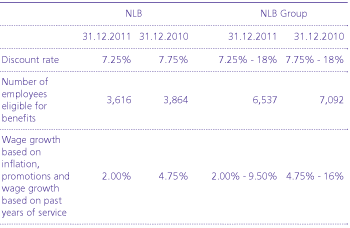
According to legislation, employees retire after 35-40 years of service, when, if they fulfil certain conditions, they are entitled to a lump-sum severance payment. Employees are also entitled to a long service bonus for every ten years of service.
These obligations are measured at the present value of future cash outflows considering future salary increases and then apportioned to past and future employee service based on benefit plan terms and conditions. All gains and losses arising from changes in assumptions and experience adjustments are recognized immediately in the income statement.
The NLB Group pays contributions to the state pension schemes according to the local legislation.
NLB contributes 8.85% of gross salaries. Once contributions have been paid, the NLB Group has no further obligation. Contributions constitute costs in the period to which they relate and are disclosed in employee costs in the income statement.
2.29. Share capital
Dividends on ordinary shares
Dividends on ordinary shares are recognized in equity in the period in which they are approved by NLB’s shareholders.
Treasury shares
If NLB or other member of the NLB Group purchases NLB’s shares, the consideration paid is deducted from total shareholders’ equity as treasury shares. If such shares are subsequently sold, any consideration received is included in equity. If NLB's shares are purchased by NLB itself or other NLB Group entities, NLB creates reserves for treasury shares in equity.
Share issue costs
Costs directly attributable to the issue of new shares are recognized in equity as a reduction in the share premium account.
2.30. Segment reporting
Operating segments are reported in a manner consistent with internal reporting to the management board which is the executive body that makes decisions, regarding the allocation of resources and assesses the performance of a specific segment.
All transactions between business segments are conducted on a normal course of business with intrasegment income and costs eliminated. Income and expenses directly associated with each segment are included in determining segment’s performance. Income taxes are not allocated to segments (note 8.1.). The amount of net income arising from transactions between segments is disclosed in the item intersegment net income. Net income from external customers corresponds to the consolidated net income of the NLB Group.
In accordance with IFRS 8, the NLB Group has the following reportable segments: Corporate banking Slovenia, Retail banking Slovenia, Financial markets Slovenia, Foreign strategic markets, Foreign nonstrategic markets and Other activities.
In 2011 the NLB Group changed the way, how operating segments are regularly reviewed, due to a new strategy and changed internal structure of the NLB Group. Operating segments are primary split on strategic and non-strategic and further strategic on key strategic components, that are Retail banking, Corporate banking and Financial Markets.
2.31. Critical accounting estimates and judgments in applying accounting policies
The NLB Group's financial statements are influenced by accounting policies, assumptions, estimates and management judgment. The NLB Group makes estimates and assumptions that affect the reported amounts of assets and liabilities within the next financial year. All estimates and assumptions required in conformity with IFRS are best estimates undertaken in accordance with the applicable standard. Estimates and judgments are evaluated on a continuing basis, and are based on part experience and other factors, including expectations with regard to future events.
a) Impairment losses on loans and advances
The NLB Group reviews its loan portfolio to assess impairment. In determining whether an impairment loss should be recorded in the income statement, NLB Group verifies whether there are any data indicating that there is a measurable decrease in the estimated future cash flows from the portfolio of loans. This evidence may include observable data indicating that the solvency of borrowers has deteriorated or that economic conditions and circumstances have deteriorated. Future cash flows in a group of financial assets are estimated based on past experience and losses on assets with credit risk characteristics similar to those assets in the group. Individual estimates are based on projections of future cash flows taking into account all relevant information regarding the financial position and solvency of a borrower. Projected cash flows are verified by risk department. Low-value exposures, including the majority of loans to individuals, are verified collectively. The methodology and assumptions used to estimate future cash flows are reviewed regularly to reduce differences between estimated and actual losses.
The NLB Group uses a sensitivity analysis to assess the impact of less probable negative events on impairments and provisions. Results of the simulation are based on the balance of loans and impairment as at December 31, 2011 and provide an assessment of required impairments within one year assuming the realization of the defined scenario.
Stress test using transition matrices
In the scenario historical transition matrices for financial institutions and other legal entities were used. The matrices for legal entities were also used for individuals. Exposure to the central government was not subject to the stress test. The methodology used is an extrapolation based on average transition matrices, which were calculated for the period in which the credit portfolio deteriorates. In addition, the transition matrices were corrected in a manner that excludes the possibility of client rating.
The scenario assumes that total credit exposure will not change in the one year period and the rating structure deterioration reflected through migration matrices will require additional impairments. As a result of the stress scenario, NLB will require additional impairments of EUR 261 million (2010: EUR 297 million) and the loan loss reserves to gross loan ratio will increase by 2.5 percentage points. For the NLB Group, the same stress scenario results in an increase in impairments of EUR 304 million (2010: EUR 344 million) and an increase in the coverage of the credit portfolio by impairments by 2.1 percentage points.
b) Fair value of financial instruments
The fair values of financial investments traded on the active market are based on current bid prices (financial assets) or offer prices (financial liabilities).
The fair values of financial instruments that are not traded on the active market are determined by using valuation models. These include a comparison with recent transaction prices, the use of a discounted cash flow model, valuation based on comparable companies and other frequently used valuation models. These valuation models pretty much reflect current market conditions at the measurement date, which may not be representative of market conditions either before or after the measurement date. Management reviewed all applied models as at the reporting date to ensure they appropriately reflect current market conditions, including the relative liquidity of the market and applied credit spread. Changes in assumptions regarding these factors could affect the reported fair values of financial instruments held for trading and available for sale financial assets.
The fair values of derivative financial instruments are determined on the basis of market data (markto- market), in accordance with the methodology for the valuation of derivative financial instruments. The market exchange rates, interest rates, yield and volatility curves used in valuation are based on the market snapshot principle. Market data is saved daily at 4 p.m. and later used for the calculation of the fair values (market value, NPV) of financial instruments. NLB applies market yield curves for valuation (see note 5.6.).
c) Available for sale equity instruments
Available for sale equity instruments are impaired, if there has been a significant or prolonged decline in fair value below historical cost. The determination of what is significant or prolonged is based on assessments. In making these assessments, the NLB Group takes into account several factors, including share price volatility. Impairment may also be indicated by evidence regarding deterioration in the financial position of the instrument issuer, deterioration in sector performance, changes in technology, and a decline in cash flows from operating and financing activities.
Had all the declines in fair value below cost been considered significant or prolonged, NLB would have incurred additional impairment losses of EUR 8,441 thousand (2010: EUR 44,765 thousand), while the NLB Group would have incurred additional impairment losses of EUR 9,705 thousand (2010: EUR 46,027 thousand) from the reclassification of the negative valuation from the statement of comprehensive income to the income statement for the current year.
d) Held to maturity instruments
The NLB Group classifies non-derivative financial assets with fixed or determinable payments and a fixed maturity as held to maturity investments. Before making this classification, the NLB Group assesses its intention and ability to hold such investments to maturity. If the NLB Group is unable to hold these investments until maturity, it must reclassify the entire group as available for sale financial assets. The investments would therefore be measured at fair value, resulting in a decrease in the value of investments of EUR 30,350 thousand (December 31, 2010: increase by EUR 7,937 thousand) and a corresponding other comprehensive loss.
e) Impairment of investment in subsidiaries, associates and joint ventures
The process of identifying and assessing the impairment of goodwill and other intangible assets is inherently uncertain, as the forecasting of cash flows requires the significant use of estimates, which themselves are sensitive to the assumptions used. The review of impairment represents management's best estimate of the factors such as:
- Future cash flows from individual investments depend on estimated cash flow for those periods for which formal plans are available and on assumptions regarding sustainability of and growth in cash flows in the future. The cash flows used represent management's assessment of future performance at the time of testing.
- The discount rate derived from the capital asset pricing model and used to discount future cash flows is based on the cost of equity allocated to an individual investment. The discount rate reflects the impact of range of financial and economic variables, including the risk-free rate and risk premium. The value of variables used is subject to fluctuations outside management's control.
If recoverable amount is value in use, the discounted cash flow method is used (NLB Leasing, Ljubljana, NLB Leasing Maribor, Maribor and NLB Leasing Sarajevo). When the recoverable amount is fair value less costs to sell, the value was determined based on binding offers and the estimated liquidation value (NLB Factor, Bratislava, NLB Factoring, Ostrava, NLB Serbia, Belgrade and LHB Internationale Handelsbank, Frankfurt).
If the discount rates in the discounted cash flows model differ by +/- 1 percentage point, the estimated value in use of the equity investments would be lower in case of increased discount rate by a maximum of EUR 3.5 million and in case of decreased discount rate the value in use of equity investments would be higher by a maximum of EUR 2.5 million.
If the forecasted cash flows in the discounted cash flows model differ by +/- 10 percentage point, the estimated value in use of the equity investments would be higher in case of increased forecasted cash flows by a maximum of EUR 3 million and in case of decreased forecasted cash flows the value in use of equity investments would be lower by a maximum of EUR 4.7 million.
f) Goodwill and other intangible assets
In the consolidated financial statements, goodwill and other intangible assets are allocated to cash-generating units (hereinafter: CGUs), which represent the lowest level within the NLB Group at which these assets are monitored by management. Each NLB Group entity presents a separate CGU. The recoverable amount of each CGU was determined based on value-in-use calculations. The calculation of value in use is based on cash flow projections in the three-year financial plans approved by management. The NLB Group performed a test for impairment of goodwill and other intangible assets at the end of the year for all subsidiaries.
Additional information regarding impairment testing of goodwill and other intangible assets is disclosed in note 5.13.
The goodwill for NLB Prishtina, Prishtina, represents an individually significant amount of goodwill in the NLB Group and amounts to EUR 9,738 thousand. When testing for possible impairment, the following assumptions were used: a discount rate of 13%, a growth rate for residual value of 2% p.a. and a target capital ratio of 16%. According to the test, goodwill was not impaired. If the discount rate increased for more than 7 percentage points, the carrying amount of goodwill in NLB Group would have to be impaired in amount of EUR 9,738 thousand to nil.
g) Taxes
The NLB Group operates in countries governed by different laws. The deferred tax assets recognized at December 31, 2011 are based on profit forecasts for the next five-year period and take into account expected manner of recovery of the assets, that is, whether the value will be recovered through use, sale or liquidation. Changes in the assumptions as to the likely manner of recovery of assets could lead to the recognition of currently unrecognized deferred tax assets or to derecognition of previously created deferred tax assets. In case of changed assumptions of future operations the NLB Group will adequately adjust deferred tax income assets. The NLB Group believes that this effect would be immaterial since the majority of deferred tax assets relates to tax losses which, in accordance with the Slovenian Corporate Income Tax Act, can be carried forward indefinitely.
2.32. Implementation of new and revised International Financial Reporting Standards
During the current year, the NLB Group adopted all new and revised standards and interpretations issued by the International Accounting Standards Board (hereinafter: the IASB) and the International Financial Reporting Interpretations Committee (hereinafter: the IFRIC) and endorsed by the EU that are effective for accounting periods beginning on January 1, 2011.
Accounting standards and amendments to existing standards effective for annual periods beginning on January 1, 2011 that were endorsed by EU and adopted by us
- IAS 24 (amendment) - Related Party Disclosures (effective for annual periods beginning on or after January 1, 2011). The revised standard simplifies the definition of a related party and provides a partial exemption from the disclosure requirements for government-related entities. If the exemption is applied, the entity shall disclose the nature and amount of each individually significant transaction. The amendment impacts presentation.
- Annual improvements to IFRS 2010. The improvements consist of a mixture of substantive changes and clarifications and are effective for annual periods beginning on or after January 1, 2011. IAS 27 clarifies the transition rules for amendments to IAS 21, 28 and 31 made by the revised IAS 27 (as amended in January 2008). Amendments in IAS 34 refer to interim financial reporting and affect the presentation of the NLB Group’s interim financial statement. Disclosure requirements in IFRS 7 emphasize the link between quantitative and qualitative disclosures regarding the nature and extent of financial risk and eliminates disclosures for renegotiated loans that would otherwise be past due or impaired, while disclosures regarding the fair value of collateral is replaced with a more general requirement, i.e. clarification of effect of collateral on mitigating the credit risk. Amendments to IFRS 3 require measurement of non-controlling interests at fair value, in certain cases provides guidance on an acquirer’s share-based payment arrangements that were not replaced or were voluntarily replaced as a result of a business combination, and requires that the contingent considerations from business combinations that occurred before the effective date of revised IFRS 3 are calculated using the previous IFRS 3. The amendment in IAS 1 clarifies the requirements for the presentation and content of the statement of changes in equity. Reconciliation between the carrying amount at the beginning and the end of the period for each component of equity must be presented in the statement of changes in equity, but its content is simplified by allowing an analysis of other comprehensive income by item for each component of equity to be presented in the notes. The amendments do not significantly affect the NLB Group’s financial statements.
- IFRS 7 (amendment) - Disclosures, Transfers of Financial Assets (effective for annual periods beginning on or after July 1, 2011). The amendment requires additional disclosures in respect of risk exposures arising from transferred financial assets. The amendment includes a requirement to disclose by class of asset the nature, carrying amount and a description of the risks and rewards of financial assets that have been transferred to another party yet remain on the entity's statement of financial position. Disclosures are also required to enable a user to understand the amount of any associated liabilities, and the relationship between the financial assets and associated liabilities. Where financial assets have been derecognized but the entity is still exposed to certain risks and rewards associated with the transferred asset, additional disclosure is required to enable the effects of those risks to be understood. The NLB Group is currently assessing the impact of the amended standard on disclosures in its financial statements.
- Other revised standards and interpretations effective for the current period: IFRIC 19 Extinguishing Financial Liabilities with Equity Instruments, amendments to IAS 32 Classifications of Rights of Issues, clarifications in IFRIC 14 Prepayments of a Minimum Funding Requirement and amendments in IFRS 1 Limited Exemption from Comparative IFRS 7 Disclosures for First-time Adopters did not have any impact on these financial statements.
Accounting standards and amendments to existing standards issued but not endorsed by EU:
- IFRS 9 - Financial Instruments IFRS 9 issued in November 2009 replaces those parts of IAS 39 relating to the classification and measurement of financial assets. IFRS 9 was further amended in October 2010 to address the classification and measurement of financial liabilities. Key features of the standard are as follows:
- Financial assets are required to be classified into two measurement categories: those to be measured subsequently at fair value, and those to be measured subsequently at amortized cost. The decision is to be made at initial recognition. The classification depends on the entity’s business model for managing its financial instruments and the contractual cash flow characteristics of the instrument.
- An instrument is subsequently measured at amortized cost only if it is a debt instrument and both (i) the objective of the entity’s business model is to hold the asset to collect the contractual cash flows, and (ii) the asset’s contractual cash flows represent only payments of principal and interest (i.e. it bears only “basic loan features”). All other debt instruments are to be measured at fair value through profit or loss.
- All equity instruments are to be measured subsequently at fair value. Equity instruments that are held for trading will be measured at fair value through profit or loss. For all other equity investments, an irrevocable election can be made at initial recognition, to recognize unrealized and realized fair value gains and losses through other comprehensive income rather than profit or loss. There is to be no recycling of fair value gains and losses to profit or loss. This election may be made on an instrument-by-instrument basis. Dividends are to be presented in profit or loss, as long as they represent a return on investment.
- Most of the requirements in IAS 39 for classification and measurement of financial liabilities were carried forward unchanged to IFRS 9. The key change is that an entity will be required to present the effects of changes in own credit risk of financial liabilities designated as at fair value through profit or loss in other comprehensive income.
- Adoption of IFRS 9 is mandatory from January 1, 2015, while earlier adoption is permitted, but the EU has not yet endorsed it. The NLB Group is considering the implications of the standard, the impact on the NLB Group and the timing of its adoption.
- IAS 32 (amendments) - Offsetting Financial Assets and Financial Liabilities (effective for annual periods beginning on or after January 1, 2014). The amendment added application guidance to IAS 32 to address inconsistencies identified in applying some of the offsetting criteria. This includes clarifying the meaning of ‘currently has a legally enforceable right of set-off’ and that some gross settlement systems may be considered equivalent to net settlement.
- IFRS 7 (amendments) - Offsetting Financial Assets and Financial Liabilities (effective for annual periods beginning on or after January 1, 2013). The amendment requires disclosures that will enable users of an entity’s financial statements to evaluate the effect or potential effect of netting arrangements, including rights of set-off. The amendment will have an impact on disclosures of financial instruments on the NLB Group.
- IAS 1 (amendment) - Presentation of Financial Statements (effective for annual periods beginning on or after July 1, 2012, with earlier application permitted). The amendments retain the option to present profit or loss and other comprehensive income in either a single statement or in two separate but consecutive statements. However, the amendments require additional disclosures to be made in the other comprehensive income section, such that items of other comprehensive income are grouped into two categories: items that will not be reclassified subsequently to profit or loss; and items that will be reclassified subsequently to profit or loss when specific conditions are met. Income tax on items of other comprehensive income must be allocated on the same basis. The NLB Group is currently evaluating the potential impact that the adoption of the amendments will have on the presentation of its consolidated financial statements.
- IFRS 10 - Consolidated Financial Statements, IFRS 11 - Joint Arrangements, IFRS 12 - Disclosures of Interests in Other Entities, a revised version of IAS 27 - Separate Financial Statements, which has been amended for the issuance of IFRS 10 but retains the current guidance for separate financial statements, and a revised version of IAS 28 - Investments in Associates and Joint Ventures, which has been amended for conforming changes based on the issuance of IFRS 10 and IFRS 11. Standards are effective for annual periods beginning on or after January 1, 2013, with earlier application permitted as long as each of the other standards is also applied early. However, entities are permitted to include any of the disclosure requirements in IFRS 12 into their consolidated financial statements without the early adoption of IFRS 12. The NLB Group is currently evaluating the potential impact that the adoption of the standards will have on its consolidated financial statements.
- IFRS 10 (new standard). The new standard replaces the parts of IAS 27 - Consolidated and Separate Financial Statements that deal with consolidated financial statements. SIC 12 Consolidation - Special Purpose Entities has been withdrawn upon the issuance of IFRS 10. Under IFRS 10, there is only one basis for consolidation, that being control. In addition, IFRS 10 includes a new definition of control that contains three elements: control over an investee, exposure, or rights to variable returns from its involvement with the investee, and the ability to use its control over the investee to affect the amount of the investor's returns. Extensive guidance has been added in IFRS 10 to deal with complex scenarios.
- IFRS 11 (new standard). The new standard replaces IAS 31 - Interests in Joint Ventures. IFRS 11 deals with how a joint arrangement, over which two or more parties have joint control, should be classified. SIC 13 Jointly Controlled Entities - Non-monetary Contributions by Venturers has been withdrawn upon the issuance of IFRS 11. Under IFRS 11, joint arrangements are classified as joint operations or joint ventures, depending on the rights and obligations of the parties to the arrangements. In contrast, under IAS 31, there are three types of joint arrangements: jointly controlled entities, jointly controlled assets and jointly controlled operations. In addition, joint ventures under IFRS 11 must be accounted for using the equity method of accounting, whereas jointly controlled entities under IAS 31 may be accounted for using the equity method of accounting or proportionate accounting.
- IFRS 12 (new standard). The new standard is a disclosure standard and is applicable to entities that have interests in subsidiaries, joint arrangements, associates and/or unconsolidated structured entities. In general, the disclosure requirements in IFRS 12 are more extensive than those in the current standards.
- IFRS 13 (new standard) - Fair Value Measurement (effective for annual periods beginning on or after January 1, 2013, with earlier application permitted). The standard establishes a single source of guidance for fair value measurements and disclosures about fair value measurements. The standard defines fair value, establishes a framework for measuring fair value, and requires disclosures about fair value measurements. The scope of the standard is broad; it applies to both financial instruments and non-financial instruments for which other standards require or permit fair value measurements and disclosures about fair value measurements, except in specified circumstances. In general, the disclosure requirements in IFRS 13 are more extensive than those required in the current standards. For example, quantitative and qualitative disclosures based on the three-level fair value hierarchy, currently required for financial instruments only under IFRS 7 Financial Instruments: Disclosures, will be extended by IFRS 13 to cover all assets and liabilities within its scope. The NLB Group is currently evaluating the potential impact that the adoption of the standard will have on its consolidated financial statements.
- Other revised standards and interpretations: amendments to IAS 19 - Employee Benefits, relating to the recognition and measurement of defined benefit obligations and to the disclosure to all employee benefits, amendments to IFRS 1 - Fist time Adoption of IFRS, relating to severe hyperinflation and removal of fixed dates for first-time adopters, amendment to IAS 12 - Income Taxes, relating to the recovery of underlying assets – investment property measured at fair value and amendment to IFRIC 20 - Stripping Costs in the Production Phase of a Surface Mine are not expected to affect the NLB Group’s financial statements.
3. CHANGES IN SUBSIDIARY HOLDINGS
Changes in 2011
a) Capital increase:
- The increase of share capital by cash in total amount of EUR 44,696 thousand was registered in NLB Leasing, Ljubljana, NLB Leasing, Sarajevo, Optima Leasing, Zagreb, LHB Internationale Handelsbank, Frankfurt, NLB Factoring, Ostrava, NLB Leasing Maribor, Maribor, NLB Nov penziski fond, Skopje and LHB Trade Zagreb.
- The increase of share capital by loan conversion in total amount of EUR 9,216 thousand was registered in NLB Srbija, Beograd and NLB Factor, Bratislava.
b) Other changes:
- NLB Leasing, Ljubljana sold its 100% ownership interest in NLB Leasing, Sarajevo to NLB.
- NLB Interfinanz, Zürich sold its 26.72% ownership interest in NLB Tutunska banka, Skopje to NLB.
- NLB Nova Penzija, Beograd, NLB Factor, Bratislava and NLB Tutunskabroker, Skopje were liquidated.
- NLB sold its 97.10% ownership interest in NLB Bank Sofia, Sofija (see note 5.10).
- Kreditni biro Sisbon, Ljubljana was established. The cost of establishing the company amounted to EUR 3.5 thousand. Ownership interest in Kreditni biro Sisbon, Ljubljana is 29.68%.
Changes in 2010
a) Acquisitions of additional interests in existing subsidiaries
- NLB increased its ownership interest in Plan, Banja Luka from 32.31% to 39.14%. Consideration given was EUR 90 thousand.
b) Capital increase
- The increase of share capital by cash in total amount of EUR 40,936 thousand was registered in FIN-DO, Domžale (paid in 2009), LHB Internationale Handelsbank, Frankfurt (paid in 2009), NLB Bank Sofia, Sofija, NLB banka, Beograd and NLB Leasing, Ljubljana.
- The increase of share capital by loan conversion in total amount of EUR 6,101 thousand was registered in NLB Montenegrobanka, Podgorica and NLB Srbija, Beograd.
c) Other changes
- NLB Leasing, Ljubljana sold its 100% ownership interest in NLB Leasing, Beograd to NLB.
- NLB Tuzlanska banka, Tuzla sold its 40% ownership interest in CBS Invest, Sarajevo to NLB.
- LHB Immobilien, Frankfurt sold its 60% ownership interest in CBS Invest, Sarajevo to NLB.
- NLB banka, Beograd sold its 24.61% ownership interest in Tekig Invest, Beograd.
- In May 2010 LHB Finance, Ljubljana merged with NLB.
- NLB Leasing, Ljubljana sold its 100% ownership interest in NLB Real Estate, Beograd to NLB Srbija, Beograd. In June 2010 NLB Real Estate, Beograd merged with NLB Srbija, Beograd.
4. NOTES TO THE INCOME STATEMENT

Analysis by type of assets and liabilities
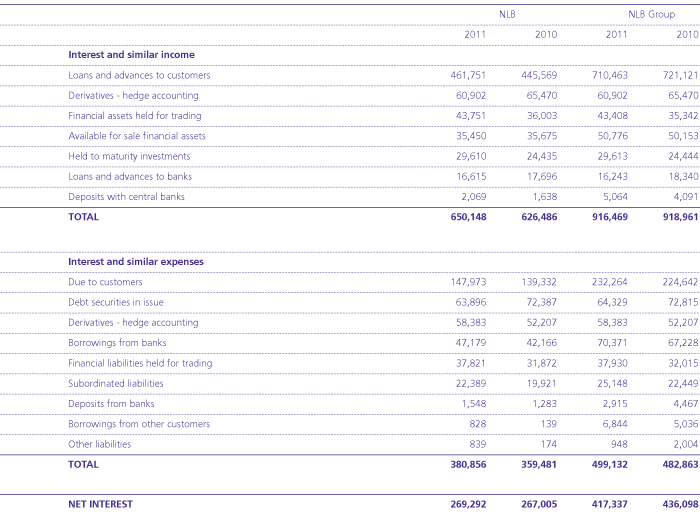
In 2011, interest income on individually impaired loans amounted to EUR 58,573 thousand for NLB (2010: EUR 33,340 thousand) and to EUR 77,600 thousand (2010: EUR 53,335 thousand) for the NLB Group.


a) Fee and commission income and expenses relating to activities of NLB and the NLB Group
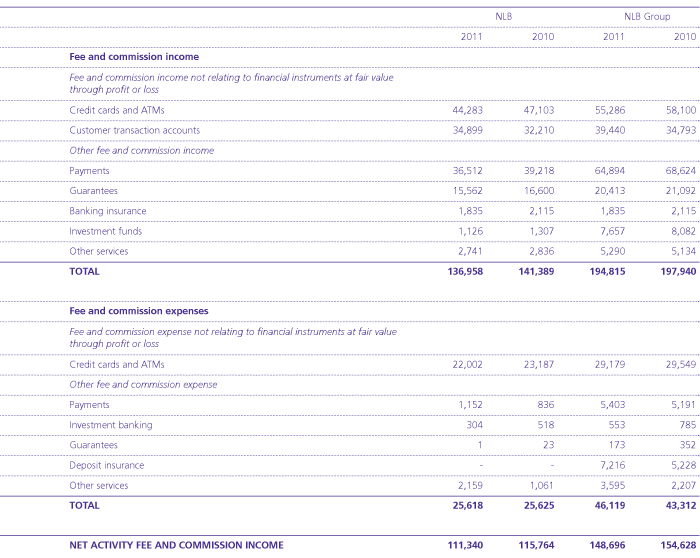
Other services include fees from non-banking deposit valuables and safe custody, other agency services and fees from purchase and sale of foreign exchange currencies.
b) Fee and commission income and expenses relating to fiduciary activities
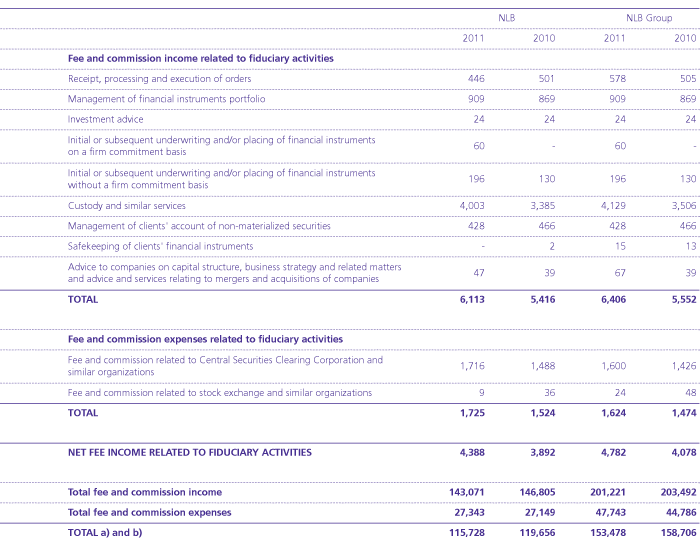
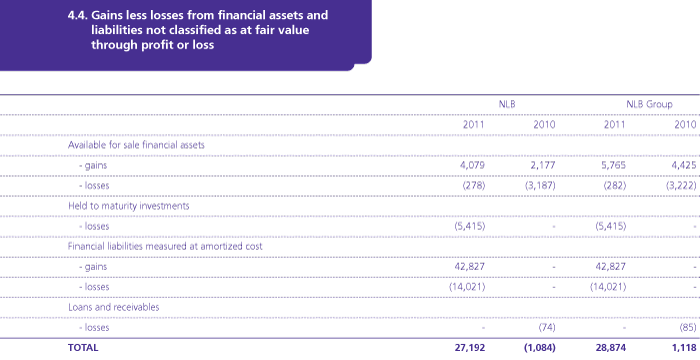
In 2010 gains less losses from available for sale financial assets of NLB Group include gain on sale of previously impaired debt instruments in amount of EUR 1,525 thousand.
Net foreign exchange translation losses on financial assets and liabilities not classified as at fair value through profit or loss amounted to EUR 2,534 thousand at NLB in 2011 (2010: net gains EUR 35,641 thousand) and to EUR 1,149 thousand in the NLB Group (2010: net gains EUR 32,505 thousand).

The NLB Group uses currency derivatives to hedge its currency exposure. Therefore, their effects need to be considered in relation to foreign exchange differences in the income statement. From a business perspective, these derivatives represent effective hedging instruments that are not accounted for using hedge accounting principles. They are accounted for in the NLB Group’s financial statements as financial instruments held for trading.

Income from non-banking services includes income from IT services and income from operating leases of movable property.
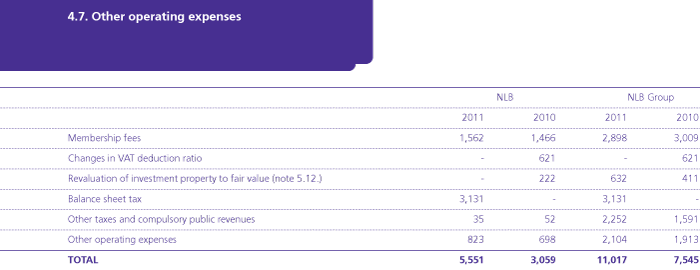
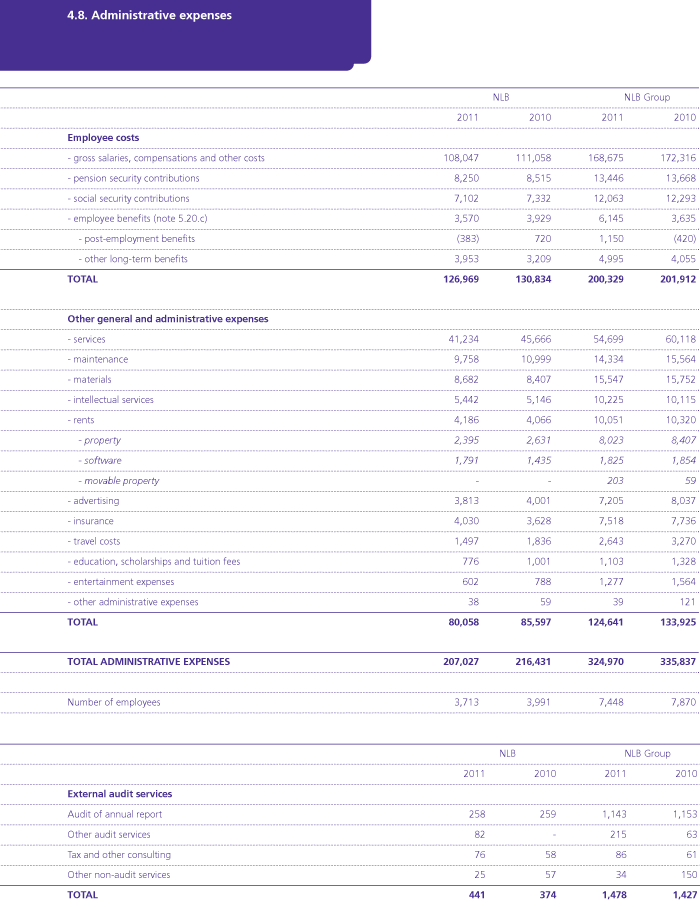
External audit services include payments to NLB’s statutory auditor in the amount of EUR 365 thousand (2010: EUR 291 thousand), while the NLB Group made payments to the auditor in the amount of EUR 1,232 thousand (2010: EUR 1,099 thousand).


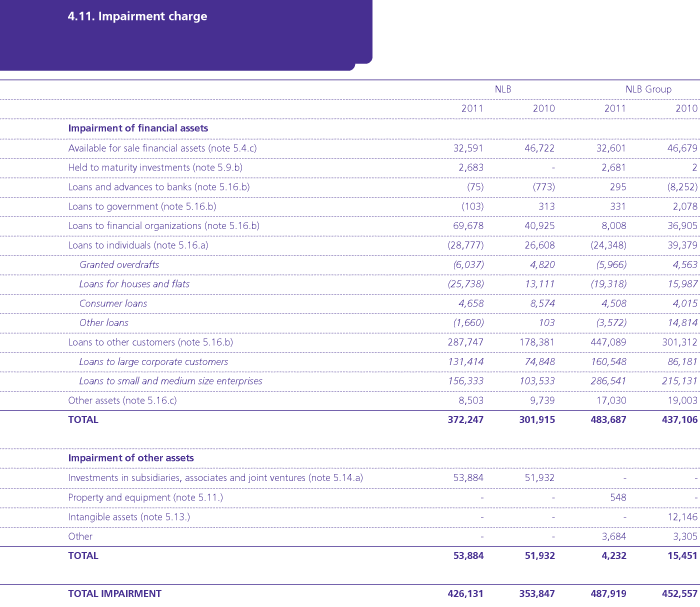
Impairment charge includes exchange differences from allowance for impairment of financial assets measured at amortized cost. In 2011 these expenses amount to EUR 783 thousand (2010: expenses EUR 822 thousand ) at NLB, while at the NLB Group expenses amount to EUR 979 thousand (2010: income EUR 3,624 thousand).

Income tax differs from the amount of tax determined applying the basic tax rate as follows:
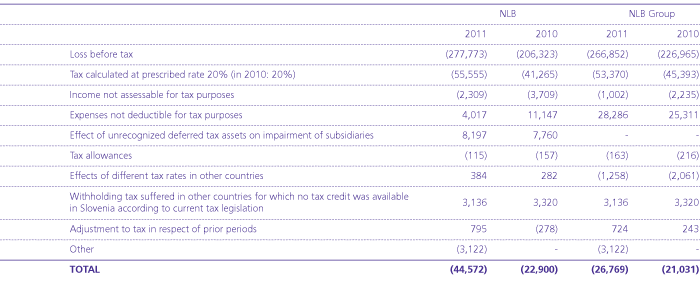
Income tax rates within the NLB Group range from 9% to 30%.
The majority of income not recognized for tax purposes relates to dividend income, which can be deducted from the taxable profit, provided that all conditions prescribed by tax legislation are met.
Deferred tax assets were not recognized on temporary differences arising on impairment of investments in subsidiaries amounting to EUR 84.37 million as of December 31, 2011 (December 31, 2010: EUR 74.67 million). The NLB Group has no intention of disposing of these subsidiaries in foreseeable future.
Other represents a deferred tax asset arising from the impairment of the investment in a subsidiary. The deferred tax asset is expected to be realised in the foreseeable future.

Basic earnings per share are calculated by dividing net profit by the weighted average number of issued ordinary shares, less treasury shares.

Subordinated loans and issued debt securities have no future conversion options. Consequently, there are no dilutive potential ordinary shares.
5. NOTES TO THE STATEMENT OF FINANCIAL POSITION

Slovenian banks are required to maintain an obligatory reserve with NLB of Slovenia, relative to the volume and structure of its customer deposits. Other banks in the NLB Group maintain an obligatory reserve in accordance with local legislation. NLB and other banks in the NLB Group fulfill their mandatory reserve deposit requirements.
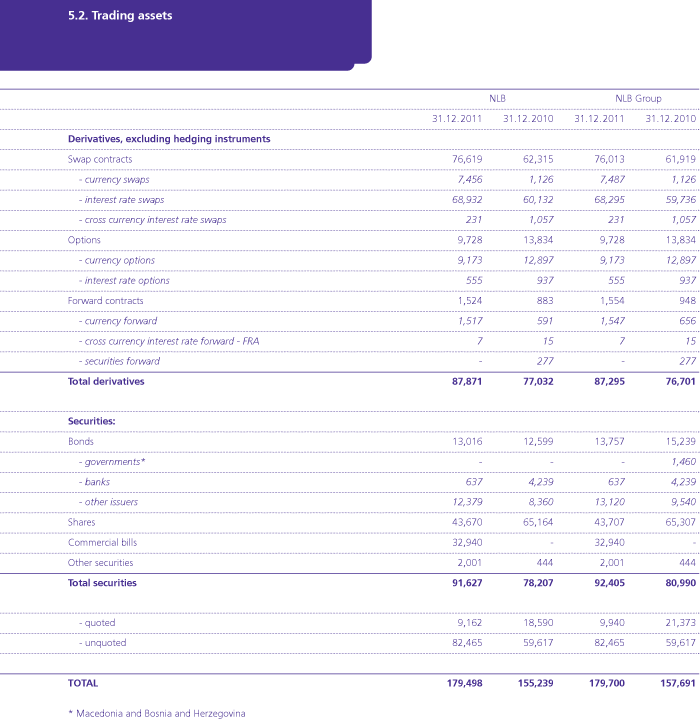
The notional amounts of derivative financial instruments are disclosed in note 5.28.d).
During the year 2009 NLB and the NLB Group reclassified certain bonds from the trading category to loans and receivables. NLB and the NLB Group reclassified high quality corporate bonds that are not traded in the market and for which it has a positive intent and ability to hold for the foreseeable future or until maturity rather than trade in the short term.
The following table illustrates the carrying values and fair values of the assets reclassified:

The effective interest rates, determined on the day the bonds were reclassified, range from 4.15% – 4.23%.


a) Financial assets designated at fair value through profit or loss

b) Financial liabilities designated at fair value through profit or loss

In NLB financial assets and liabilities in amount of EUR 2,074 thousand are designated at fair value through profit or loss, to reduce the accounting miss match that would otherwise arise. Financial liability, designated at fair value through profit or loss is the structure deposit from customers, from which the returns depend on the returns from private equity funds, classified as financial asset, measured at fair value through profit or loss.
In NLB Group, in addition to the above mentioned, financial assets that are designated at fair value through profit or loss, present investments in other funds that are managed and measured on a fair value basis.

a) Analysis by type of available for sale financial assets
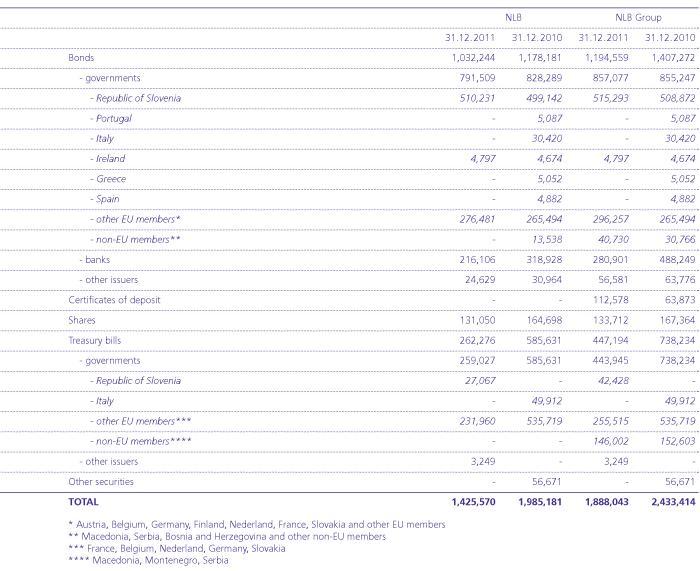
b) Pledged assets

c) Analysis of movements
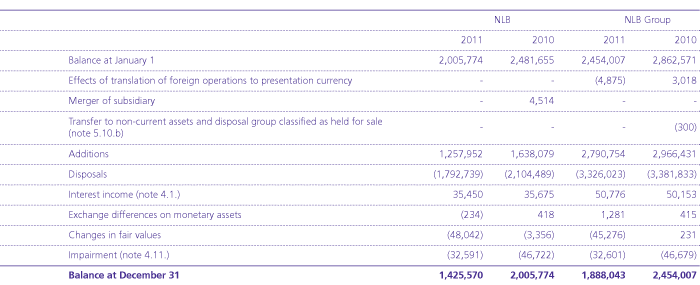
As at December 31, 2011, the value of equity instruments that the NLB and the NLB Group obtained by taking possession of collateral held as security and recognized in the statement of financial position is EUR 113,032 thousand (December 31, 2010: EUR 139,551 thousand).
Due to a decline in fair values, NLB impaired equity securities in the amount of EUR 32,591 thousand (2010: EUR 45,924 thousand), while the NLB Group impaired equity securities in the amount of EUR 32,601 thousand (2010: EUR 45,701 thousand).
As at December 31, 2011, the NLB Group includes financial investments with more than 20% interest in equity in the amount of EUR 23,733 thousand (December 31, 2010: EUR 35,418 thousand), that are not accounted for using the equity method, due to the fact, that the NLB Group does not have voting rights in general assembly's which means, that the NLB Group does not have significant influence over the company.
d) Revaluation reserve related to available for sale financial assets
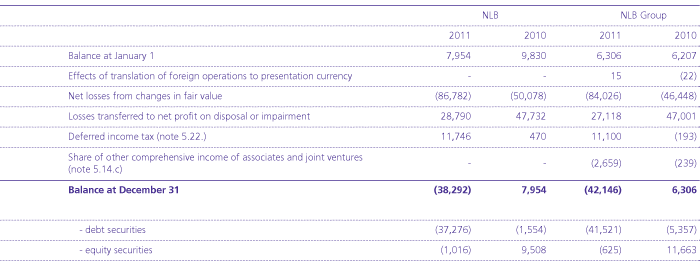

NLB Group companies measure exposure to interest rate risk using a repricing gap analysis and by calculating the sensitivity of statement of financial position and off-balance-sheet items in terms of the economic value of equity. Portfolio duration is used as a measure of risk in the management of securities in the banking book.
NLB Group companies also use various derivatives, such as interest rate swaps, forward rate agreement (FRA), overnight indexed swap (OIS) and currency interest rate swap (CIRS) to close open positions in an individual maturity bucket. Micro and macro fair value hedges are used for that purpose, i.e. the swapping of a fixed interest rate on a hedged item for a variable interest rate. Micro cash flow hedges are also used, i.e. the swapping of a variable interest rate on a hedged item for a fixed interest rate. All cash flow hedges were made on liability items, while fair value hedges were used on both liability and assets items. Hedged liability items (e.g. issued securities, government deposits, etc.) accounted for the majority in nominal terms.
Hedge accounting rules (fair value and cash flow hedging) were applied in the hedging of interest rate risk using interest rate swaps. These hedge relationships are created in such a way that the characteristics of the hedge instrument and those of the hedged item match (i.e. the principal terms match), while the dollar-offset method is used to regularly measure hedge effectiveness retrospectively. Prospective testing of hedge effectiveness is carried out regularly for macro hedges, where the characteristics of both items in the hedge relationship do not fully match, by comparing the change in the fair value of both items with the shift in the yield curve.
Hedge accounting rules were not applied in economic hedges using FRA and CIRS. Thus, the effects of valuation are disclosed in the income statement.
In accordance with hedge accounting rules, the NLB Group hedged a capital investment in a foreign subsidiary (net investment hedge) during the second half of 2011. Similar to cash flow hedging, retrospective and prospective hedge effectiveness testing is carried out regularly.
a) Fair value hedge

In 2011 net losses on hedging instruments amounted to EUR 10,777 thousand in NLB and EUR 11,710 thousand in the NLB Group (2010: net gains EUR 13,749 thousand), net gains on hedged items were in NLB EUR 11,108 thousand and in NLB Group EUR 11,947 thousand (2010: net losses EUR 12,964 thousand).
b) Cash flow hedge

Future cash flows

c) Hedge of a net investment in a foreign operation

Hedge of a net investment in a foreign operation is shown in NLB as fair value hedge, while in the NLB Group it is accounted for using the same principles as for cash flow hedge. Net gains from net investment hedge in amount of EUR 94 thousand are in NLB included in income statement in line fair value adjustments in hedge accounting, while in the NLB Group in other comprehensive income.
d) Revaluation reserve related to cash flow hedging

There was no hedge ineffectiveness that neither NLB nor the NLB Group should have recognized in the income statement.

IFRS 7 specifies a fair value hierarchy with a respect to the inputs and assumptions used to measure financial instruments at fair value. Observable inputs reflect market data obtained from independent sources, while unobservable inputs reflect the assumption of NLB and the NLB Group. The fair value hierarchy comprises the following levels:
- Level 1 – Quoted prices (unadjusted) on active markets. This level includes listed equity securities, debt instruments, financial derivatives and units of investment funds.
- Level 2 – Inputs other than the quoted prices included in Level 1 that are observable for an instrument, either directly (i.e. prices) or indirectly (i.e. derived from prices). The source of input parameters, such as yield curves and counterparty credit ratings, is Reuters.
- Level 3 – Inputs for an instrument that are not based on observable market data. This level includes non-tradable shares and bonds and derivatives associated with these investments.
This hierarchy requires the use of observable market data when available. The NLB Group considers relevant and observable market prices in its valuations where possible.
a) Financial instruments, measured at fair value in the financial statements
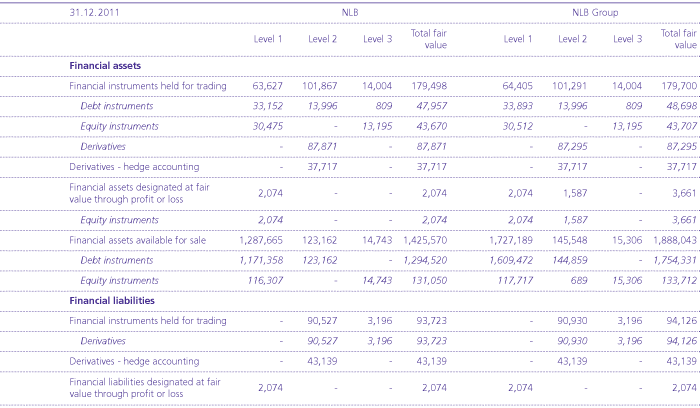
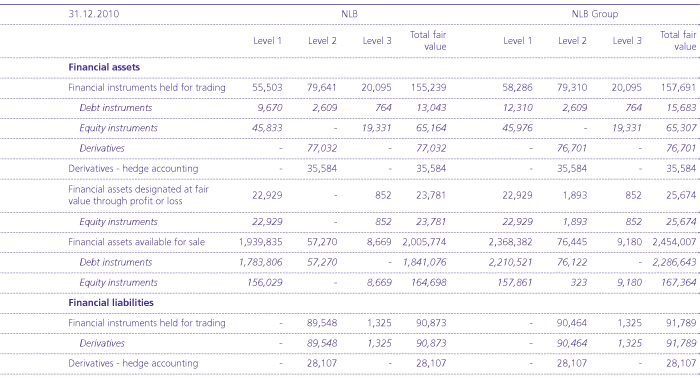
b) Significant transfer of financial instruments between levels of valuation

Available for sale financial instruments reclassified from Level 1 ceased to be traded on an active market in June 2011 due to deteriorating liquidity on the financial markets, and were reported as Level 2 instruments in the above analysis as at December 31, 2011. For the same reason, available for sale financial instruments in amount of EUR 172,035 thousand and financial instruments held for trading in amount of EUR 5,721 thousand were reclassified in 2010 out of Level 1 and were reported as Level 2 instruments as at December 31 2010.
In August 2011, financial instruments held for trading were quoted on stock exchanged and were, therefore, reclassified from Level 3 and reported as Level 1 instruments in the above analysis as at December 2011.

c) Financial instruments in 3rd level regarding the fair value hierarchy
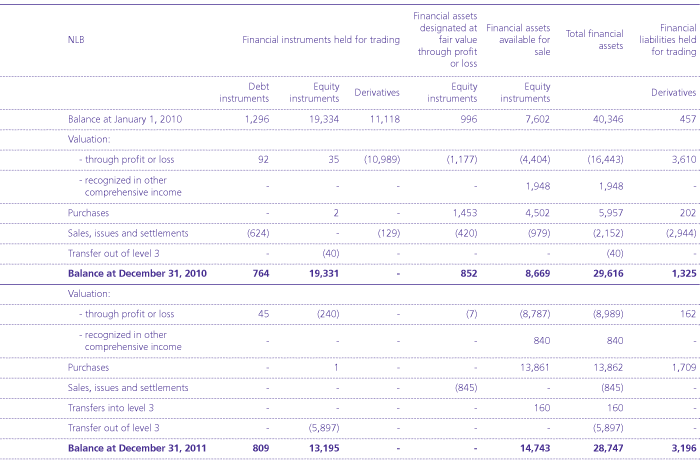
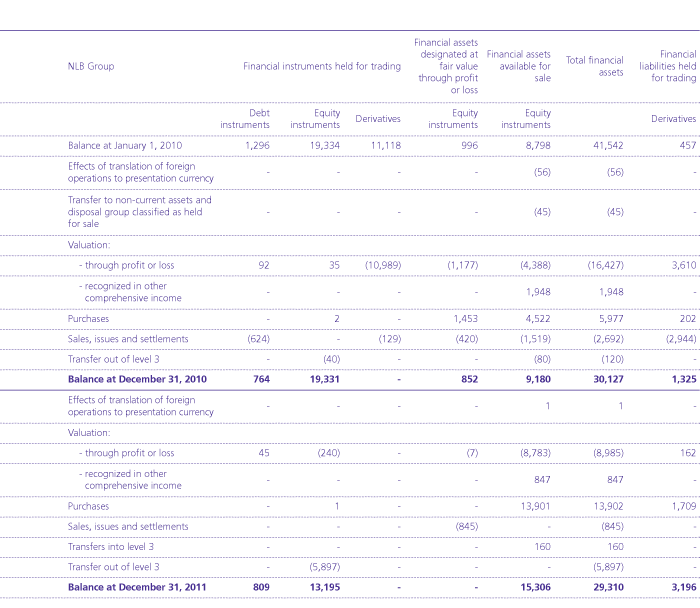
In year 2011 the NLB Group recognized the following effects for financial instruments that are in Level 3 as at December 31, 2011:
- for financial instruments measured at fair value through profit or loss, a positive valuation in the amount of EUR 45 thousand (December 31, 2010: EUR 1,092 thousand), recognized in income statement; and
- for available for sale financial instrument, a valuation loss in the amount of EUR 8,787 thousand (December 31, 2010: EUR 3,957 thousand) and positive valuation in the amount of EUR 840 thousand (December 31, 2010: EUR 1,948 thousand) recognized in other comprehensive income.
The sensitivity to valuation assumptions disclosed in the table below represents by how much fair value for equity instruments in 3rd level, regarding the fair value hierarchy would increase or decrease had management used reasonably possible alternative valuation assumptions that are not based on observable market data.
Free cash flow method

Comparable Companies Market Multiples Method


Analysis by type of advance
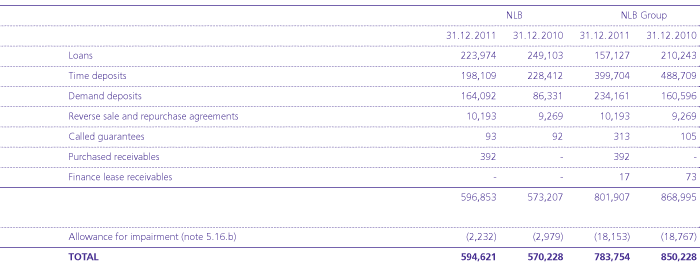
The NLB Group records securities received under repurchase agreements as a collateral in its off-balance sheet (it becomes the legal owner of said securities), while the borrower is entitled to the associated coupon interest and dividends. The NLB Group did not sell or pledge any of the securities it received as collateral during the financial years presented. The fair value of these securities amounted to EUR 10,046 thousand (December 31, 2010: EUR 9,280 thousand).

a) Analysis by type of advance
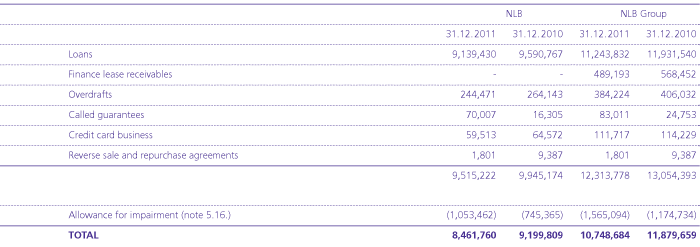
The NLB Group records securities received under repurchase agreements as collateral in its off-balance sheet (it becomes the legal owner of said securities), while the borrower is entitled to the associated coupon interest and dividends. The NLB Group did not sell or pledge any of the securities it received as collateral during the financial years presented. The fair value of these securities amounted to EUR 1,990 thousand (December 31, 2010: EUR 6,253 thousand).
b) Analysis by sector

c) Finance leases
Loans and advances to customers in the NLB Group include finance lease receivables:
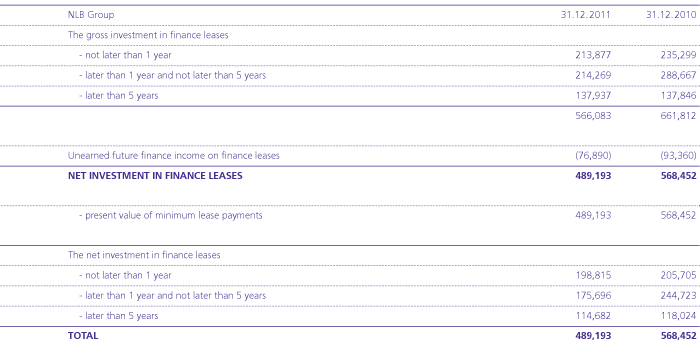
The allowance for unrecoverable finance lease receivables included in the provision for loan losses amounted to EUR 83,842 thousand (December 31, 2010: EUR 60,317 thousand).
Finance and operating lease transactions are carried out by the NLB Group through specialized subsidiaries that offer a wide range of financing such as car leasing, real estate leasing, leasing of commercial and production equipment and others.
The majority of the lease agreements entered into by NLB Group as lessor contracts are finance lease agreements (operating leases account for less than 10% of all lease agreements). The majority of agreements are concluded for a non-cancellable period of between 48 and 60 months, with an unguaranteed residual value representing a purchase option typically between 1.6% and 2% of the gross investment.
Finance and operating leases of motor vehicles and operating leases of business premises represent the majority of agreements in which the NLB Group act as lessee.

a) Analysis by type of held to maturity investments
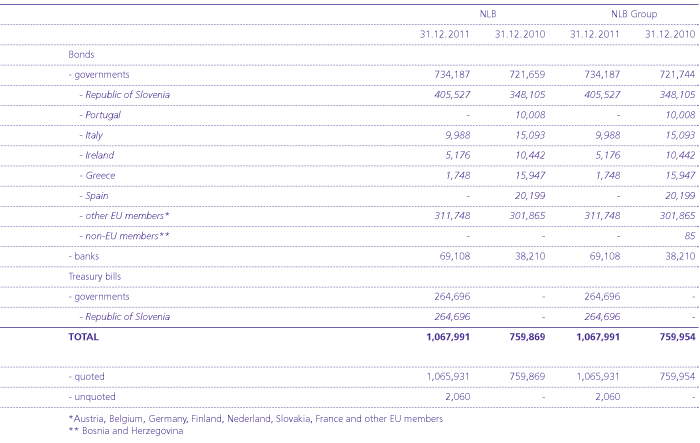
b) Analysis of movements

In 2011 the bank decreased the exposure from souvenir debt securities to Greece, Portugal, Spain and Ireland with a sale prior to maturity due to a significant deterioration of the credit worthiness of the issuers.

a) Analysis by type of non-current assets and disposal group classified as held for sale

Non-current assets held for sale include business premises and apartments that are in the process of sale.
In 2010, NLB reclassified a capital investment in NLB Bank Sofia, Sofia to non-current assets held for sale. Prior to reclassification, the investment was impaired to fair value less costs to sell in the amount of EUR 9,045 thousand. In July 2011 the NLB Group sold 97.01% of interest in this subsidiary to a third party. When the investment was sold, NLB realized a further loss in the amount of EUR 1,570 thousand. Prior to disposal the NLB Bank Sofia, Sofia was included in the segment Foreign non-strategic markets (note 8.1.a).
b) Major classes of disposal group
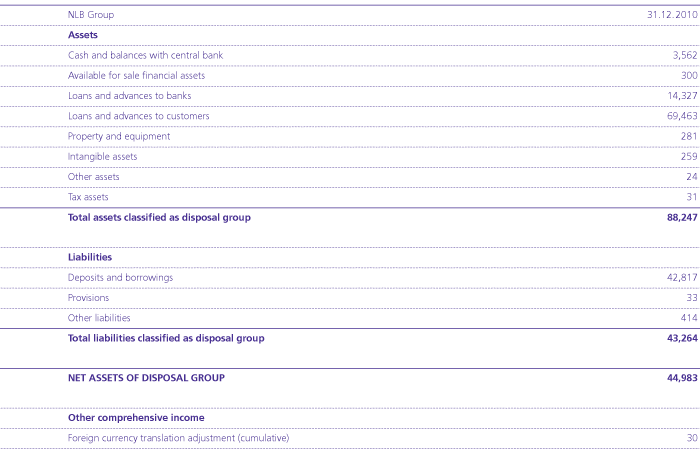
As at December 31, 2010 the total amount of loans and advances to banks has original maturity up to three months and is included within cash equivalents.
Notes 7.1. as at December 31, 2010 include also the data of NLB Bank Sofia, Sofia.
c) Disposal of subsidiary
The details of the assets and liabilities at the date of disposal and disposal consideration is as follows:

d) Analysis of movements
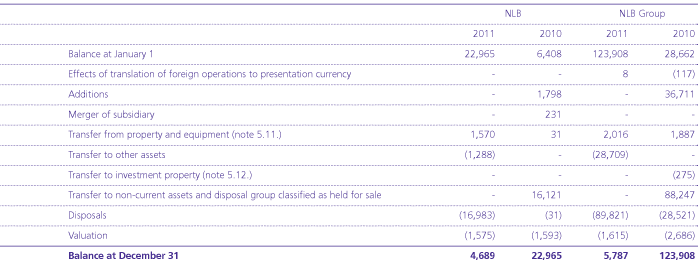
In 2011 the NLB Group has reclassified repossessed assets from non-current assets held for sale to other assets (note 5.15).
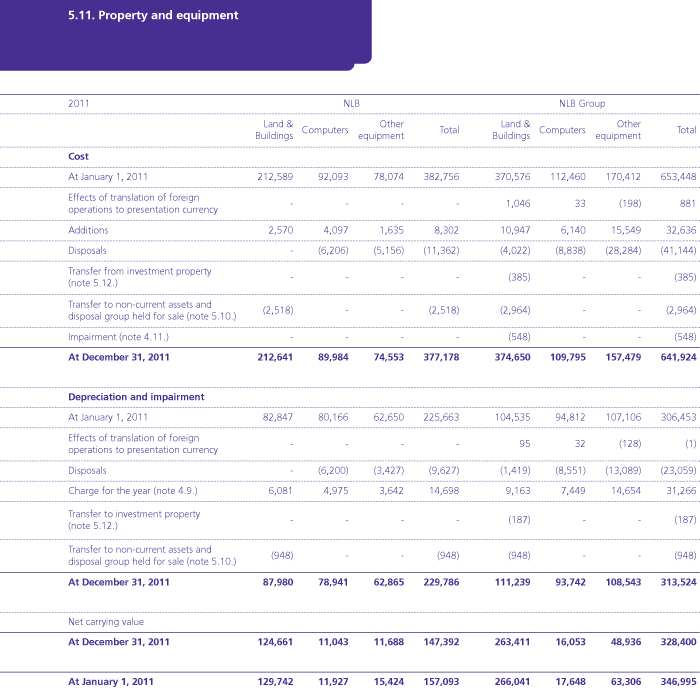
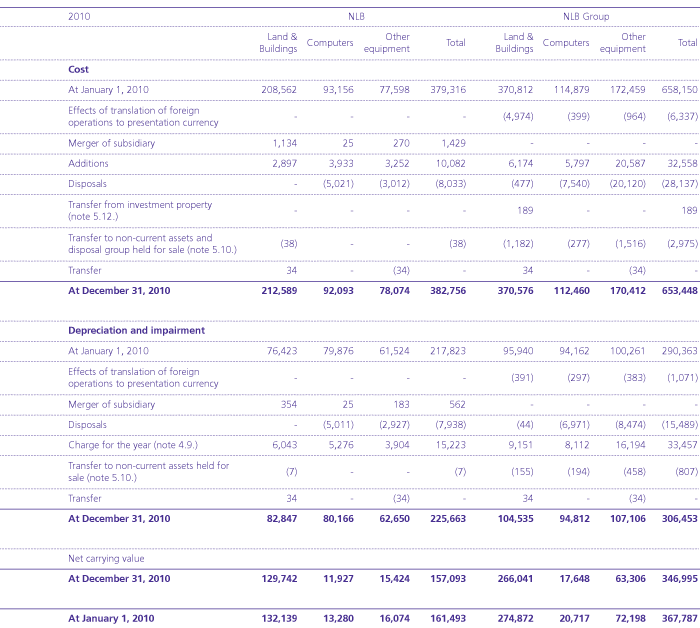
Assets leased under finance leases in the NLB Group as at December 31, 2011 amounted to EUR 64 thousand for motor vehicles (December 31, 2010: EUR 121 thousand), EUR 1,198 thousand for land (December 31, 2010: EUR 1,179 thousand) and EUR nil for other equipment (December 31, 2010: EUR 17 thousand). NLB has no assets held under finance leases as at December 31, 2011 and December 31, 2010.
The value of assets received by taking possession of collateral and included in property and equipment by NLB and NLB Group amounted to EUR 7 thousand (December 31, 2010: EUR 7 thousand).
The net carrying value of assets leased out by the NLB Group under operating leases was EUR 20,572 thousand as at December 31, 2011 (December 31, 2010: EUR 28,471 thousand). Majority of assets (December 31, 2011: 78.4%, December 31, 2010: 82.0%) leased out relates to motor vehicles.
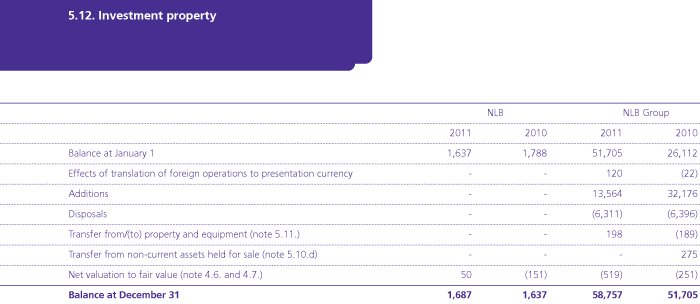
The NLB Group has no interests in properties held under operating leases that should be classified and accounted for as investment property. The NLB Group disclosed operating expenses arising from investment properties leased to others in amount of EUR 112 thousand in its 2011 income statement (2010: EUR 78 thousand).
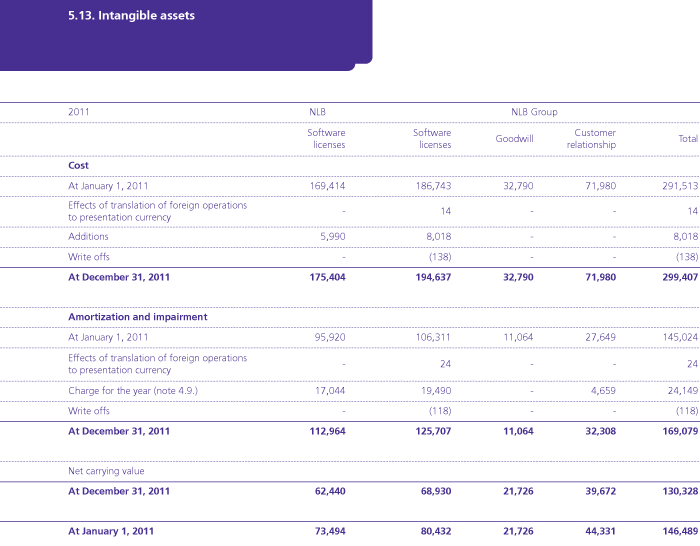
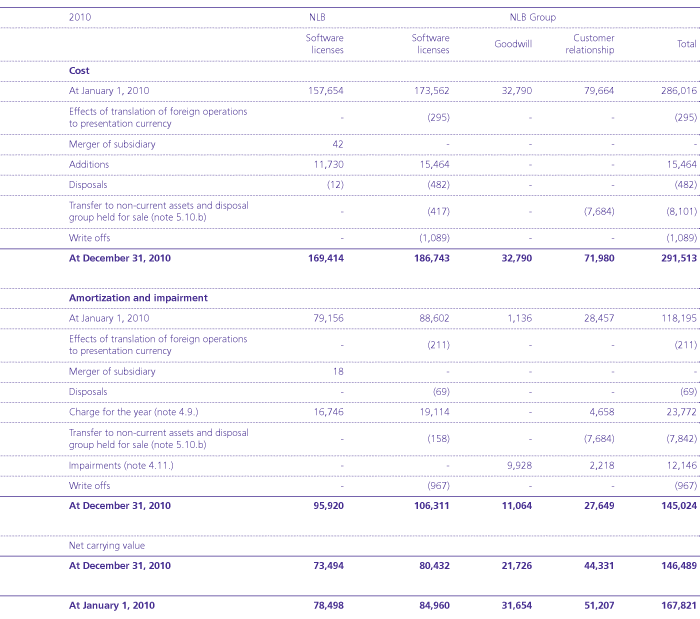
In 2011, the NLB Group did not impair any goodwill or additionally identified intangible assets (eg. customer relationship) as the impairment test showed no signs for possible impairments. In 2010 the impairment of goodwill was EUR 9,928 thousand and impairment of additionally identified intangible assets in the amount of EUR 2,218 thousand. Impairments were primarily the result of lower recoverable amounts of investments, as well as lower profitability of identified customer relationships.
The recoverable amounts of the cash-generating units, which include the test of the impairment of goodwill, were based on a value in use calculation, including the following assumptions that represent the past experience:
- a five-year financial plan approved by the Management and Supervisory Boards;
- growth in cash flows for residual period in the amount of 2%;
- a pre-tax discount rate of between 11% and 13% and
- target capital adequacy ratios of an individual bank of between 13% to 17%.

a) Analysis by type of investment in subsidiaries

As at December 31, 2011 NLB, pursuant to the requirements of IFRS and its internal methodology, calculated the recoverable amount of each investment. In 2011 NLB recognized an impairment loss in the amount of EUR 53,884 thousand (note 4.11). Impaired investments in NLB Leasing, Ljubljana, NLB Leasing Maribor, Maribor, NLB Leasing, Sarajevo, NLB Factoring, Ostrava, NLB Factor, Bratislava, NLB Srbija, Beograd and LHB Internationale Handelsbank, Frankfurt are included in segment Non-strategic markets and activities.
In 2010 NLB recognized an impairment loss in the amount of EUR 51,932 thousand (note 4.11). Impaired investment in CBS Invest, Sarajevo is included in segment Foreign strategic markets, impaired investments in NLB Leasing, Ljubljana, NLB Leasing Maribor, Maribor, NLB Factoring, Ostrava, NLB Factor, Bratislava, NLB Nova penzija, Beograd, NLB Banka Sofia, Sofija and NLB banka, Beograd are included in segment Non-strategic markets and activities.
The recoverable amount of the cash-generating unit was based on a value in use calculation, including the following assumptions that represent the past experience:
- a five-year financial plan approved by the Management and Supervisory Boards;
- growth in cash flows for residual period in the amount of 2%;
- a pre-tax discount rate of between 11% and 13% and
- target capital adequacy ratios of an individual bank of between 13% to 17%.
The financial plans of individual companies are based on past experiences and an assessment of future economic conditions that will impact an individual bank’s operations and the quality of its credit portfolio. The discount rates used are based on an assessment of the general and specific risks to which an individual bank’s operations are exposed. The discount rates are calculated on the basis of the CAPM model. Majority of impact relates to effects derived from financial crisis, larger impairment provisions, lower interest rates margins, large decline in GDP for Balkans region and change in capital regulation which requires additional capital increases.
Subsidiaries as at December 31, 2011 comprised:
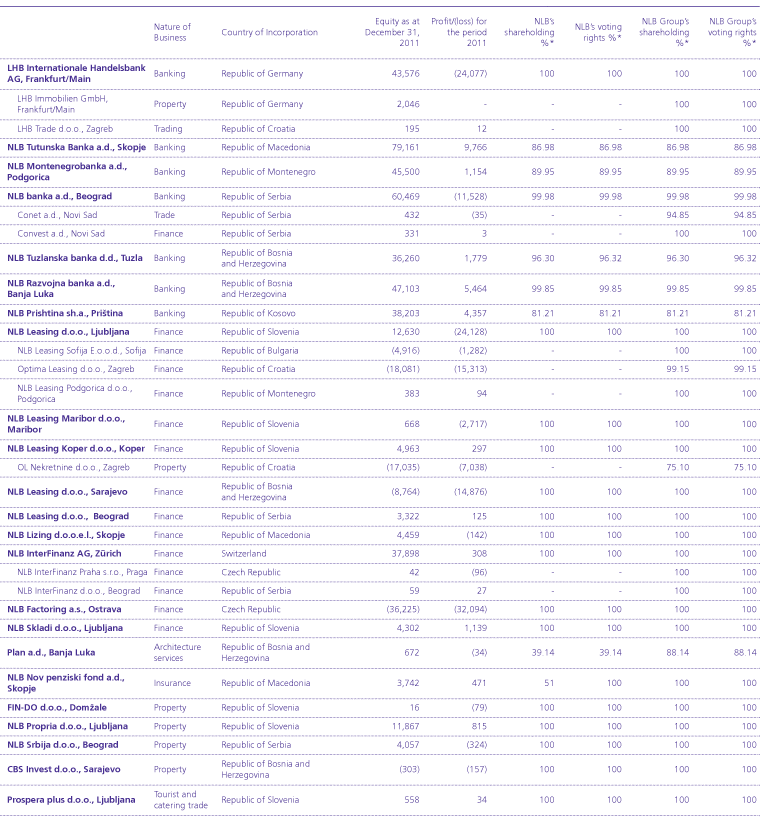
Subsidiaries as at December 31, 2010 comprised:
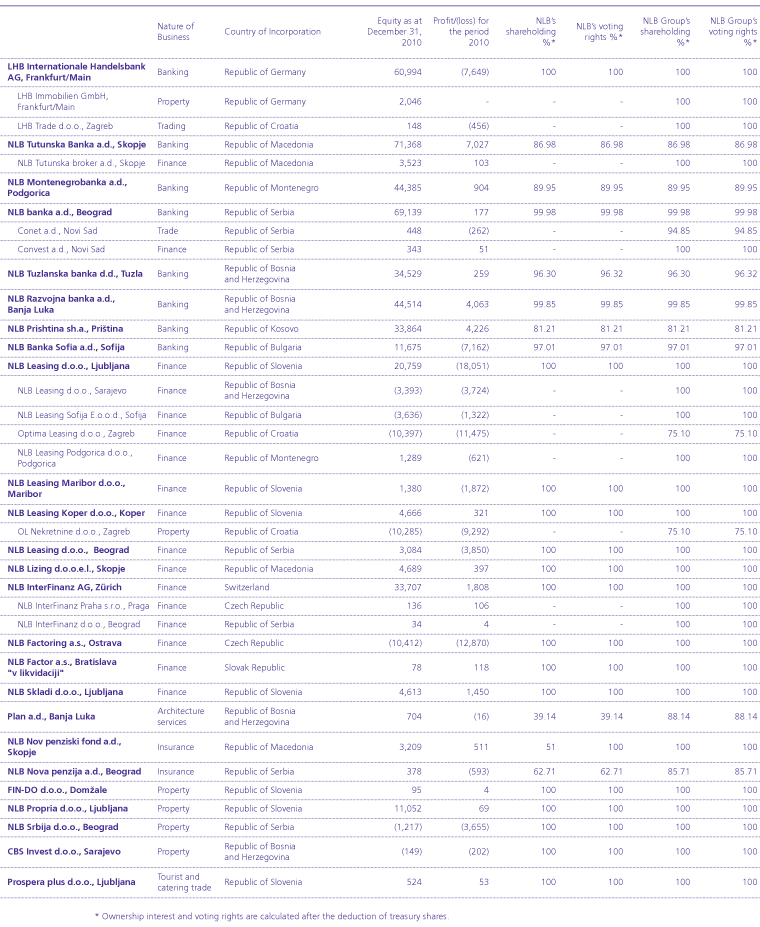
b) Analysis by type of investment in associates and joint ventures

Associates as at December 31, 2011 comprised:

Associates as at December 31, 2010 comprised:

Joint ventures as at December 31, 2011 comprised:

Joint ventures as at December 31, 2010 comprised:

c) Movements of investments in associates and joint ventures


Analysis by type of assets
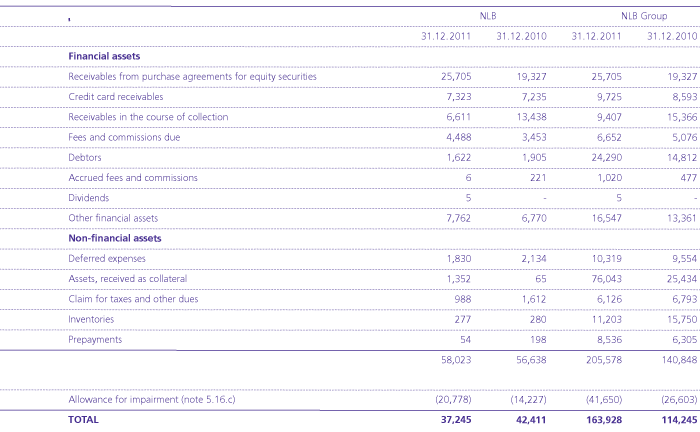
Receivables in the course of collection are temporary balances which, owing to the functionality of the information support system, are transferred to the appropriate item in the days following their occurrence.

a) Loans and advances to individuals
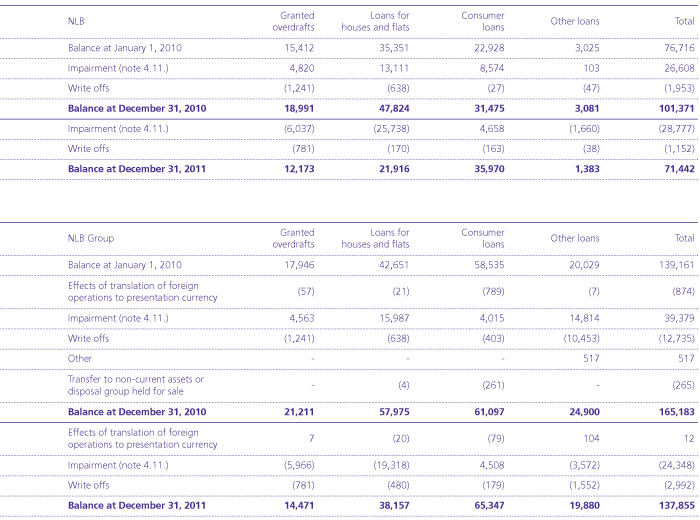
b) Loans and advances to legal entities
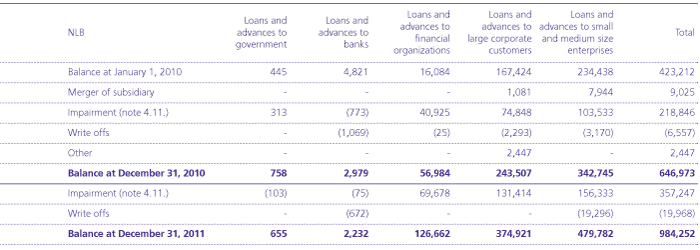
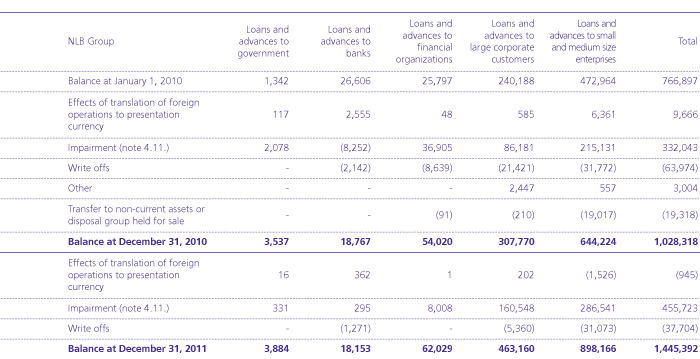
c) Other financial assets

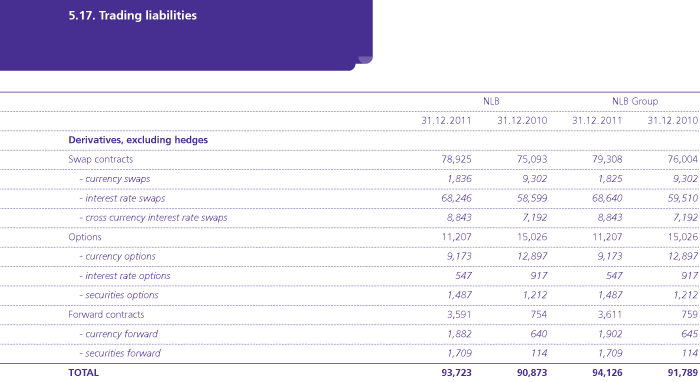
The notional amounts of derivative financial instruments are disclosed in note 5.28.d).

a) Deposits from banks and amounts due to customers

b) Borrowings from banks and other customers

c) Pledged assets and associated liabilities

In 2010 the NLB Group sold some available for sale financial assets under sale and repurchase agreements (repos). Although the NLB Group was no longer legal owner of these securities it retained the risks and rewards of ownership. The NLB Group was entitled to all coupon interest and potential dividends. Therefore these securities were included in the NLB Group’s financial statements as at December 31, 2010 and the counterparty liabilities were presented as financial liabilities associated with the transferred assets.
d) Debt securities in issue
Debt securities issued by NLB relate to issued bonds and are denominated in EUR. Of these, 93.66% bear fixed interest rates (December 31, 2010: 94.09%), while 6.34% bear floating interest rates (December 31, 2010: 5.91%). All issued bonds with a carrying amount of EUR 1,234,987 thousand (December 31, 2010: EUR 1,793,520 thousand) were traded on active markets as at December 31, 2011.
Debt securities issued by the NLB Group relate to issued bonds and are all denominated in EUR. Of these, 93.65% bear fixed interest rates (December 31, 2010: 93.56%), while 6.35% bear floating interest rates (December 31, 2010: 6.44%). All issued securities with a carrying amount of EUR 1,232,934 thousand were traded on active markets as at December 31, 2011 (December 31, 2010: EUR 1,791,329 thousand were traded on active markets, EUR 12,633 thousand were not traded on active markets).
In 2011, NLB made an early repurchase of bonds in the nominal amount of EUR 495,726 thousand. The effects are included in the income statement as losses from financial assets and liabilities not classified at fair value through profit or loss.
During the years presented there were no defaults on the securities in issue.
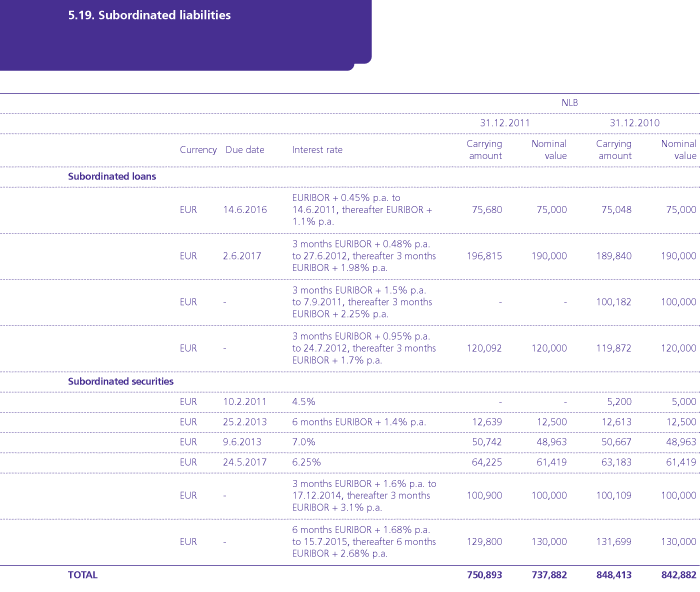
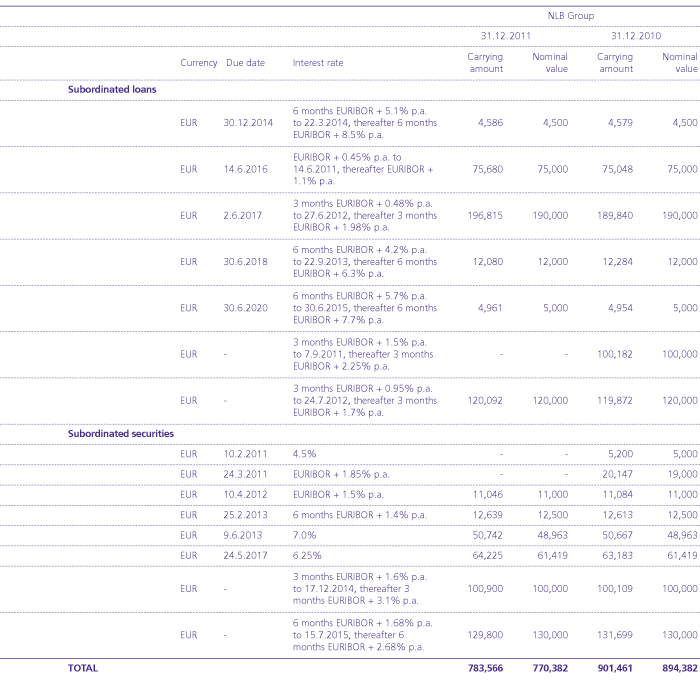
In 2011, NLB made an early repurchase of subordinated loan in the nominal amount of EUR 100 million. The effects are disclosed in the income statement as losses on financial assets and liabilities not classified at fair value through profit or loss.
In 2011 NLB recalculated the amortized costs of subordinated loans of nominal amount of EUR 190,000 thousand and EUR 75,000 thousand and subordinated securities in nominal amount of EUR 130,000 thousand as a result of a change in expected future cash flows. The aforementioned recalculation resulted in higher amortized costs for subordinated loans in the amount of EUR 7,434 thousand and lower amortized costs for subordinated securities in amount of EUR 1,184 thousand. The effects are disclosed in the income statement as losses on financial assets and liabilities not classified at fair value through profit or loss.
In accordance with the Regulation on the Calculation of the Capital of Banks and Savings Banks, a subordinated loan in the amount of EUR 130 million is included in the NLB Group’s Tier I capital as at December 31, 2011. All other subordinated loans and issued securities are included in the NLB Group’s Tier II capital. Subordinated liabilities do not contain any provisions for conversion to capital or any other liabilities. During the years presented, there were no defaults on subordinated liabilities.

a) Analysis by type of provisions

b) Movements in provisions for guarantees and commitments

c) Movements in employee benefit provisions
Post-employment benefits

Other employee benefits

Other employee benefits include the NLB Group’s obligations for jubilee long-service benefits and unused annual leave.
d) Movements in provisions for premiums from National Housing Saving Scheme

According to the covenants of the National Housing Saving Scheme, the Housing Fund of the Republic of Slovenia was required in previous years to contribute one monthly premium per year for all depositors included in the scheme. NLB is required to refund the invested premiums to the Housing Fund for all depositors that decide not to raise a loan after the conclusion of the scheme. NLB has created provisions for the expected amount of such premiums.
e) Movements in restructuring provisions

Cash flows associated with the restructuring provisions are expected in 2012 and 2013.
f) Movements in other provisions

Other provisions in NLB in amount of EUR 2,758 thousand (December 31, 2010: EUR 2,833 thousand) relate to claims for additional interest relating to retail savings and deposits

a) Analysis by type of deferred income taxes
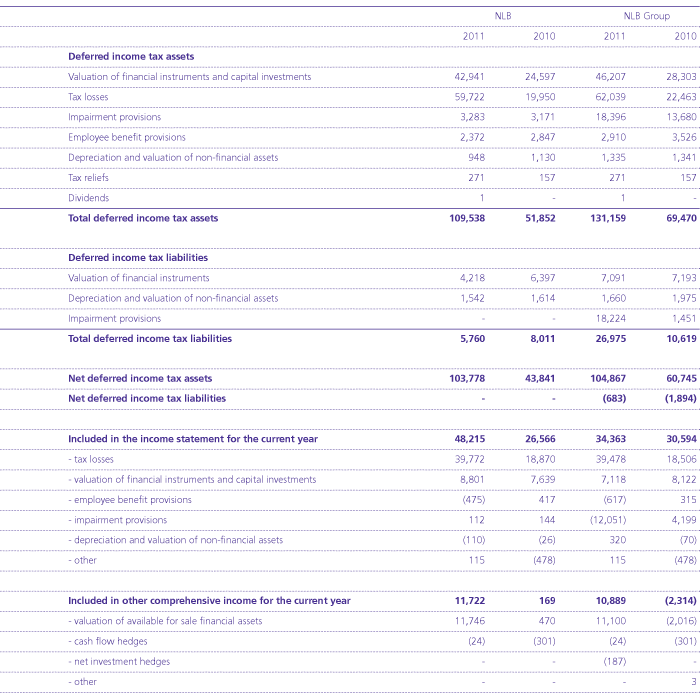
b) Movements in deferred income taxes
Deferred income tax assets
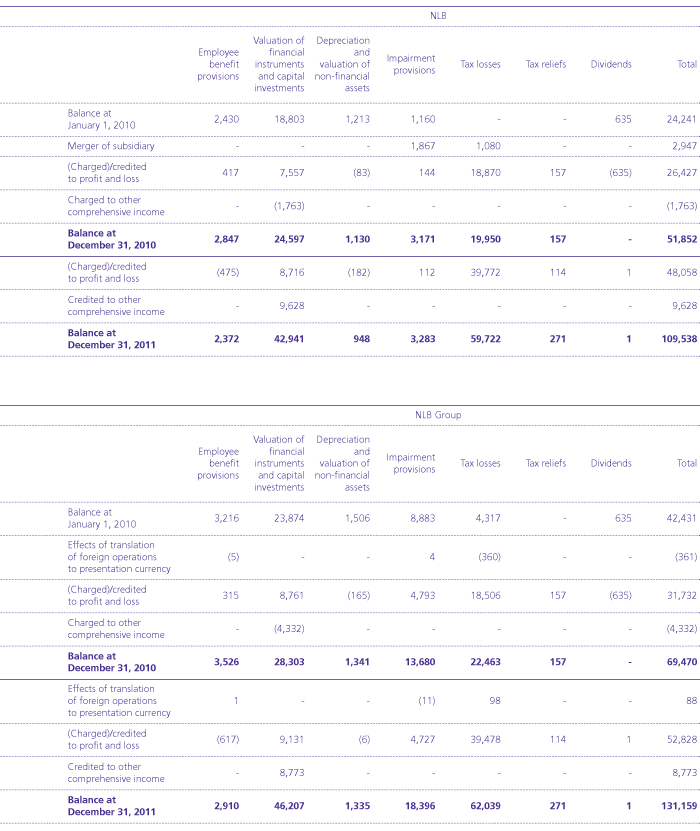
Deferred income tax liabilities
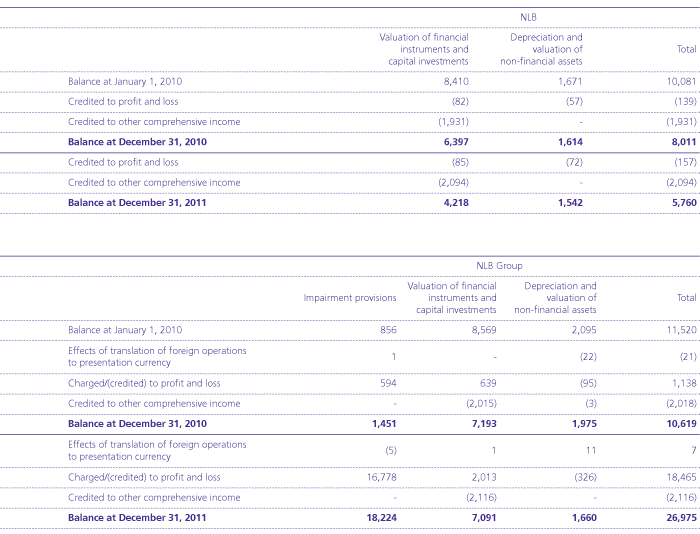
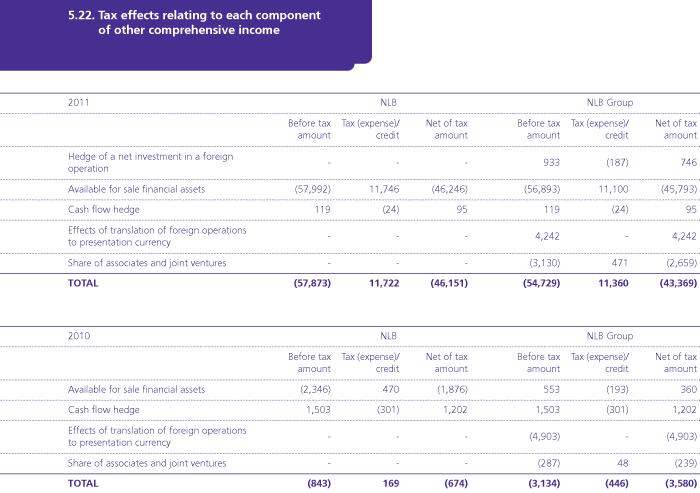

Analysis by type of other liabilities
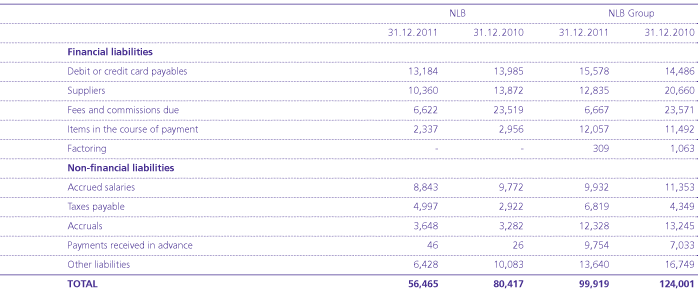

In March 2011 NLB increased capital in the amount of EUR 250,000 thousand. Share capital increased for EUR 17,986 thousand and share premium for EUR 232,014 thousand. As at December 31, 2011 NLB’s share capital amounted to EUR 92,314 thousand (December 31, 2010: EUR 74,328 thousand), and is divided into 11,061,125 ordinary shares (December 31, 2010: 8,905,952).
All shares are ordinary, freely transferable no-par value shares, with voting rights, issued in non-material form and registered in the accounts of shareholders at the Central Securities Clearing Corporation. All shares are of the same class and subscribed and paid up. Shareholders have the right to participate in the governance of NLB, to receive dividends, and they are entitled to an appropriate portion of assets in the event of the winding-up of NLB, as determined by law. All shares are paid-up in full.
As at December 31, 2011 there were 1,990 shareholders (December 31, 2010: 2,002) of which 272 are legal entities, 1,696 are individuals and 22 are non–residents. Compared to year-end 2010 the number of shareholders has decreased by 12. One share is held by NLB’s subsidiary (December 31, 2010: 1 share). NLB has 34,924 treasury shares, for which it has created reserves in the amount of EUR 2,048 thousand.
The book value of a NLB share as at December 31, 2011 was EUR 86.8 (December 31, 2010: EUR 111.2) and on a consolidated level it was EUR 88.5 (December 31, 2010: EUR 114.0). It is calculated as relation between net assets book value and the number of shares without treasury shares.
Pursuant to the decision of the annual General Meeting, NLB did not pay a dividend for 2010 during 2011 (2010: EUR nil).

The share premium comprises paid-up premiums in the amount of EUR 678,398 thousand (December 31, 2010: EUR 446,390 thousand) and the revaluation of share capital from previous years in the amount of EUR 49,205 thousand (December 31, 2010: EUR 49,205 thousand). The share premium is not distributable.
Profit reserves in the amount of EUR 180,248 thousand (December 31, 2010: EUR 413,448 thousand) comprise retained earnings that were transferred to reserves in accordance with the decision of NLB’s Annual General Meeting and cannot be distributed in the form of dividends.
NLB recorded a net loss in the amount of EUR 233,201 thousand (2010: net loss EUR 183,423 thousand), and thus no distributable profit is available for 2011.
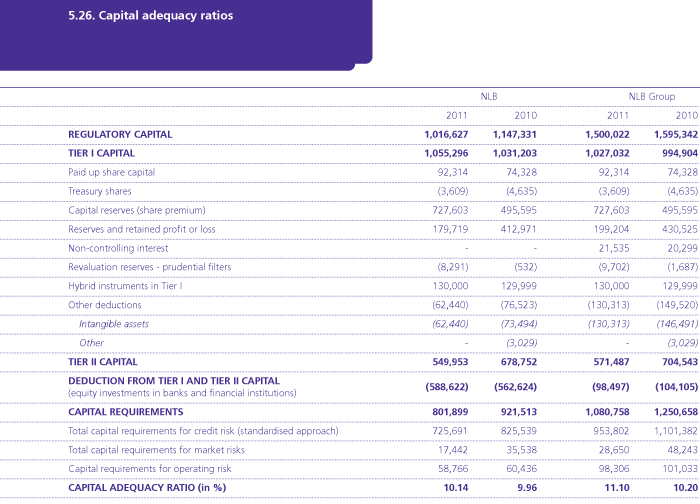
Capital adequacy and capital are monitored in conformity with the guidelines developed by the Basel Committee and European Community Directives, as implemented by the Bank of Slovenia. The required information on capital adequacy is filed with the Bank of Slovenia on a quarterly basis. The Bank of Slovenia requires each bank and banking group to maintain capital adequacy ratio at or above 8%. In the year 2011 and 2010, NLB and the NLB Group complied with the requirements of the capital adequacy regulation.
Capital adequacy calculations for the NLB Group are based upon the consolidated financial reports, prepared in line with the Regulation on the supervision of banks and savings banks on a consolidated basis, which differs from the consolidation made in line with IFRS. According to IFRS, all the group’s subsidiaries, associates and joint ventures are included in consolidated financial statements: subsidiaries using the full consolidation method whereas associates and joint ventures using the equity method.
According to the Regulation on the supervision on a consolidated basis, insurance companies and pension funds are completely excluded from the consolidated financial reports (in case of NLB Group, these companies are: NLB Nov penziski fond, Skopje, Skupna pokojninska družba, Ljubljana and NLB Vita, Ljubljana. Furthermore, joint ventures (in case of NLB Group: Prvi Faktor Group, Ljubljana) are included in consolidated reports using the proportional method of consolidation.
The characteristics of each capital component are described in the Regulation on the calculation of own funds of banks and savings banks (Ur.l.RS 85/2010, 97/2010 and 100/11). Tier II capital includes hybrid instruments (Tier I eligible instruments that exceed the limitation for inclusion in Tier I capital, as well as Tier II eligible instruments), subordinated debt and revaluation reserve from available for sale securities and from investment property. The extent of subordinated debt included in Tier II capital is gradually decreasing with a 20% reduction in each of the last five years before maturity.
On December 31, 2010, Regulation on the calculation of own funds of banks and savings banks came into force, introducing more restrictive policy regarding inclusion of hybrid (innovative) instruments in Tier I capital. Existing innovative instrument issued by NLB does not fulfil new demands for inclusion in Tier I and was classified as “grandfathered hybrid instrument”. Therefore, the instrument can be further included in Tier I capital: up to 15% of Tier I capital until year 2030 (same treatment as under previous regulation) and up to 10% of Tier I capital until year 2040; after year 2040 inclusion is no longer allowed.
In 2011, NLB participated in the pan-European stress test conducted by the European Banking Authority (EBA), in cooperation with national supervisory bodies (locally, the Bank of Slovenia), the European Central Bank (ECB), the European Commission (EC) and the European Systemic Risk Board (ESRB). Testing was carried out on the basis of the EBA's common methodology and key common assumptions. The test was used to assess the core Tier 1 capital adequacy ratio of an individual bank.
Taking into account the prescribed methodology and the requirement for a core Tier I ratio of 9%, the calculation showed that NLB had a capital deficit of EUR 320 million as at September 30, 2011, which it must rectify by the end of June 2012. The aforementioned deficit is covered by the additional capital increase proposed by the Bank's Management Board and Supervisory Board. If the capital increase is not carried out by the prescribed deadline, NLB will make use of other measures in the scope of agreed mechanisms at the EU level.
Regardless of the above mentioned, NLB has begun selling off its investments on non-strategic markets and activities. The expected result of these measures is organizational and financial consolidation, and the strengthening of the NLB Group's capital, which will facilitate increased focus on the markets and activities that proved most profitable and prospective in the past. NLB continues to search for synergies, to consolidate and to rationalize the operations of the NLB Group companies on these markets. A great deal of emphasis is placed on the further development of corporate governance, in particular through the continuation of the process of harmonizing business standards started in the past, and the transfer of know-how and best practices within the Group according to the "business line" system.

NLB has a branch in Trieste with total assets amounting to EUR 109,647 thousand as at December 31, 2011 (December 31, 2010: EUR 155,180 thousand) and net profit for 2011 of EUR 83 thousand (2010: EUR 124 thousand).

a) Contingent liabilities and commitments
Documentary (and standby) letters of credit constitute a written and irrevocable commitment of the issuing (opening) bank, on behalf of the issuer (importer) to pay the beneficiary (exporter) the value set out in the documents by a defined deadline:
- if the letter of credit is payable on sight; and
- if the letter of credit provides for deferred payment – to be paid at maturity, provided that the beneficiary (exporter) presents NLB documents that are in line with the conditions and deadlines set out in the letter of credit.
A commitment may also take the form of a letter of credit confirmation, which is usually done at the request or authorization of the issuing (opening) bank and constitutes a firm commitment by the confirming bank, in addition to that of the issuing bank, which independently assumes a commitment to the beneficiary under certain conditions.
b) Contractual amounts of off-balance sheet financial instruments
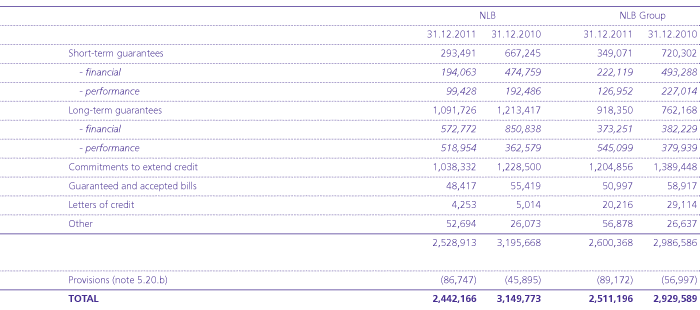
Commitments to extend loans can be realized within one year. The NLB Group has no financial guarantees, for which the first possible payment date would be later than within one year.
c) Movement of called performance guarantees

Fee income from all issued performance guarantees amounted to EUR 7,225 thousand (2010: EUR 8,010 thousand) at NLB, and to EUR 8,124 thousand (2010: EUR 8,938 thousand) at the NLB Group.
d) Analysis of derivative financial instruments by notional amounts
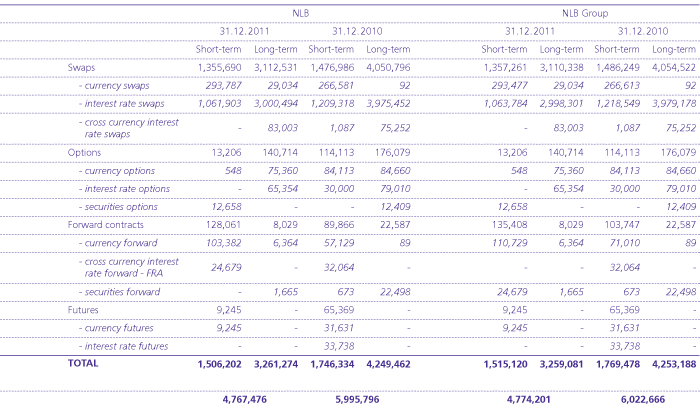
The notional amounts of derivative financial instruments that qualify for hedge accounting at NLB and NLB Group amount to EUR 1,830,782 thousand (December 31, 2010: EUR 2,894,422 thousand). Derivatives that qualify for hedge accounting are used to hedge interest rate risk.
The fair values of derivative financial instruments are disclosed in notes 5.2., 5.5. and 5.17.
e) Operating lease commitments
The future minimum lease payments under non-cancellable property and equipment and intangible assets operating leases are as follows:

f) Operating lease income
Future minimum lease income:

Income from operating leases in NLB amounts to EUR 725 thousand (2010: EUR 798 thousand) while in the NLB Group EUR 9,390 thousand (2010: EUR 12,651 thousand) and is included in income from non-banking services (note 4.6).
g) Capital commitments
As at December 31, 2011 NLB had capital commitments for the purchase of intangible assets (software and licenses) in the amount of EUR 290 thousand in respect of the implementation of a new information technology system (December 31, 2010: EUR 662 thousand).
As at December 31, 2011 the NLB Group had capital commitments for the purchase of property and equipment in the amount of EUR 19 thousand (December 31, 2010: EUR nil) and commitments in the amount of EUR 362 thousand (December 31, 2010: EUR 734 thousand) in respect of intangible assets (software and licenses).

Funds managed on behalf of third parties are accounted for separately from the NLB Group’s funds. Income and expenses arising with respect to these funds are charged to the respective fund, and no liability falls on the NLB Group in connection with these transactions. The NLB Group charges fees for its services.
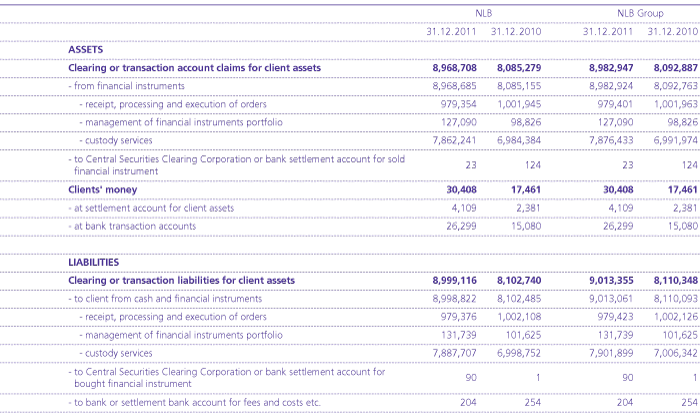
Funds managed on behalf of third parties

Fee income for funds managed on behalf of third parties

6. EVENTS AFTER REPORTING DATE
After December 31, 2011 there were no significant events.
7. RISK MANAGEMENT
The aim of risk management in the NLB Group is to achieve its planned results with minimal risk taking and to optimize the use of the NLB Group's regulatory and internal capital.
In managing risks, the NLB Group takes into account rules and regulations prescribed by the Bank of Slovenia and related internal acts of the NLB Group. The basic strategy and internal acts, which are regularly updated, discussed by the Supervisory Board and approved by the Management Board, define the objectives, procedures and methodologies for monitoring, measuring and managing different risks.
Following an initial recovery, economic growth continued to decrease in 2011. The global economic and financial crisis continued to deepen and affected the operations of our customers. They have, to an even greater extent than the previous year, found themselves in a situation that led to a record number of insolvency proceedings.
The adverse conditions affected the operations of the NLB Group, in particular the areas of credit risk management and liquidity risk management, as a result of a high level of distrust among financial institutions, which was further reinforced by the downgrading of NLB's international credit rating.
The NLB Group responded to the adverse conditions by strengthening its internal controls. It completed the project aimed at the centralization and harmonization of risk management. The NLB Group upgraded its methodology of liquidity risk stress test scenarios as a result of limited access to financial resources, which facilitates a faster and more comprehensive response to the liquidity situation. The NLB Group is aware of the global financial situation and takes all measures to ensure an adequate level of liquidity.
Certain issues remain open, in particular regarding credit risk management, as a result of the organization and internal processes. For that reason, NLB began a project aimed at the reorganization of and changes to NLB’s lending activities. NLB believes that the project, which will be implemented in 2012, will contribute significantly to the improved control and management of risks. The same approach will be taken at all other NLB Group companies in the next phase, the monitoring of which will be augmented with the implementation of a data warehouse.
We estimate that the changes will result in lower operational risk, which has increasingly manifested itself in the year of 2011 in terms of numbers and diversity also as a consequence of non payments by clients.

After early positive trends, movements in economic activity once again turned negative in 2011. This was followed by further deterioration of the credit portfolio, primarily in the construction sector, which in 2011 again experienced a significant drop in the volume of work performed, and where NLB first experienced a significant increase in the number of performance and payment guarantees redeemed. For that reason, NLB generated higher losses in the form of impairments and provisions. In contrast, export-oriented companies focusing on Europe frequently recorded significant growth in revenues. Thus, there were no major defaults in this segment.
The concentration of the portfolio on a small number of highly exposed clients mainly from the construction sector had a significant impact on the level of losses. NLB responded to this by limiting maximum exposure to an individual customer to 10% (previously 25%) of capital, through a clear downward trend in exposure to the construction sector and by tightening credit rating criteria. NLB also tightened collateral requirements for both existing and new transactions. NLB partly slowed the redemption of issued guarantees through the proactive monitoring and management of projects for which guarantees were issued to problematic customers.
NLB’s response to the deteriorating credit portfolio included the following measures:
- amendment to the approach for rating customers, with a focus on problematic customers,
- requirements for higher-quality collateral,
- centralization of the treatment of materially significant customers and
- the continuing consolidation process and the transfer of NLB’s risk management model to all banking subsidiaries and other financial companies in the NLB Group.
Nevertheless, a growth in bad loans could not be prevented. In 2011, bad loans increased by 74%. Although nominal growth slowed in the second half of the year, the proportion of bad loans rose to 17.9%, in part due to the simultaneous decline in the total loan portfolio. The following three events had a significant impact on the creation of impairments:
- the redemption of guarantees for the largest insolvent construction companies,
- a decrease in the fair value of collateral due to the illiquid real estate market and
- the tightening of the liquidity situation, mainly in the construction sector.
Impairment losses and provisions for commitments are created in accordance with IFRS as adopted by the EU and the standard methodology for the NLB Group, according to the risk associated with an individual transaction and the existence of objective evidence of impairment. The amount of impairment loss is also affected by collateral, if it represents an effective means of repayment in the event of a customer’s default. Individually significant claims are assessed for impairment on an individual basis, while the remainder of the credit portfolio is assessed collectively.
Individual and portfolio approach to credit risk management
The NLB Group manages credit risk at two levels: at the transactional and portfolio levels.
At the transactional level (i.e. individual customer or project), appropriate processes must be developed during the various phases of the relationship with the customer (i.e. prior to, during and after entering into an agreement). In the first phase, information regarding the customer, which facilitates the objective assessment of the customer’s operations and financial position (i.e. information regarding "soft" factors that could affect the customer’s operations and information regarding a customer’s past cooperation with the bank), is critical. The aforementioned serves as the basis for rating a customer, for assessing its creditworthiness and later for rating the customer’s claims.
In the second phase, it is essential to draw up an appropriate agreement, stipulating collateral and obligations.
The third phase comprises various forms of customer monitoring, in particular with regard to the generation of sufficient cash flows for the regular settlement of liabilities and other relevant data that could affect the customer’s solvency (or associated credit risk), and thus the need to create and/or amend the amount of impairments on claims against the customer or provisions for commitments.
NLB’s Credit Committee regularly monitors those customers that are under significant pressure from trends in operations and the environment.
The credit portfolio is regularly monitored by segments (e.g. credit rating, country, type and size of customer, activity, collateral, bad/overdue claims, currency exposure, etc.). Monitoring comprises analyzing changes and identifying trends in movements, risks and concentration of the credit portfolio on the basis of time factors.
Among the most important tools for assessing the quality of the credit portfolio, the characteristics of the internal rating system and the level of exposure to systemic risk (i.e. to a risk that affects both a large number of customers and financial instruments) are:
- transition matrices, which illustrate the migration of customers between rating categories, and the related methods for determining time-sensitive portfolio changes and
- the level of concentration or diversification of the credit portfolio. NLB appropriately diversifies its portfolio to mitigate specific components of credit risk (i.e. the risk deriving from transacting with a specific customer, positions in financial instruments or specific events).
NLB migration matrix for corporate clients based on annual transitional matrices for the years 2001-2011

a) Derivatives
The NLB Group maintains control limits on net open derivative positions, i.e. the difference between purchase and sale contracts, both by amount and term. The NLB Group enters mostly into currency, interest rate and equity derivative contracts. Exposure from derivatives is mainly associated with NLB, other members of the NLB Group conclude derivative contracts only in order to hedge their own open positions or for their clients’ purposes (back to back transactions). The amount subject to a credit risk is limited to the credit replacement value of the instrument that is determined in accordance with the regulations (based on the sum of current and potential exposure). Exposure to credit risk from derivatives is managed in the scope of overall lending limits.
b) Credit related commitments
Guarantees and standby letters of credit, which represent irrevocable assurance that the NLB Group will make payments if a customer cannot meet its obligations to third parties, carry the same credit risk as loans. Documentary and commercial letters of credit are written undertakings by the NLB Group on behalf of a customer authorizing a third party to draw drafts on the NLB Group up to a stipulated amount under specific terms and conditions, are collateralized by the underlying shipments of goods to which they relate and therefore carry less risk than direct borrowing. Commitments to extend credit represent unused portions of authorizations to extend credit in the form of loans, guarantees or letters of credit. With respect to credit risk on commitments to extend credit, the NLB Group is potentially exposed to loss in an amount equal to the total unused commitments. However, the likely amount of losses is less than total unused commitments, since most commitments to extend credit are contingent upon customers maintaining a specific credit rating. The NLB Group monitors the term to maturity of credit commitments, as longer-term commitments generally have a greater degree of credit risk than shorter-term commitments.
c) Internal rating system and authorizations

The Bank of Slovenia’s Regulation on the Assessment of Credit Risk Losses of Banks and Savings Banks serves as the legal basis for rating each customer and the associated claims, and for creating impairments. The aforementioned regulation prescribes five rating categories (from "A" to "E") for customers and claims. An “A” credit rating is given to first-class customers, who are not expected to encounter difficulties in repaying their obligations. A credit rating of “B” indicates customers with a slightly worse financial position, which is temporary in nature and does not indicate difficulties in repaying obligations. A credit rating of “C” indicates customers who are undercapitalized and highly indebted, or those customers that generally do not generate sufficient cash flows to repay their obligations, and so thus may pay their obligations in arrears. In credit rating C are classified all those customers, whose obligations have been restructured. Credit ratings of “D” and “E” indicate customers with evident financial difficulties, or those who are in the process of compulsory settlement or bankruptcy. It is expected that these clients will not be able to repay most or even any of their obligations from their operating cash-flow. Customers with a “C” credit rating or worse must provide additional collateral. The regulation also prescribes the impairment of claims and the creation of provisions for commitments in accordance with the IFRS, with respect to the risk of a specific transaction and existence of evidence of impairment. The amount of impairment loss is also affected by the collateral received, if it represents an effective secondary means of repayment in the event of a customer’s inability to settle its debts.
Authorizations, procedures and the detailed rating methodology, as well as the setting of a maximum borrowing limit and the impairment of claims, are formalized in the NLB Group’s internal acts. A standard customer rating methodology, with the prescribed set and quality of input data and elements of a rating analysis, applies to all NLB Group companies. Here it should be noted that decisions regarding materially significant customers of the NLB Group is solely the responsibility of the NLB Credit Committee.
NLB regularly reviews the business practices and credit portfolios of NLB Group companies to ensure that they are operating in accordance with the minimum risk management standards of the NLB Group. This ensures appropriate standard processes for managing and reporting credit risks at the consolidated level.
d) Maximum exposure to credit risk
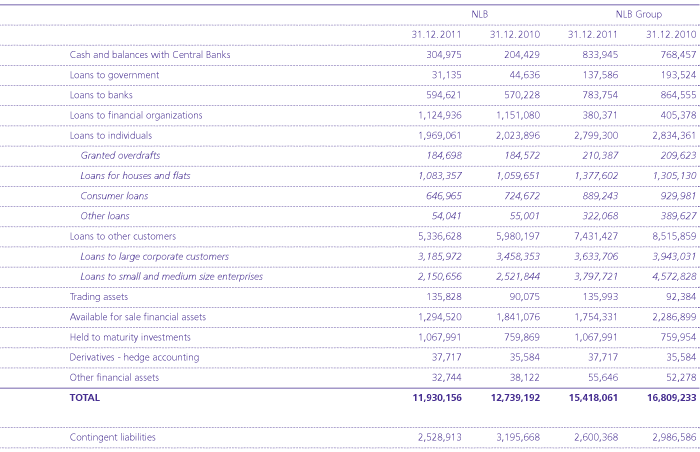
The maximum exposure to credit risk represents the worst case scenario relating to credit risk exposure. For assets, the exposures set out above are based on net carrying amounts as reported in the statement of financial position, while off-balance sheet items amounts are based on nominal values.
According to internal methodology for loan impairment, all individually significant customers are individually assessed for impairment. This represents on a NLB level 66.9% (2010: 66.4%) and on a NLB Group level 61.4% (2010: 64.0%). NLB has 16.5% (2010: 14.5%) loans and advances neither past due nor impaired and 0.4% (2010: 0.9%) loans and advances past due but not impaired.
In 2010, and again in 2011, the quality of the credit portfolio deteriorated due to the financial crisis. This resulted in an increase in impairment and provisions for credit loss for customers who were collectively assessed and for customers who were individually assessed, as the result of lower expected repayments or lower market value of collateral.
For this reason the coverage of the credit portfolio by allowances for impairment in NLB has been steadily increasing (2010: increasing) to stand at the end of the year 2011 at 10.6% (2010: 7.2%). 67% (2010: 76.6%) of the portfolio is considered to be a quality portfolio. The coverage of the portfolio by allowances for impairment at the NLB Group level has also risen and stood at 12.3% (December 31, 2010: 8.8%) at the end of 2011. 65.1% (December 31, 2010: 72.6%) of the portfolio is considered as quality portfolio (A and B ratings).
Non-performing loans

e) Collateral from loans and advances
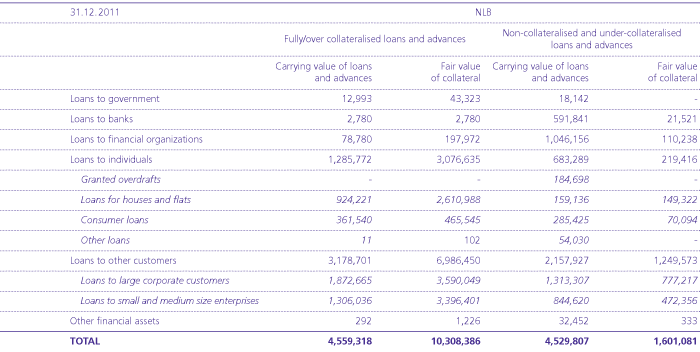
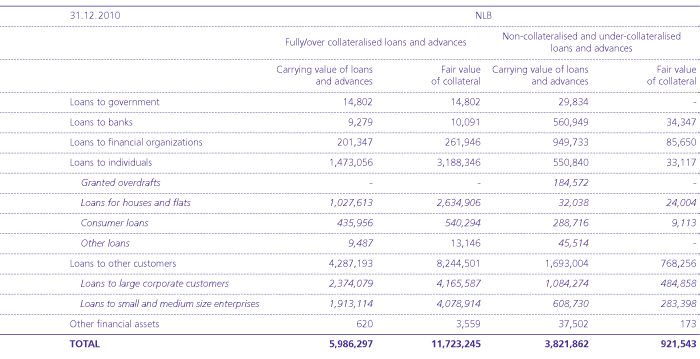
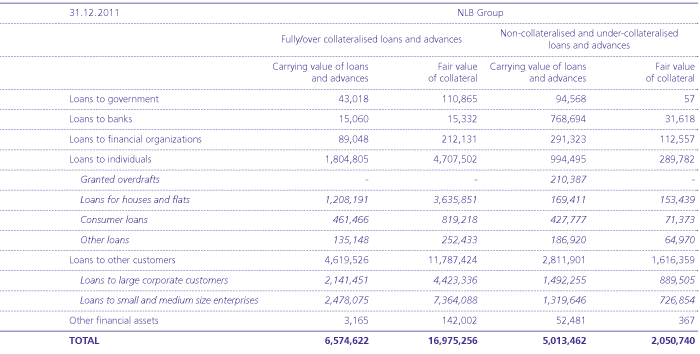
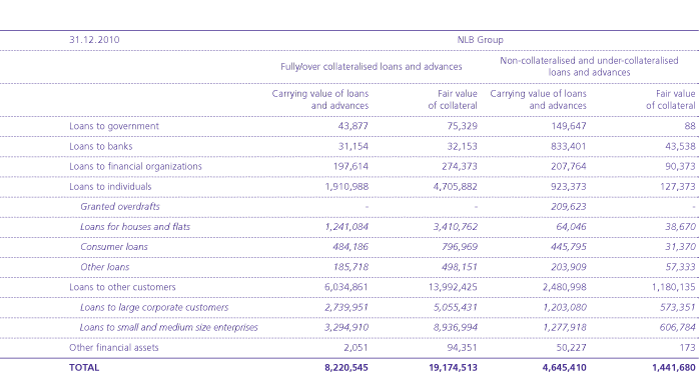
The NLB Group accepts different types of collateral to mitigate credit risk. The decision regarding the type and value of collateral depends on an analysis customer data. The NLB Group strives to obtain high-quality collateral, which facilitates the more rational use of the NLB Group’s capital and results in lower impairments and provisions for financial assets and commitments.
The main types of collateral are as follows:
- for houses and flats to individuals, real estate collateral,
- for consumer loans to individuals, claims secured by insurance company,
- for loans to other customers, real estate collateral.
The NLB Group regularly monitors the value of collateral over the entire loan repayment period and requires that the customer provides additional collateral if the value of collateral decreases.
f) Loans and advances neither past due nor impaired
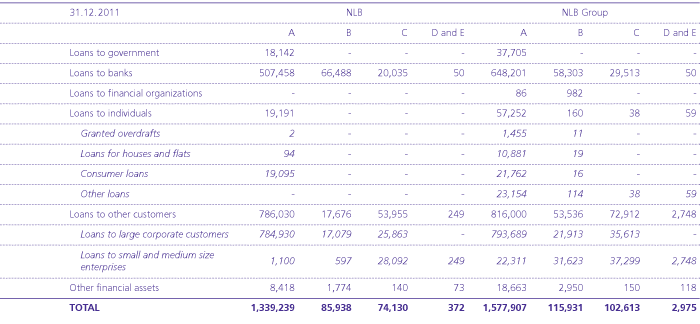

g) Loans and advances past due but not impaired
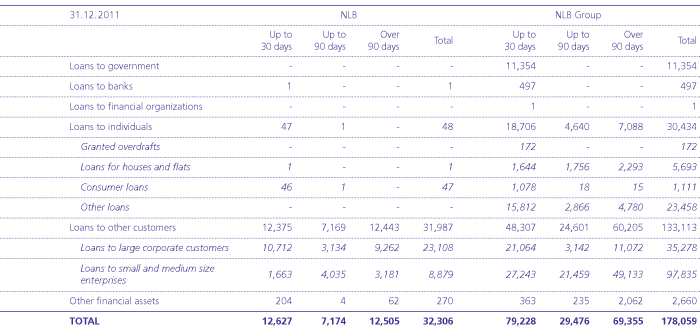
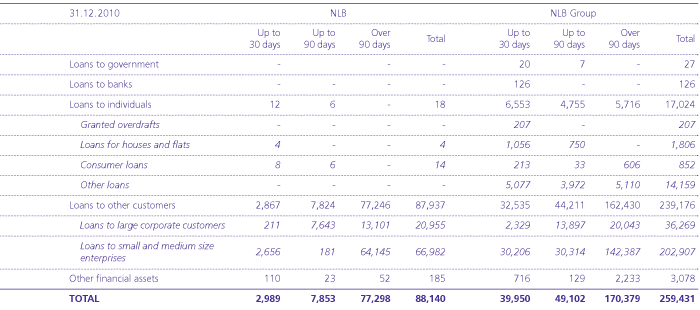
The table illustrates the amounts of loans in arrears in such a way that the total loan amount is placed in the largest bucket for an individual transaction.
h) Impaired loans and advances
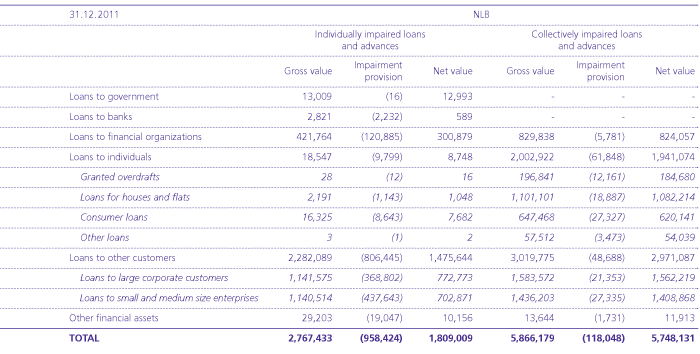
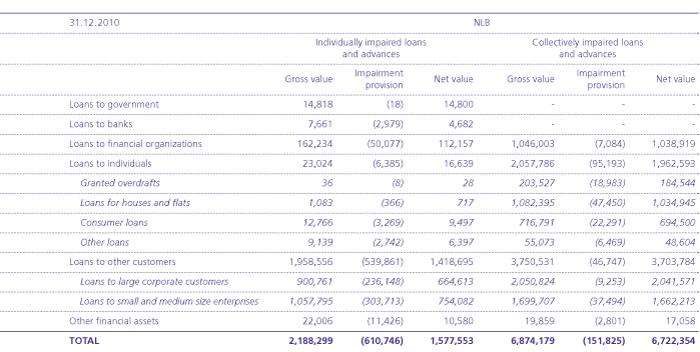
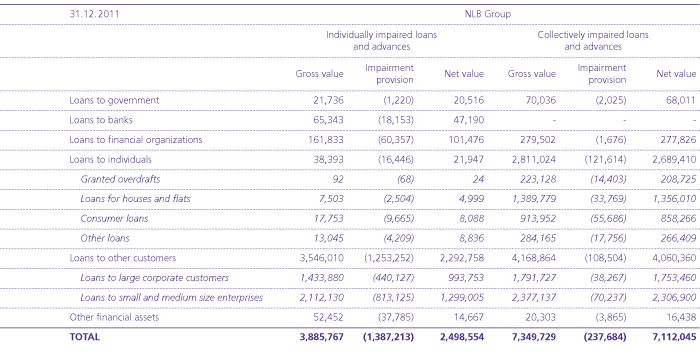
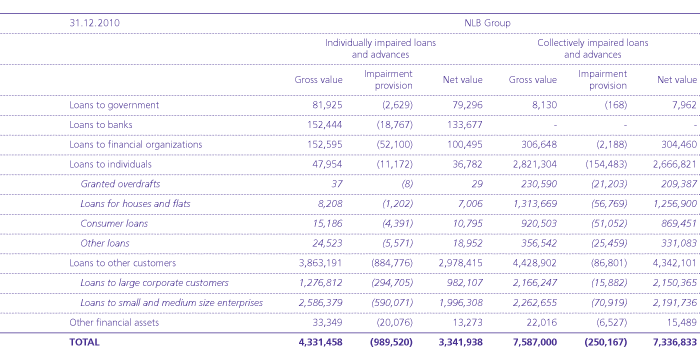
i) Loans and advances analysis
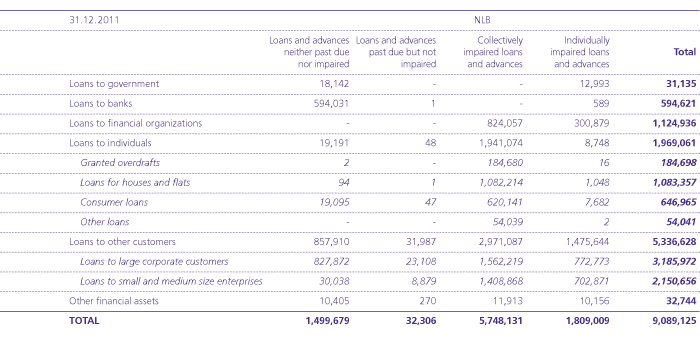
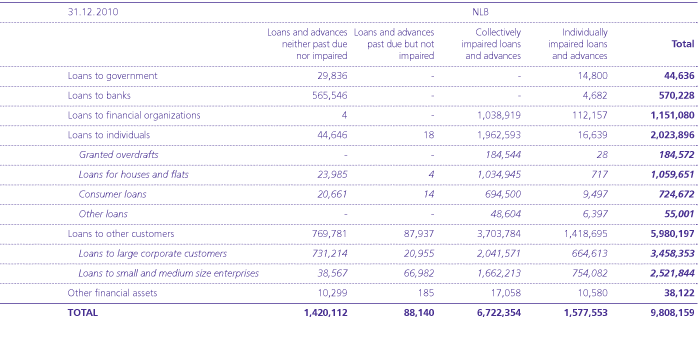
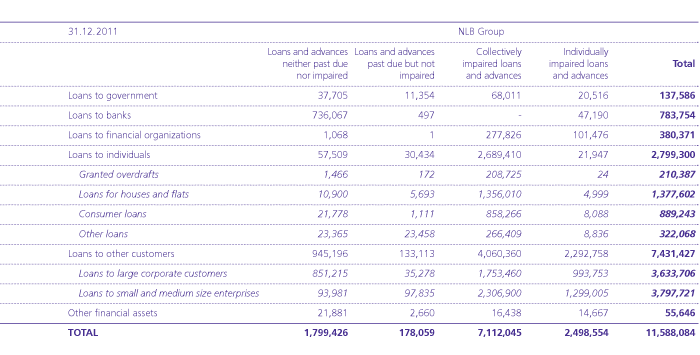
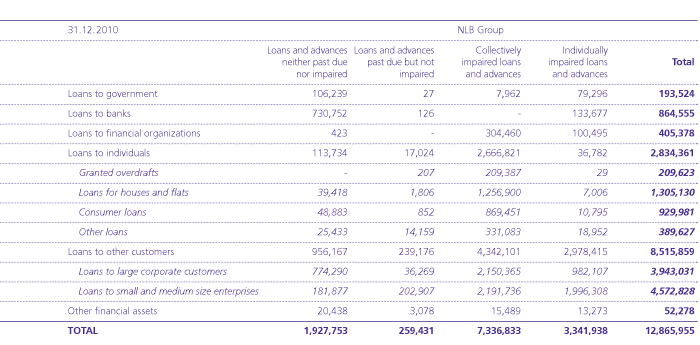
j) Repossessed assets
NLB and the NLB Group received the following assets by taking possession of collateral held as security and held them at reporting date:

k) Analysis of loans and advances by industry sectors


l) Analysis of loans and advances by geographical sectors

m) Analysis of debt securities, treasury bills, other eligible bills and derivative financial instruments by geographical sectors
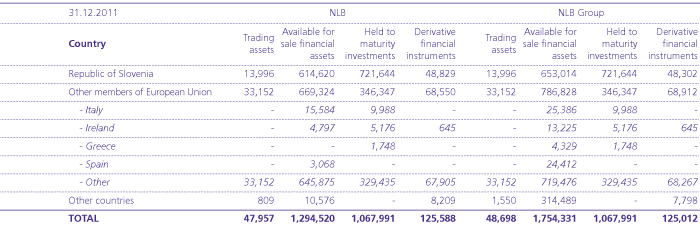
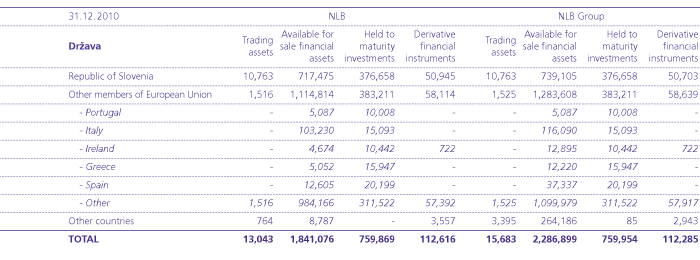
n) Internal rating of derivatives counterparties

No derivatives in the banking book are entered into with counterparties with an external rating less than “AA”. When derivatives are entered into on behalf of customers all such transactions are covered through back-to-back transactions involving third parties with an external rating of “AA” or above.
o) Debt securities in NLB’s and the NLB Group’s portfolio that represent subordinated liabilities for the issuer

Securities in NLB represent subordinated bonds of domestic issuer with internal rating “A”. Other members of the NLB Group do not have debt securities that represent subordinated liabilities for the issuer.
p) Presentation of financial instruments by measurement category
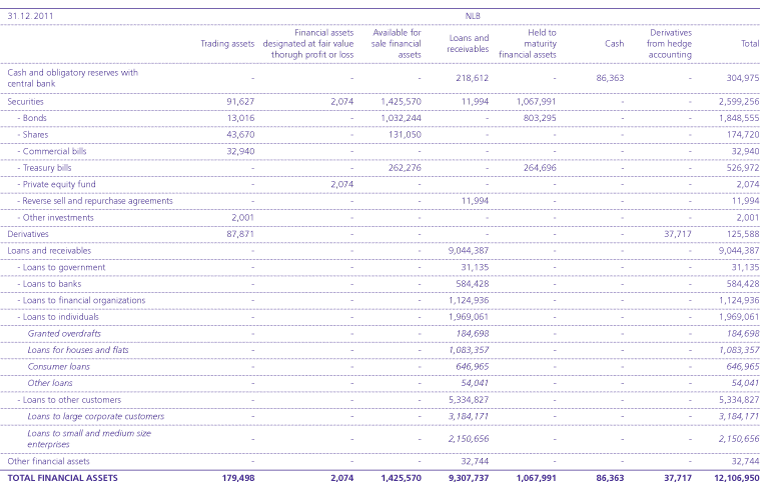
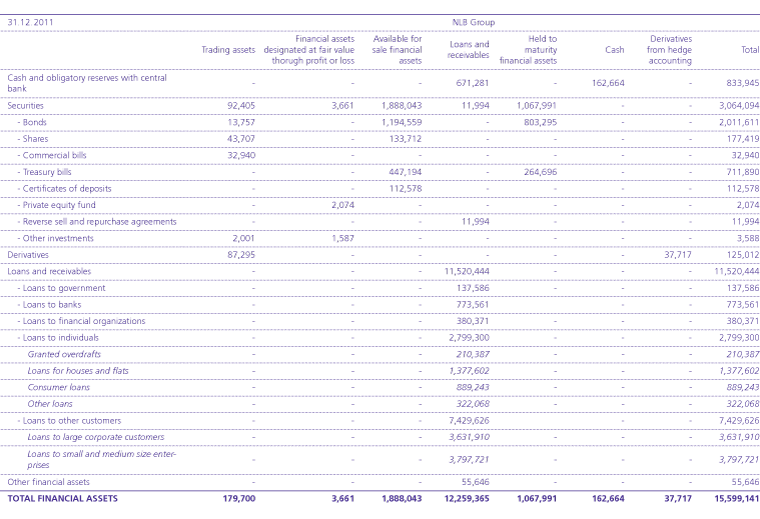
As at December 31, 2011 and December 31, 2010 all of the Group’s financial liabilities except for derivatives designated as hedging instruments, trading liabilities and financial liabilities designated at fair value through profit or loss were carried at amortised cost.
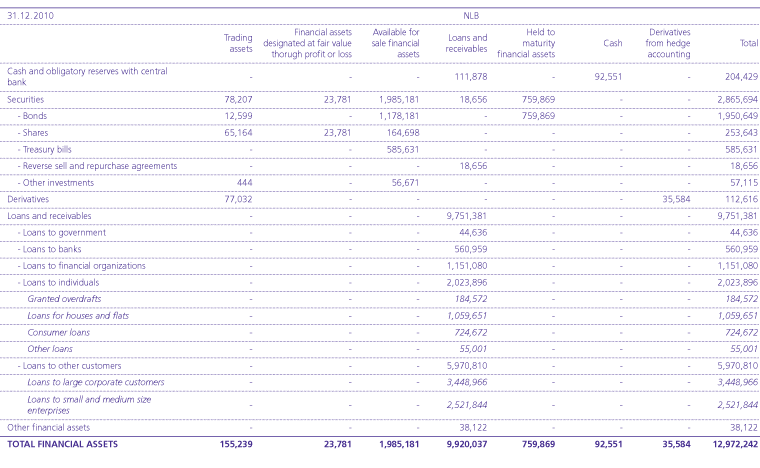
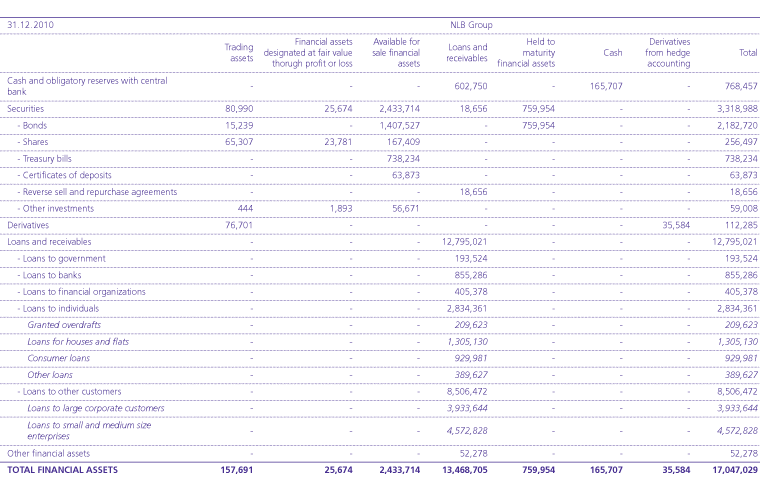

Market risk is the risk that the market or fair value of financial instruments could fluctuate due to unfavourable changes in specific market parameters, such as exchange rates, interest rates and securities prices. Market risk management at the NLB Group is a process comprising the monitoring and measurement of individual risks with the aim of actively managing the potential negative financial effects that could arise as a result of changes on the financial markets.
In accordance with the provisions of Bank of Slovenia regulations, NLB is the only bank in the NLB Group that fulfils the conditions for ensuring the necessary capital for market risks. In accordance with Strategy for trading in Financial Instruments at the NLB Group, active trading in financial instruments by other NLB Group companies is extremely limited, and primarily aimed at servicing customers and hedging their own positions. Other banks in the NLB Group monitor exposure to currency and interest-rate risks, which are primarily the result of structural movements and macroeconomic conditions, in accordance with guidelines on risk management in the NLB Group. Monitoring and managing the NLB Group's exposure to market risks are not carried out on a consolidated level. Guidelines and exposure limits for each risk type are set for individual NLB Group companies, who regularly monitor exposure and report to the Assets and Liabilities Committee of the NLB Group (ALCO of NLB Group).
The supervisory bodies of NLB Group entities adopt their own market risk management policies. In accordance with these policies, they are obliged to monitor and manage exposures to market risks and report them to NLB. The policies of NLB Group entities must take into account local legislation and be in line with the Standards for risk management at the NLB Group. The aforementioned document was approved and adopted by NLB's Management Board. Methodologies concur with regulatory requirements on an individual and consolidated basis, while current reporting to the regulator on consolidated level is carried out using a standardized approach.
a) Capital markets summary
Slovenia
Total turnover on the Ljubljana Stock Exchange reached EUR 470 million in 2011 (i.e. turnover on the share, bond and fund markets), down EUR 22.5 million on the turnover achieved in 2010 and just half of the total turnover recorded in 2009. The annual number of transactions was 97,580 and was down 21% on 2010, mainly due to a decline in transactions in shares. The stock exchange's main index, the SBI TOP, lost about 30% of its value in 2011, which is in line with the performance of the comparable Central and Eastern Europe CEESEG composite index. As at December 31, 2011 the market capitalization of all shares included in the SBI TOP index amounted to EUR 3.7 billion, a decline of close to EUR 1 billion on the end of 2010, which is double the decrease in market capitalization recorded a year earlier.
Despite the fact that the return of the main index was comparable to other markets in the region, liquidity remained at extremely low levels. The annual market capitalization turnover was comparable to that of the Zagreb Stock Exchange, while reported turnover was substantially lower when compared to other more developed indices in Central and Eastern Europe, such as Warsaw, Prague and Vienna. In the case of the SBI TOP, annual turnover was about one quarter of total market capitalization, while that percentage was close to 200% on the aforementioned, more developed markets. Moreover, 48% of total turnover can be attributed to the most heavily traded shares of Krka, while that proportion rises to 74% taking into account the second most heavily traded shares of Mercator.
Similar to 2010, the reasons for the drop in share prices can be attributed to sell-orientated domestic investors. This fact is confirmed by the rising proportion of foreign investors, while the total number of investors continued to decline.
Foreign markets
The year 2011 was marked primarily by the deepening debt crisis in Europe, while economic growth in developing countries started to slow. Following 4% global GDP growth in 2010, last year's global economic growth is estimated at around 2.7%, with a further slowdown expected this year. Owing to the abovementioned debt crisis, the slowdown will be particularly pronounced in the euro area, as forecasts indicate a contraction in GDP. The US shows a more stable picture, with forecasts of a slight strengthening of growth, while developing markets will record slower growth than the previous year mainly due to the weakening of exports. Fears of rising inflation have shifted to the background, giving central banks and governments more power to continue with crisis measures.
Due to the abovementioned debt problems in Europe, safer government bonds became the focus of investors last year. With investors seeking a safe heaven and the resulting increase in demand, the prices of these bonds rose, while the yield on 10-year German government bonds fell from around 3% at the beginning of the year to 1.8% at the end of the year. US government bonds recorded similar dynamics. On the other hand, some major European countries, Italy in particular, witnessed a sharp increase in borrowing costs due to budgetary problems, with the yield on 10-year Italian bonds exceeding over 7%, which remains an important benchmark for investors, as countries with low economic growth have difficulties affording such expensive borrowing.
On the other hand, the factors that caused the flight of investors to safer investments resulted in a high level of volatility on the stock markets, which showed relatively stable growth in the first half of the year, but swung sharply with the deepening of the European debt crisis, ending the year in the red. With a lower drop in the US stock markets, where the S&P 500 index fell just short of positive growth, European stock indices mostly recorded double-digit losses, in particular the German DAX (down 14.7%), the UK FTSE (down 6.5%) and the French CAC 40 (down 17%). Since stock markets are also leading indicators of future medium-term economic trends, the higher losses recorded by European stocks may also be explained by the weaker economic outlook for Europe, while slowing growth in developing markets, where the public finance situation is better, is also an important factor of the negative dynamics.
Equity trading portfolios excluding equity investments hedged using derivative contracts

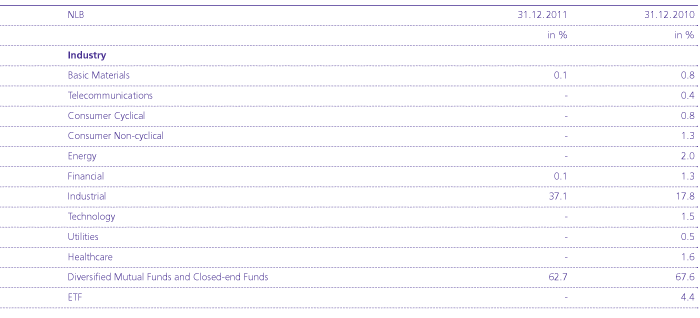
b) Value at Risk methodology
NLB’s exposure to currency and other market risks in the trading book (interest rate risk and the changing securities prices) is monitored using the “Value at Risk” (VAR) methodology.
In the area of interest rate risk in the banking book, an analysis is performed of the sensitivity of interest income, which is estimated on the basis of the net interest income methodology. For equity securities in the banking book, exposure to risks is measured using a VAR calculation and sensitivity analysis.
Currency risk
NLB uses an internal »Value at Risk« (VAR) model to calculate currency risk arising from open positions. The calculation of the VAR value is adjusted to Basel standards (99% confidence interval, monitored period of 300 business days, 10-day holding position period), and is based on the historical simulation method. VAR is calculated for currency risk for the whole open bank position (e.g. the position of trading and banking book together) as NLB’s total open position is managed by the Treasury department.

The main factor in currency risk exposure in 2011 was the open position in Serbian Dinars (RSD). The open RSD position was the result of restructured loans and the related currency conversion. Also contributing to currency exposure in 2011 was the CHF position, where the rate was relatively volatile. Lower values in 2011 were mainly due to lower open positions. To a lesser degree, this also to the fact that NLB transitioned to the net combined approach in November 2011, which means that the position also took into account impairments for bad claims.
The methodology for measuring currency risk at the NLB Group level is based on the net open foreign exchange position principle and the monitoring of the nominal limits (for the total open position by currency), related to the capital size of the NLB Group member. The internal VAR method described above is used for the illustration below of exposure to currency risk, which derives from the quarterly net open positions of NLB Group entities.

The increase in VAR for currency risk in NLB Group is driven by the higher net open position for individual NLB Group entities and increasing exchange rate volatility. The latter was the result of continuance of conditions on the financial markets in 2011, which consequently affected potential loss or the level of VAR.
Other market risks in the trading book
NLB uses an internal VAR model based on the variance-covariance method for other market risks. The daily calculation of VAR value is adjusted to Basel standards (99% confidence interval, monitored period of 250 business days, 10-day holding position period).
In 2011, interest rate risks in the trading book amounted to an average of EUR 198 thousand (2010: EUR 342 thousand) and remained on a relatively similar level compared with the previous year. At the end of 2011 the market value of the debt securities portfolio amounted to EUR 13 million (2010: EUR 12.6 million), while the exposure form derivatives trading derives primarily from Bond future contracts.
The risk of changing securities prices (debt securities portfolio) in the trading book fluctuated between EUR 2.9 and 4.0 million in 2011 (2010: between EUR 3.0 and 4.3 million). The principal part of the exposure arose from realizing the received collateral for credit loans in the long-term trading portfolio.

The average, maximum and minimum values in the upper table are calculated on the basis of daily VAR calculations, which are based on daily open positions and movements in market data during the past monitored period (300 or 250 working days). The “average” value represents the arithmetic mean of daily VAR values in 2011, while the “maximum” and “minimum” values represent the highest and lowest values of daily VAR calculations in 2011 respectively.
Interest rate risk in the banking book
The NLB Group’s exposure to interest rate is monitored and managed by using an interest rate gaps methodology and duration. The same methodology is also used to calculate the NLB Group’s sensitivity of interest income. The analysis of interest income sensitivity assumes a move in interest rates by 50 basis points in the short term. The analysis is based on the assumption that the positions used remain unchanged and that the yield curve shift is parallel. The assessment of the impact of a change in interest rates of 50 basis points (+/- 0.5%) on the value of net interest income for the banking book position:
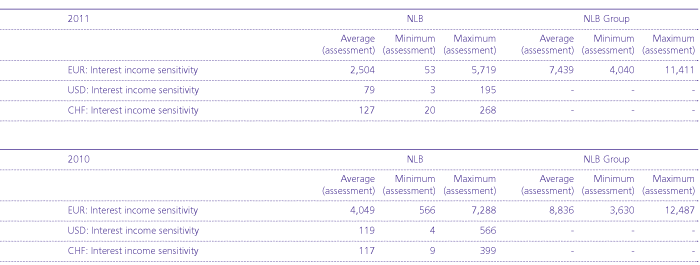
In 2011, the value of interest income sensitivity remained relatively stable, but was slightly more volatile than in the previous year. Exposure to interest rate risks primarily derives from the portfolio of first-class debt securities (ECB eligible), which represent a source of secondary liquidity. The exposure arising from classic loan-deposit transactions was relatively low owing to the active management of these positions. The long-term interest rate positions of other NLB Group entities, from which the majority of interest rate risk derives, are relatively closed.
The values in the table have been calculated on the basis of monthly calculations of short-term interest rate gaps, where the applied parallel shift of the yield curve by 50 basis points represents a realistic and practical scenario. The “average” value represents the arithmetic mean of monthly calculations, while the “maximum” and “minimum” values represent the highest and lowest values calculated during the period.
Risk of a change in prices in the portfolio of equity securities in the banking book
In terms of equity security investments, NLB has adopted policies for management of these investments that were approved by the Management and the Supervisory Board. The policies cover the permitted investment structure of the portfolio, its diversification, and the monitoring and measurement of risks. In addition to a standardised methodology NLB also uses an internal model, which has been adapted to the requirements of the Basel standards, for monitoring and measuring the risks related to the equity portfolio.
The value of the equities portfolio in the banking book in NLB amounted to EUR 133 million by the end of 2011 (December 31, 2010: EUR 188.5 million) of this EUR 113 million (December 31, 2010: EUR 139.5 million) represented realized collateral, the long-term portfolio represented in amount of EUR 18 million (December 31, 2010: EUR 25.2 million) as available for sale financial asset and in amount of EUR 2 million (December 31, 2010: EUR 23.8 million) as financial asset designated at fair value through profit or loss. The value of VAR for the equities portfolio in the banking book amounted to EUR 14.75 million at the end of 2011 (2010: EUR 12.4 million). Assuming a fall in stock market indices or individual securities prices of 15% (2010: 15%), the value of the portfolio would decrease by EUR 19.96 million (December 31, 2010: EUR 28.3 million).
Guidelines were prepared for the effective management of risks in the investment banking sector in the scope of the NLB Group's financial instruments trading strategy. Trading in equity securities for subsidiaries is not permitted. Only stock broking services are provided. The majority of the equity securities portfolio in the banking book derives from NLB's position, while smaller positions are also disclosed by certain NLB Group entities.
The value of equity portfolio in the NLB Group stood at EUR 137.4 million at the end of 2011 (December 31, 2010: EUR 193 million) of this EUR 113 million (December 31, 2010: EUR 139.5 million) represented realized collateral, the long-term portfolio represented in amount of EUR 20.7 million (December 31, 2010: EUR 27.8 million) as available for sale financial asset and in amount of EUR 3.7 million (December 31, 2010: EUR 25.7 million) as financial asset designated at fair value through profit or loss. Assuming a fall in stock market indices or individual securities prices of 15% (2010: 15%) the value of the portfolio would decrease by EUR 20.37 million (December 31, 2010: decrease by EUR 29 million).
c) Currency Risk (FX)
The NLB Group manages currency risks in accordance with the adopted currency risk management policy adopted by NLB’s Assets and Liabilities Committee. The positions of all currencies in the NLB’s statement of financial position for which a daily limit has been set are monitored daily.
Exposure to currency risks is monitored and managed by the Assets and Liabilities Management Department on the basis of daily data obtained from the Risk Management Department. Assets and Liabilities Management Department manages exposure to currency risks by currency, so that they are always within the limits.
Exposure to currency risks is discussed at daily liquidity meetings and monthly meetings of the NLB’s Assets and Liabilities Committee.
The amount of financial instruments denominated in euros and in foreign currency
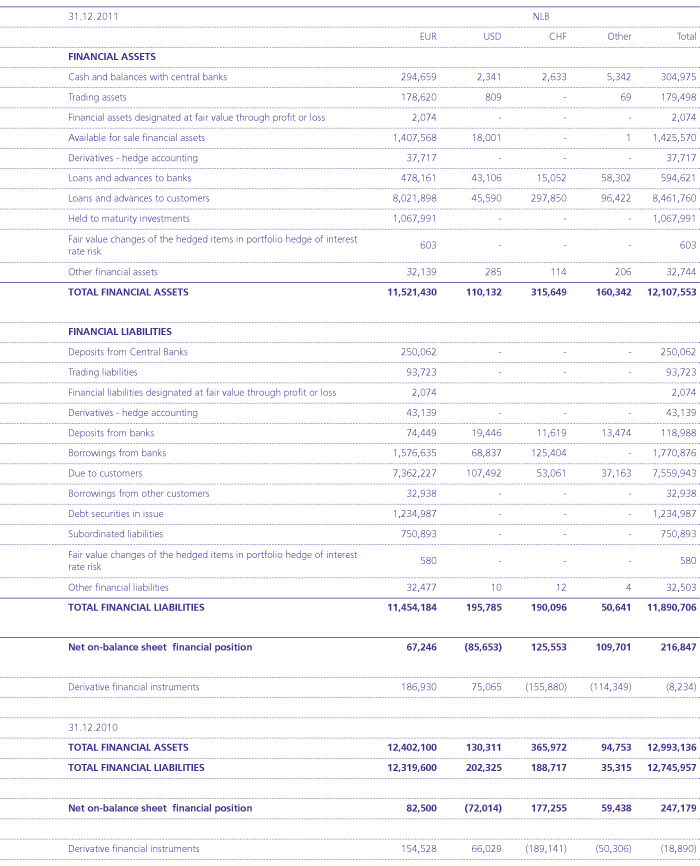
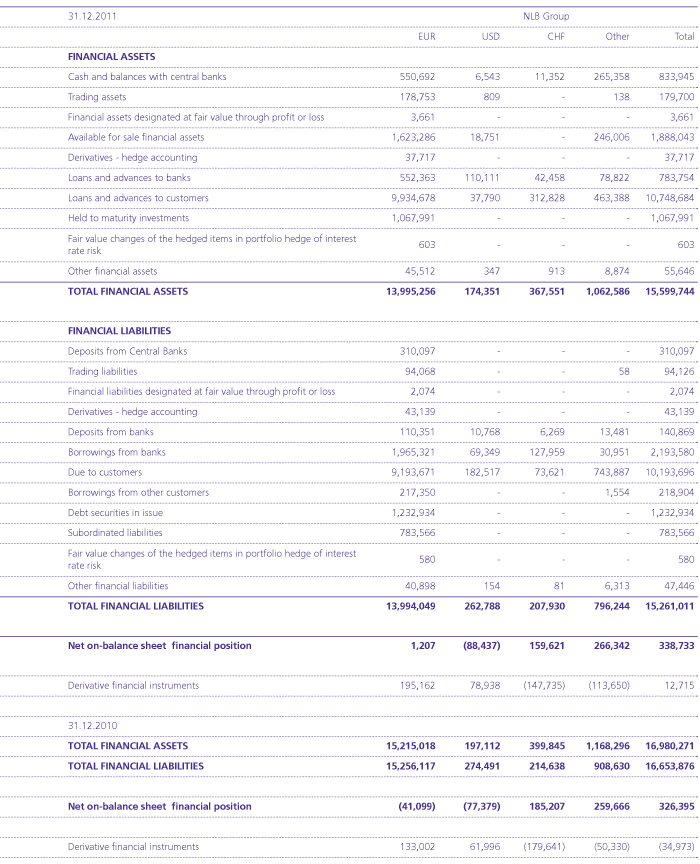
Sensitivity analysis for currency risk
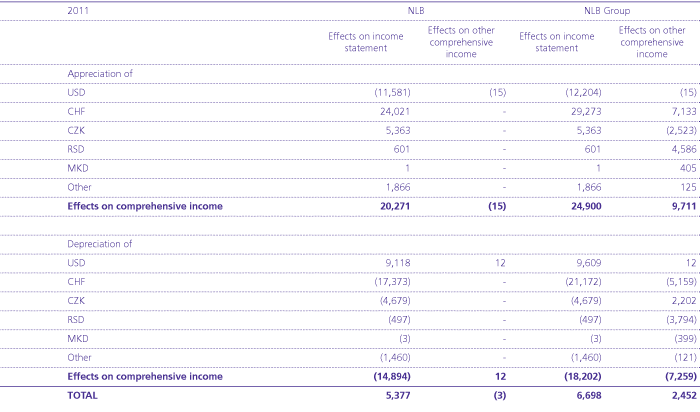
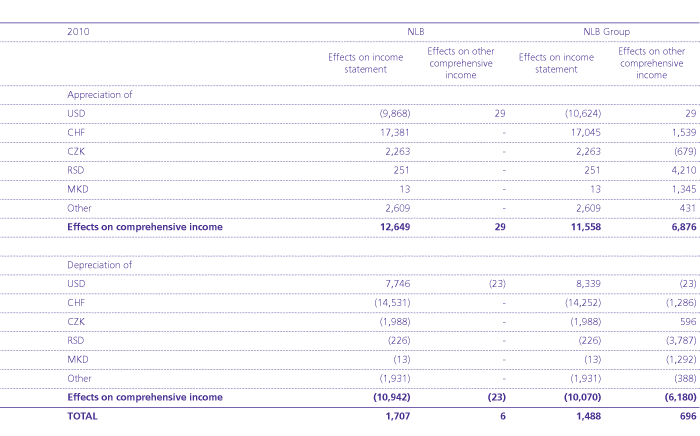
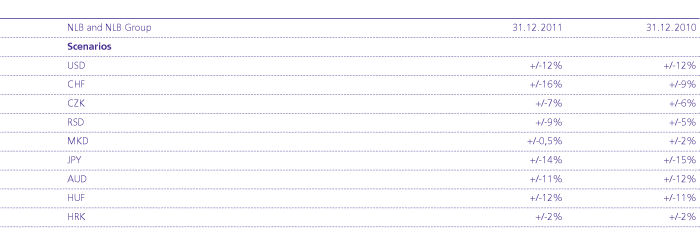
d) Managing interest rate risk
The management of interest rate risks in the NLB banking book is separated from the measurement and monitoring of these risks. In the past, NLB implemented an interest rate risk management policy, which reflects a conservative strategy for assuming interest rate risks and is based on general Basel risk management standards.
NLB manages interest rate risk in conjunction with credit, currency and liquidity risks, as exposure to interest rate risk is frequently the result of exposure to other risks. These risks also have significant impact on the stability of the interest rate margin, which represents the primary goal of interest rate risk management.
In the banking book, NLB manages interest rate risks arising from interest-insensitive liability items and interestsensitive items without maturity (e.g. available capital and stable sight deposits) separately from all other banking book transactions. The management of interest rate risks arising from interest-insensitive items and items without maturity is facilitated by managing the securities portfolio of the banking book, which is subject to strict internal rules and policies. The primary purpose of the portfolio is to maintain adequate secondary liquidity reserves. By determining the upper limit of modified duration and limits for credit and market risks, it also contributes to the stability of interest rate margin.
The management of interest rate risks arising from all other banking book transactions is provided by managing the interest rate maturity of statement of financial position and off-balance sheet items, which NLB classifies by individual maturity buckets, taking into account credit-risk adjusted positions by currency. The openness of positions in individual maturity buckets in one direction or the other is defined in absolute amounts. According to the recommendations of the Basel guidelines, the same restriction is applied to potential changes in the net present value of all interest-sensitive items.
A sensitivity analysis is performed based on the Basis Point Value (BPV) method, which estimates changes in the market value of a banking book position due to a parallel shift in the yield curve. A sensitivity analysis is performed for different segments of the banking book and for the banking book as a whole, where all transactions are captured, by all currencies with an adjustment for credit risk.
The basic tool for the managing interest rate risk in the banking book is the management of NLB’s statement of financial position items. The strategies that foresee adequate adjustments to the statement of financial position items are discussed and adopted at the executive level of NLB or in the scope of NLB's Assets and Liabilities Committee (ALCO). NLB primarily uses the following methods for managing interest rate risks:
- managing the portfolio of debt securities in the banking book,
- issuing own securities,
- introducing new banking products and special treatment of the existing products and
- managing the maturity of existing statement of financial position items.
NLB’s ALCO regularly discusses and supervises the adaptation of the offered range and price ratios of banking products in order to limit interest rate risk exposure.
More precise management of interest rate risks, which NLB does not manage via statement of financial position items, is carried out by transactions in derivatives, using the following instruments:
- interest rate swaps,
- overnight index swaps,
- cross currency swaps,
- forward rate agreements and
- interest rate futures.
The management of the NLB Group’s interest rate exposure is not performed at the consolidated level. However, NLB regularly monitors exposure in accordance with the Development Program and Minimum Standards for Risk Management in NLB Group, which defines the guidelines for the banking group's effective and uniform approach to interest rate risk management. The NLB Group strengthened the monitoring and management of interest rate positions at individual NLB Group companies, where the same core principles of interest rate risk management applied by NLB are applied, taking into account the local business environment. Interest rate risk exposure is also monitored on the basis of interest rate gaps, and a sensitivity analysis based on the BPV method and associated limits. Guidelines regarding the limitation and management of interest risks at individual NLB Group companies are in line with the guidelines of the NLB Group ALCO and with the ALCOs of these banks.
Analysis of financial instruments according to the exposure to interest rate risk
Illustrated below are the carrying amounts of financial instruments, categorized by the earlier of contractual repricing or residual maturity.
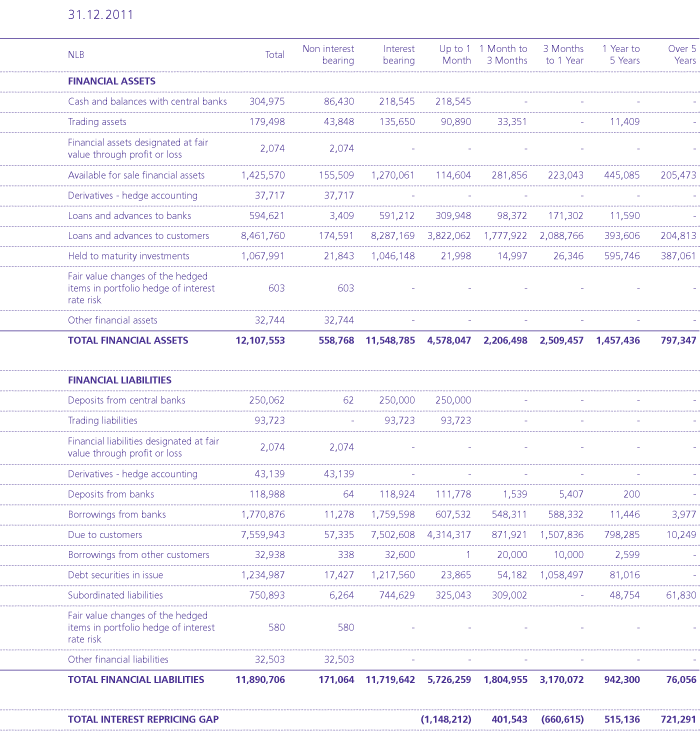
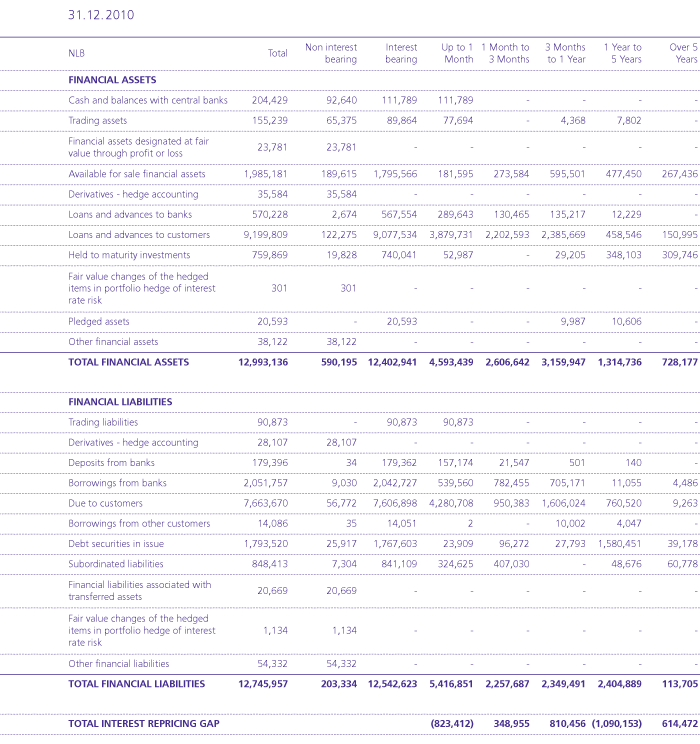
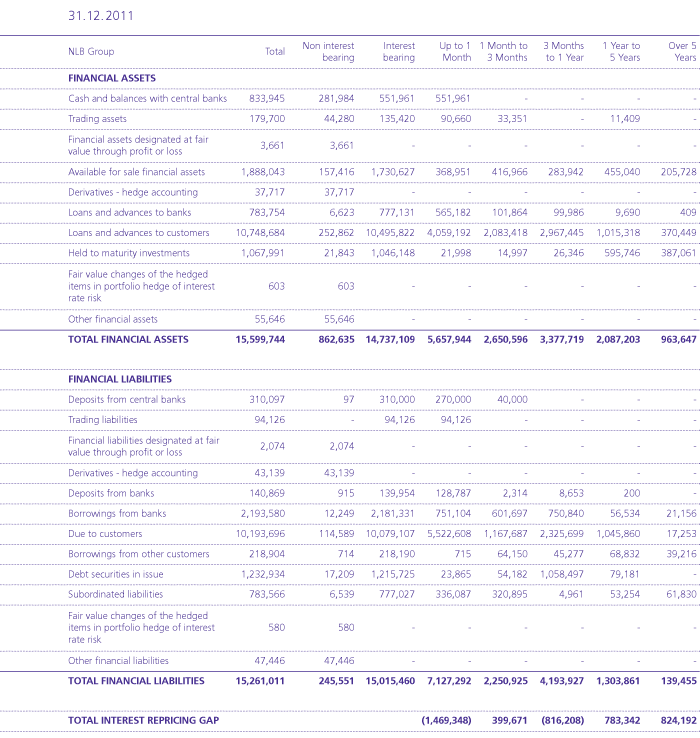
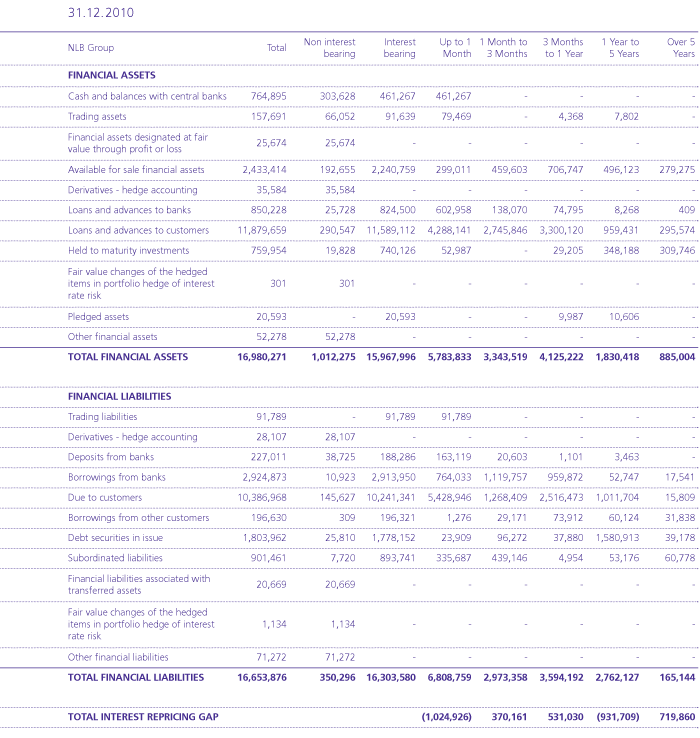
Sensitivity analysis for interest rate risk
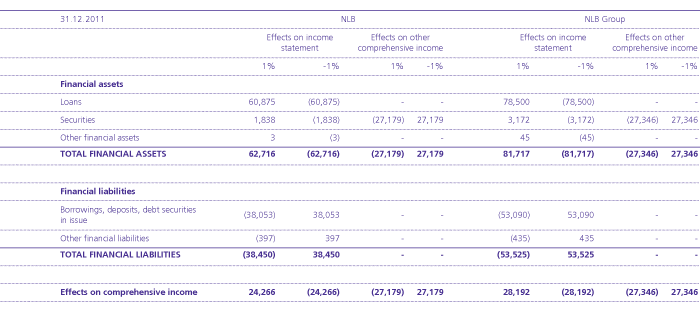
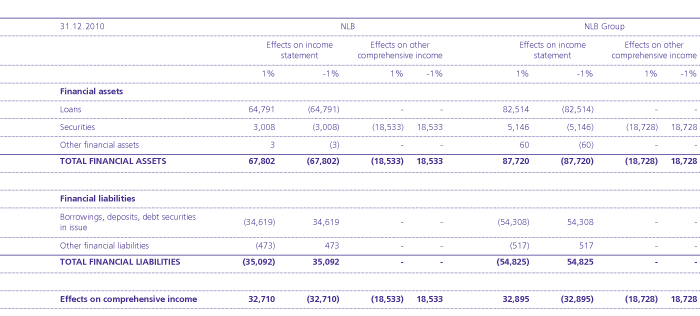
e) Liquidity risk
Liquidity risk is monitored and managed in the NLB Group in accordance with the relevant policies and strategies, which set out rules and a hierarchy of responsibility. Standard liquidity risk monitoring and management guidelines were implemented at NLB Group companies in accordance with the NLB Group Liquidity Risk Management Strategy. Liquidity risk management is decentralized, with each company ensuring its own liquidity via the necessary sources of funding and their appropriate diversification and maturity, and by managing liquidity reserves and fulfilling the requirements of regulations governing liquidity. A standardized reporting system functions within the NLB Group and ensures adequate control over the provision of operational and structural liquidity at all NLB Group companies.
The NLB Group places special emphasis on ensuring an appropriate level of long-term or structural liquidity in the current conditions on the financial markets.
The objectives of liquidity risk monitoring and management in the NLB Group are as follows:
- ensuring a sufficient level of liquid assets to settle all due liabilities;
- minimizing the costs of maintaining liquidity;
- optimizing the balance of liquidity reserves;
- ensuring an appropriate level of liquidity for different situations and stress scenarios; and
- anticipating emergencies or crisis conditions, and implementing contingency plans in the event of extraordinary circumstances.
Liquidity is managed at three levels in the NLB Group: operational, structural and strategic.
Operational level
Liquidity management at the operational level means managing liquidity for a period of several days or weeks, based on the planning and monitoring of cash flows. Liquidity management at the operational level in the NLB Group is decentralized, meaning each NLB Group company is responsible for its own liquidity position and carries out the following activities:
- planning and monitoring cash flows;
- adopting business decisions;
- monitoring and complying with the liquidity regulations of the central bank; and
- creating and managing a portfolio of secondary liquidity reserves.
As the parent bank, NLB regularly monitors and provides liquidity to its subsidiaries, as required.
Structural level
Liquidity management at the structural level means managing liquidity over a longer time frame, and includes the following activities:
- defining structural liquidity indicators, and the regular calculation and monitoring thereof;
- defining optimal values or thresholds for individual selected structural liquidity indicators;
- monitoring trends in the selected structural liquidity ratios;
- preparing analyses and proposals for changes in the structure of the balance sheet that affect the liquidity position and liquidity risk; and
- preparing static plans of liquidity gaps.
The objective of liquidity management at the structural level is to achieve a balance sheet structure that ensures the NLB Group’s long-term liquidity based on the criteria of maturity matching, the forms and concentration of sources of funding, and the realization and rating of investments.
Strategic level
NLB Group companies perform the following activities in the context of liquidity management at the strategic level:
- preparing dynamic simulations of liquidity gaps;
- monitoring liquidity gaps for each maturity bucket, preparing analyses and proposals for changes in the structure of a bank's statement of financial position that affect the bank's liquidity situation;
- preparing liquidity management stress test scenarios; and
- defining liquidity reserves and the required scope thereof.
The NLB Group regularly examines liquidity risk management principles, methods, instruments and opportunities with aim of auditing the adequacy of liquidity management methods in different circumstances. NLB Group companies calculate liquidity gaps in maturity buckets monthly on the basis of cash flows from asset and liability items from the statement of financial position and from some specific off-balance sheet items. When preparing liquidity management stress test scenarios in exceptional circumstances, NLB considers several factors that may affect the liquidity situation at an individual company in stress situations (e.g. internal and external factors or a combination of both), and several levels of critical circumstances, taking into account the extent and period of criticality. For each foreseen stress test scenario and each level of critical circumstances, NLB Group companies prepare a cash flow plan that reflects the possible reactions of clients and business partners, and the measures taken by a NLB Group company to ensure an adequate level of necessary liquidity. In addition, the NLB Group verifies the accuracy of applied assumptions (so-called "back-testing").
On the basis of liquidity management stress test scenarios, the NLB Group has defined a liquidity management plan for exceptional circumstances that lays down guidelines and a plan of activities for recognizing problems, searching for solutions and handling exceptional circumstances. It also provides for the establishment of a system of liquidity management that ensures the maintenance of the NLB Group's liquidity and protects the commercial interests of clients and shareholders.
In crisis conditions, the NLB Group also maintains a sufficient level of high-quality available liquidity reserves, with which it can cover unexpected cash outflows in exceptional circumstances. Liquidity reserves comprise primary (e.g. cash, settlement account at the central bank, sight deposits and short-term deposits at banks) and secondary liquidity reserves (e.g. debt securities and loans eligible as collateral for Eurosystem claims). The structure is shown in table below.
Structural liquidity reserves for NLB and NLB Group
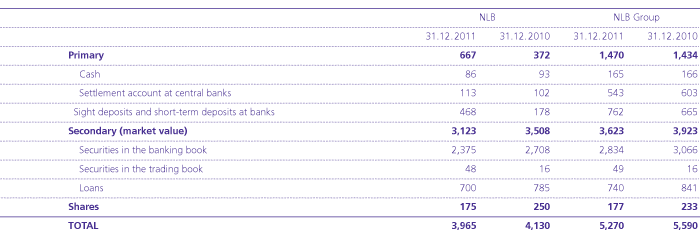
Non-derivative cash flows
The tables below illustrate the cash flows from non-derivative financial instruments by residual maturities at the end of the year. The amounts disclosed in the table are the undiscounted contractual cash flows, determined on the basis of spot rates at the end of the reporting period.
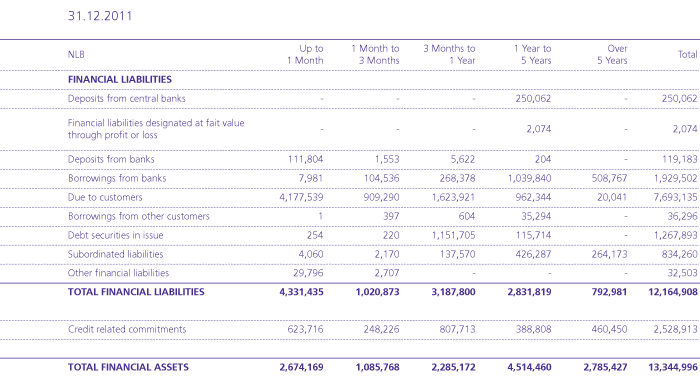
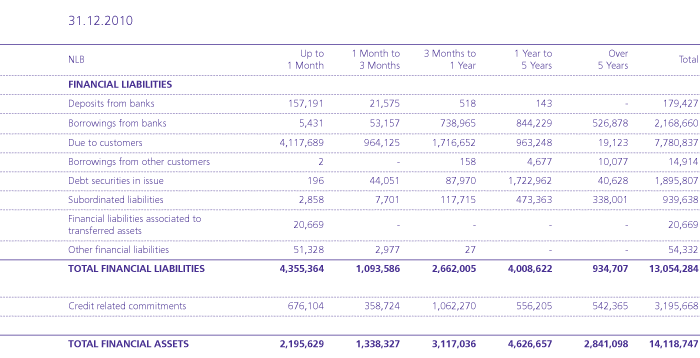
When determining the gap between the financial liabilities and financial assets in the maturity bucket of up to 1 month, it is necessary to take into account the fact that financial liabilities include total demand deposits, and that NLB may apply a stability weight of 50% to demand deposits when ensuring compliance with the central bank regulations concerning the calculation of the liquidity position. To ensure NLB’s and the NLB Group’s liquidity and based on its approach to risk, the NLB Group compiled in previous years a substantial amount of high-quality liquid investments, mostly government securities and selected loans, which are accepted as adequate financial assets by the ECB.
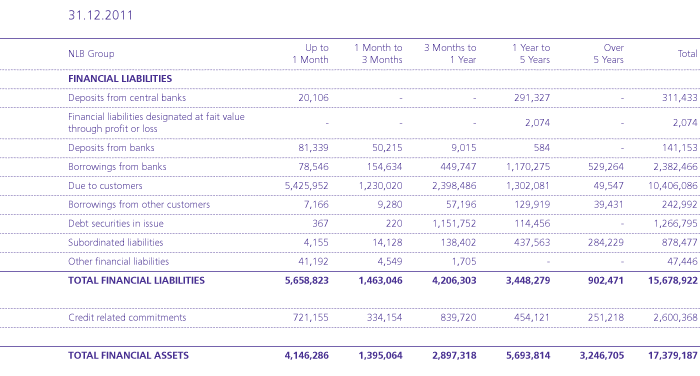
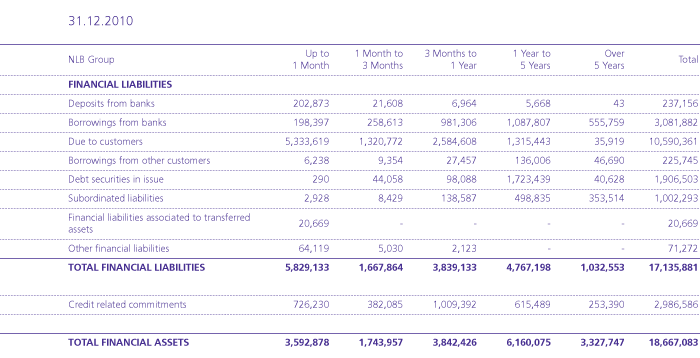
Subordinated liabilities with no contractual maturity are included in maturity buckets based on when the NLB expects their redemption.
An analysis of the statement of financial position by residual maturity based on discounted cash flows is presented in table below.
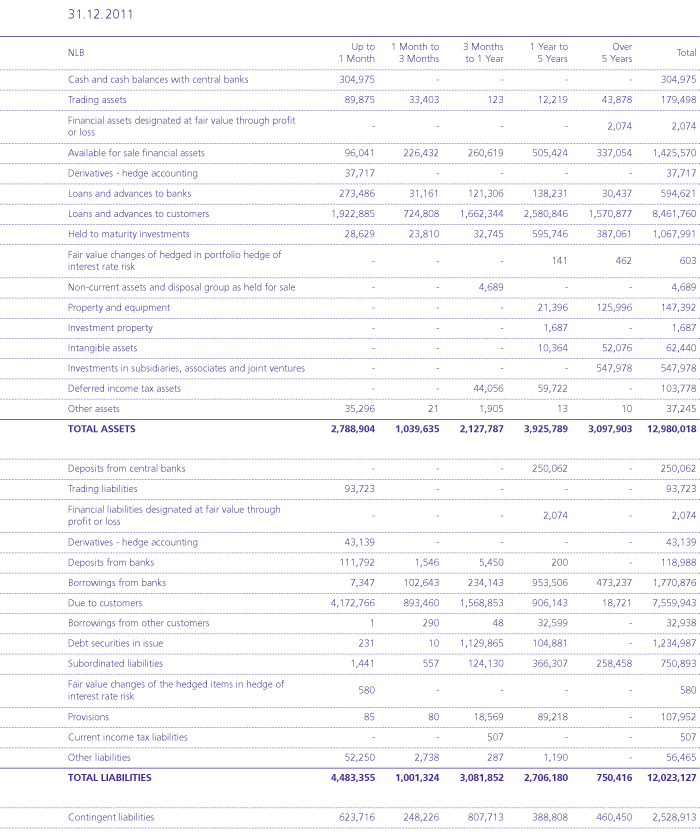
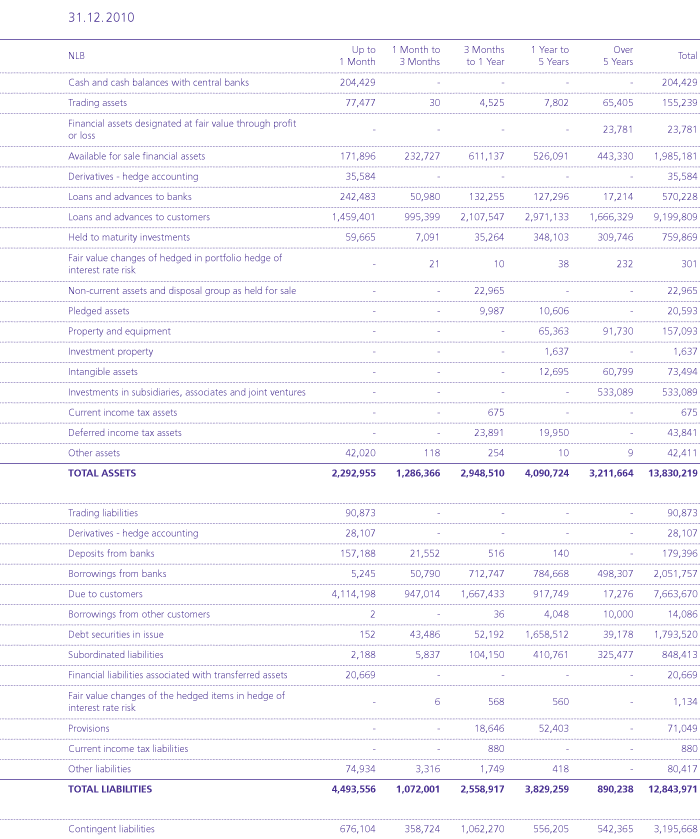
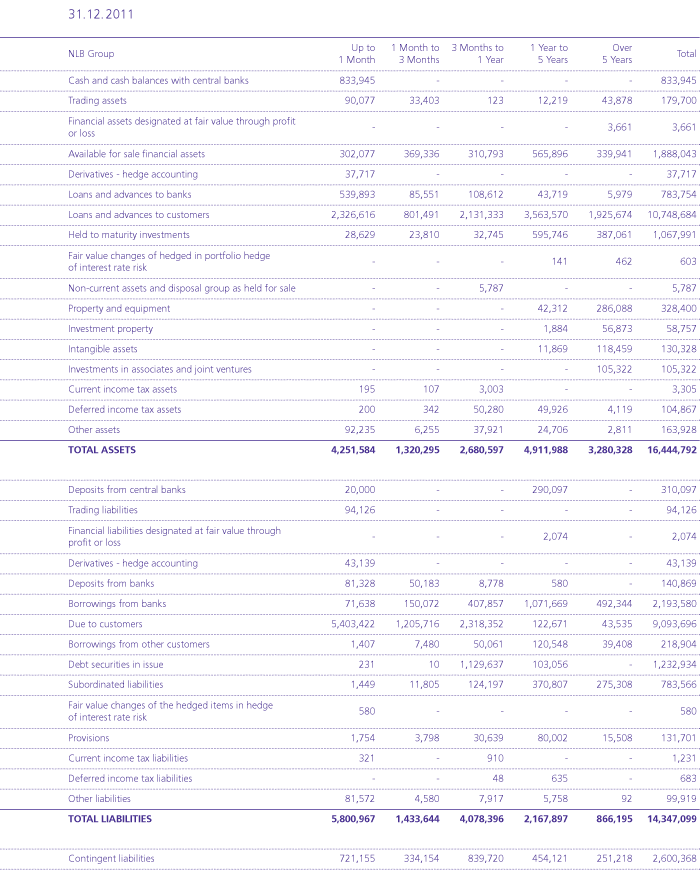
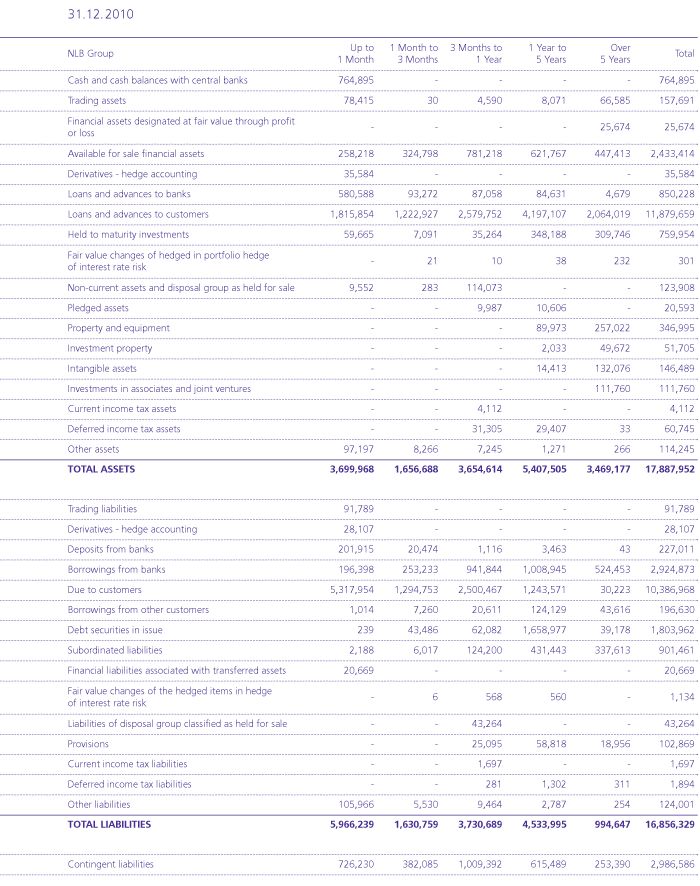
Derivative cash flows
The NLB Group’s derivatives are settled on a gross basis, except for certain interest rate swaps. The table below illustrates cash flows from derivatives, broken down into the relevant maturity buckets based on residual maturities. The amounts disclosed in the table are the contractual undiscounted cash flows, prepared on the basis of spot rates on the reporting date.
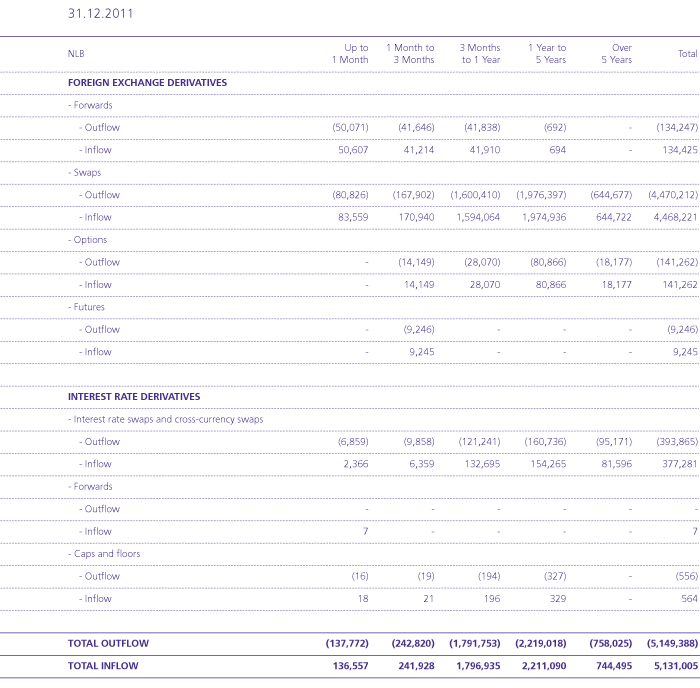
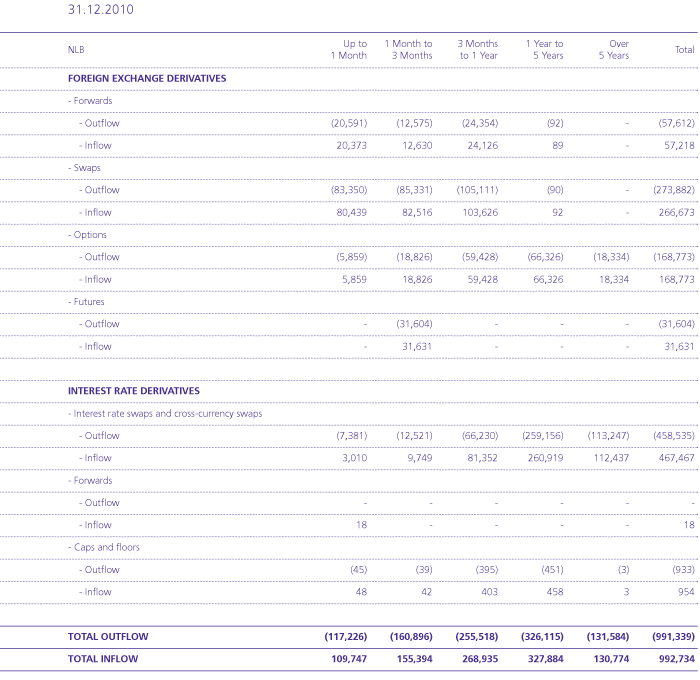
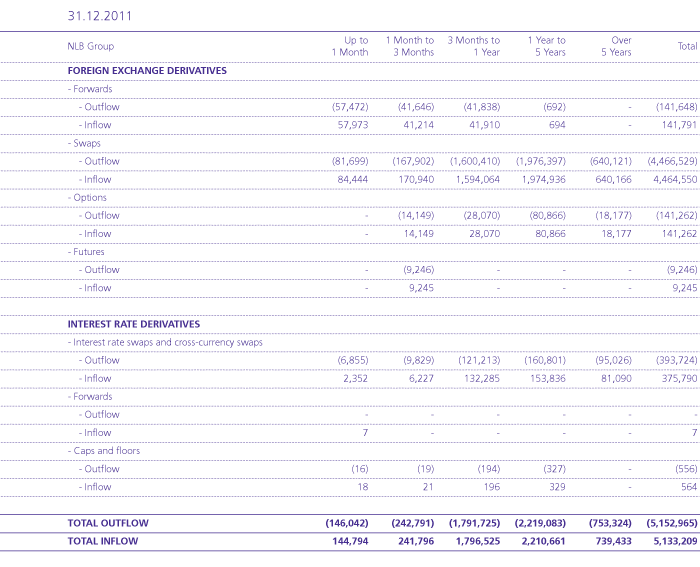
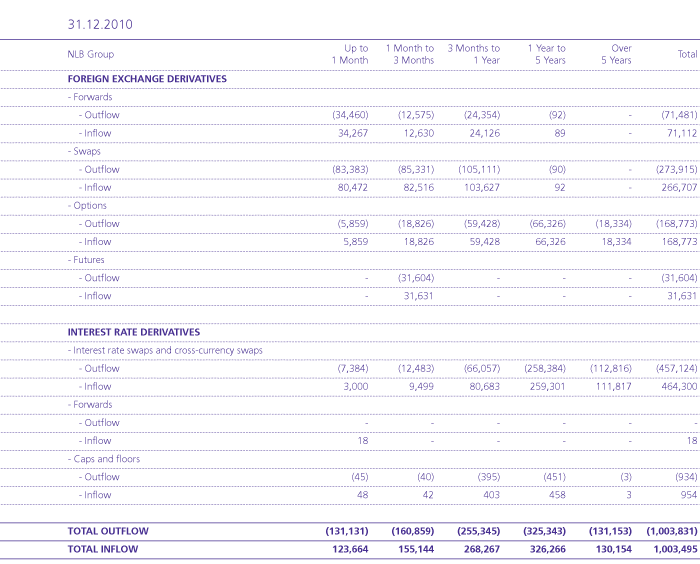
Managing NLB’s secondary liquidity reserves
The NLB Group has available primary and secondary liquidity reserves to cover liabilities. Primary liquidity reserves must be available very soon following the realization of a stress test scenario (immediately, i.e. within one week). This is the ability to generate and secure rapidly realizable and highly liquid assets in the short term. The majority of primary liquidity reserves is represented by cash, funds on settlement accounts at central banks and sight and short-term funds at other banks. NLB's secondary liquidity reserves are of exceptional importance in meeting liquidity needs and complying with regulations governing this area. These mainly comprise prime debt securities issued by EU countries and eligible for ECB transactions, while one third of secondary liquidity reserves are accounted for by loans that meet ECB eligibility criteria in full. ECB eligible loans are loans secured by a government guarantee and loans to government agencies.
NLB considers high-quality securities and ECB-eligible loans, on the basis of which it is possible to raise liquid assets on the market or at the central bank, as secondary liquidity reserves. The extent of secondary liquidity reserves depends on the liquidity needs of NLB and the NLB Group.
At the end of 2011, the balance of ECB-eligible loans amounted to EUR 700 million (December 31, 2010: EUR 785 million). The total balance of secondary liquidity reserves as at December 31, 2011 amounted to EUR 3,123 million (December 31, 2010: EUR 3,508 million). ECB eligible loans include government-guaranteed loans and loans to government agencies.
Debt securities are classified into the trading or banking book depending on the purpose of their acquisition and on the intended manner of disposal. Securities that the NLB Group acquires principally for generating profits as the difference between purchase price and selling price are classified in the trading book. Securities in the trading book are always classified in the financial statements as financial assets held for trading.
The NLB Group also gives a great deal of attention to the monitoring and compliance of structural liquidity indicators, which indicate the appropriate maturity and structure of sources of funding in connection with the credit portfolio. A more detailed overview of the NLB Group's structural liquidity is facilitated by liquidity gaps and their short-, medium- and long-term projections of relevant cash flows. The NLB Group's sources of funding are appropriately diversified in the current conditions, and ensure an appropriate proportion of long-term sources of funding with respect to its credit portfolio.
The debt securities portfolio of the banking book is also used simultaneously for providing secondary liquidity, stabilizing the interest margin and managing NLB’s interest rate risk. Securities in the banking book are classified as “available for sale” or “held to maturity”. When managing the portfolio, NLB uses conservative principles, particularly with respect to the structure of the portfolio in terms of issuers’ ratings and the maturity of portfolio. The framework for managing the securities of the banking book is the policy for managing debt securities in the banking book, which clearly defines the objectives and characteristics of the associated portfolio.
The basic provisions of the policy for managing debt securities in the banking book are as follows:
- the securities with a fixed interest rate must account for at least 75% of the total portfolio in order to stabilize NLB’s interest margin;
- the majority of the securities must comprise securities that can be pledged with the ECB, i.e. are on the list of eligible financial assets at the ECB; a maximum of EUR 250 million in securities can be outside aforementioned list;
- modified portfolio duration is calculated semi annually and may not exceed 3 years;
- a maximum of 40% of the total value of the portfolio can be classified as “held to maturity”;
- there may be no more than EUR 600 million of bank, corporate or structured securities; and
- there may be no more than EUR 100 million of structured securities.
As at December 31, 2011, the balance of debt securities in the banking book of NLB was EUR 2.386 million and in the banking book of NLB Group EUR 2.857 million. Of these, 82.82% were government securities (December 31, 2010: 80.4%), 8.22% were government-guaranteed bank bonds (December 31, 2010: 12.6%), 1.85% multilateral institution bonds (December 31, 2010: 0.7%), 1.15% covered bonds (December 31, 2010: 0%) and 5.95% bank and corporate securities (December 31, 2010: 6.3%). In comparison to 2010, there have been in 2011 decrease in exposure to PIIGS countries (Portugal, Italy, Ireland, Greece and Spain) for EUR 148.5 million on nominal value in amount of EUR 21.5 million. In second half year of 2011 we have in accordance with Private Sector Involvement proposal of Institute of International Finance gradually impair Greek government bonds, primarly on 79% of price and secondary with new proposal of Private Sector Involvement on 50% of price.
Structure of government securities in banking book
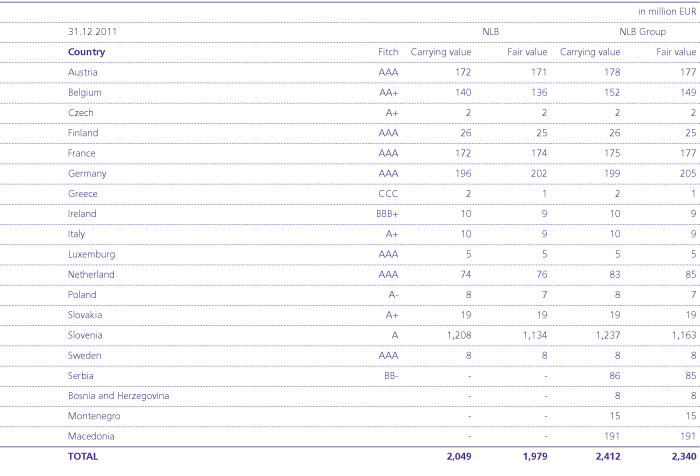

For quality operational risk management, the NLB Group established a system to collect data regarding loss events, and to identify and assess operational risks. As the highest authority in the area of operational risk management, NLB named an Operational Risk Committee to serve as the decision-making body of NLB's Management Board. The relevant committees for (operational) risk were also named at other NLB Group banks. The management board serves in this role at other subsidiaries. The task of the aforementioned bodies is to discuss the most significant operational risks, and to monitor and support the effective management of operational risks at an individual company.
The upper tolerance limit to operational risk permitted by an individual bank or leasing entity in its operations, has been defined. A net loss exceeding that limit must be treated individually and additional measures taken, as necessary, to prevent the same or similar loss events. The relevant provisions are created for loss events, the material consequences of which are appropriately assessed.
Future losses are estimated by assessing identified operational risks. An operational risk profile is drafted once a year on the basis of these assessments. The most significant risks are managed actively.
NLB Group members have adopted relevant documents that are in line with NLB standards. These are updated periodically in line with the development of operational risk management. Thus, NLB’s operational risk management model was implemented throughout the entire NLB Group. NLB strives to continuously update the aforementioned model, which is also supported by the development of the relevant software support.
Capital requirements for operational risk are calculated using the standardized approach at NLB and using the basic indicator approach at the NLB Group level.

The portfolio of debt securities in the banking book is intended to provide secondary liquidity and manage the NLB Group’s interest rate risk. When managing the portfolio, the Group uses conservative principles, particularly with respect to issuers’ ratings and the maturity of the portfolio.
Structure of the banking book according to Fitch ratings:
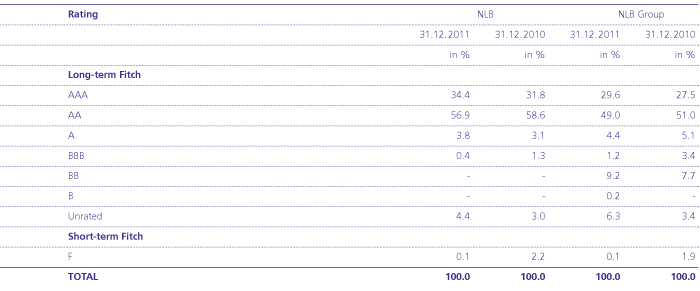
Most of securities with no external rating are high quality treasury bills (Germany, Netherland, France, Belgium and other European countries) and Slovenian securities with the guarantee of the Republic of Slovenia. Relatively small part presents bank and corporate securities.
The value of bonds in NLB's trading book amounted to EUR 13 million as at December 31, 2011 (December 31, 2010: EUR 12.6 million), while in the NLB Group amounted to EUR 13.8 million (December 31, 2010: EUR 15.2 million). NLB also holds certificates of deposits from domestic banks that as at December 31, 2011 amounted to EUR 2 million (December 31, 2010: EUR 0.4 million). In 2011 NLB has mostly traded with AA and A rated commercial bills; as at December 31, 2011 the trading book of commercial bills amounted to EUR 33 million (December 31, 2010: nil).
Structure of the trading book according to internal ratings:

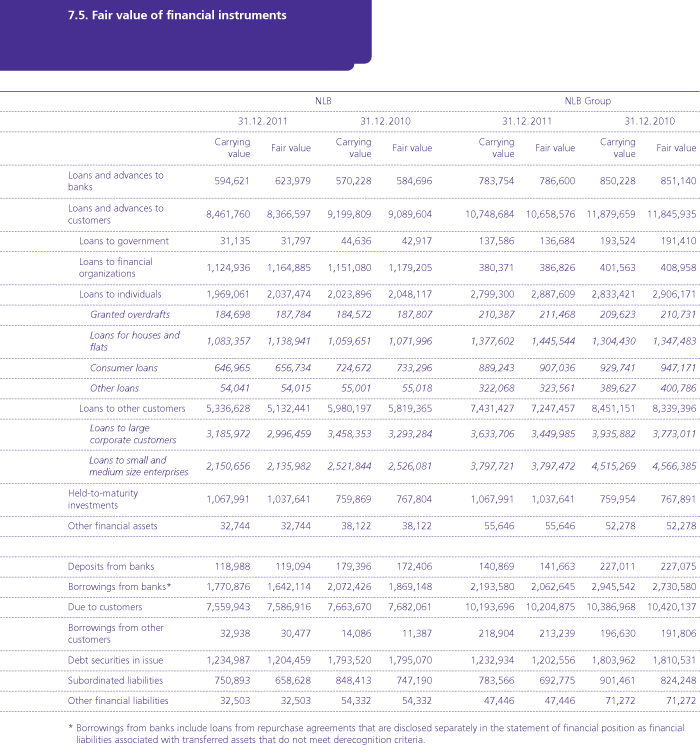
Loans and advances to banks
The estimated fair value of deposits is based on discounted cash flows using prevailing money market interest rates for debts with similar credit risk and residual maturities. The fair value of overnight deposits equals their carrying value.
Loans and advances to customers
Loans and advances are net of the allowance for impairment. The estimated fair value of loans and advances represents the discounted amount of estimated future cash flows expected to be received. Expected cash flows are discounted at current market rates to determine their fair value.
Deposits and borrowings
The fair value of sight deposits and overnight deposits is equal to their carrying value. However, their actual value for the NLB Group depends on timing and amounts of cash flows, current market rates and the credit risk of the depository institution itself. A portion of sight deposits is stable, similar to term deposits. Therefore, their economic value for the NLB Group differs from the carrying amount.
The estimated fair value of other deposits and borrowings from customers is based on discounted cash flows using interest rates for new deposits with similar residual maturities.
Held to maturity investments and issued debt securities
The fair value of held to maturity investments and issued debt securities is based on their quoted market price or value calculated by using a discounted cash flow method and prevailing money market interest rates.
Loan commitments
For credit facilities that are drawn soon after the NLB Group grants the loans (drawn at market rates) and loan commitments to those clients that are not impaired, the fair value is close to zero. For loan commitments to clients, that are impaired, the fair value represents the amount of the created provisions.
Other financial assets and liabilities
The carrying amount of other financial assets and liabilities is a reasonable approximation of their fair value, as they relate mainly to short-term receivable and payables.
8. OTHER DISCLOSURES

a) Segments
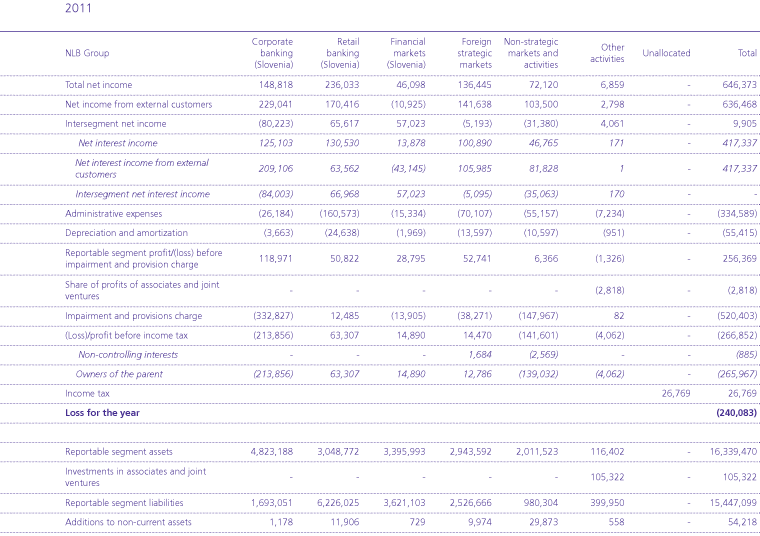
The groups segments are business units that focus on different customers and markets. They are managed separately because each business unit requires different strategies and service level. Business activities of NLB are divided into several segments where intersegment transactions present multiple transfer prices. Other NLB Group members are, based on its business activity, included in only one segment.
Description of segments:
- Retail banking in Slovenia represents banking with individuals, commercial banking for small and medium enterprises and sole traders in NLB and assets management – NLB Skladi, Ljubljana;
- Corporate banking in Slovenia represents commercial banking in NLB with medium and large enterprises;
- Financial markets in Slovenia represent all treasury activities, operations with financial institutions and investment banking in NLB;
- Foreign strategic markets represent all business activities from the strategic NLB Group members on strategic markets in the NLB Group (Bosnia and Herzegovina, Montenegro, Kosovo and Macedonia);
- Non-strategic markets and activities represent total activities from the NLB Group members on non-strategic markets in the NLB Group (Croatia, Serbia, Germany, Switzerland and Czech Republic) and all leasing companies. The financial result of this segment include also sold or liquidated (NLB Bank Sofia, Sofia, NLB Factor, Bratislava and NLB Nova Penzija, Beograd) and
- Other activities represent the investments in associates, financial results from non-financial members of the NLB Group (property management, maintenance, catering and tourism services) and other expenses that are not related to reportable segments.
Since NLB Group is primarily a financial group and interest income represents the majority of the NLB Group’s income, the main indicators of a segment’s efficiency are net profit before provisions and impairments and net profit.
There was no income from transactions with a single external customer that amounted to 10% or more of the NLB Group’s income.
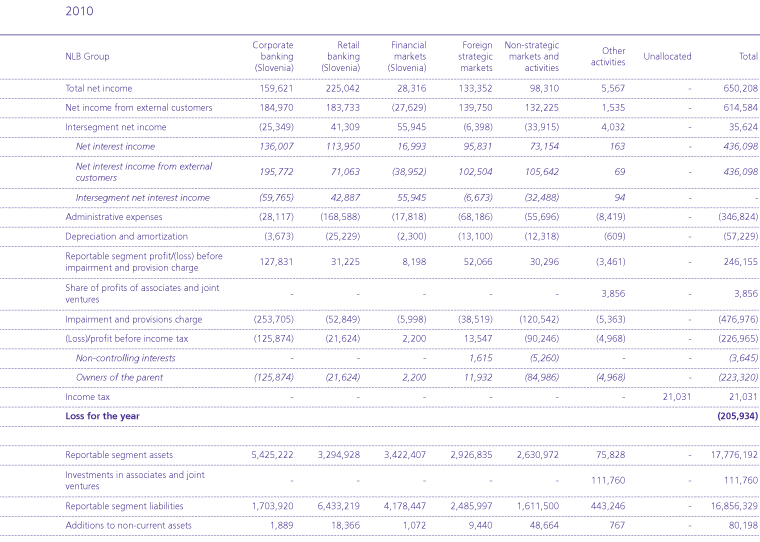
b) Geographical information

Geographical analysis includes a breakdown by geographical segments with respect to the country in which individual NLB Group entities are located.
None of the countries of South East Europe and Western Europe represents more than 10% of the NLB Group’s revenue.

A number of banking transactions are entered into with related parties in the normal course of business. The volume of related-party transactions and the outstanding balances are as follows.
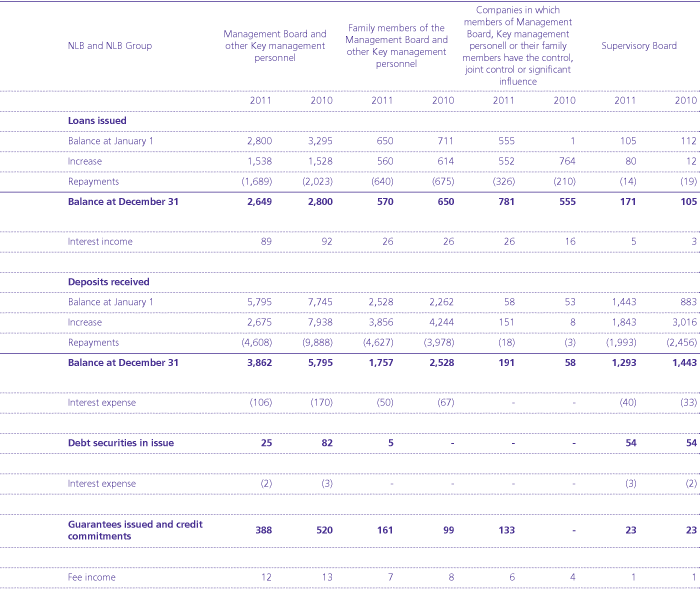
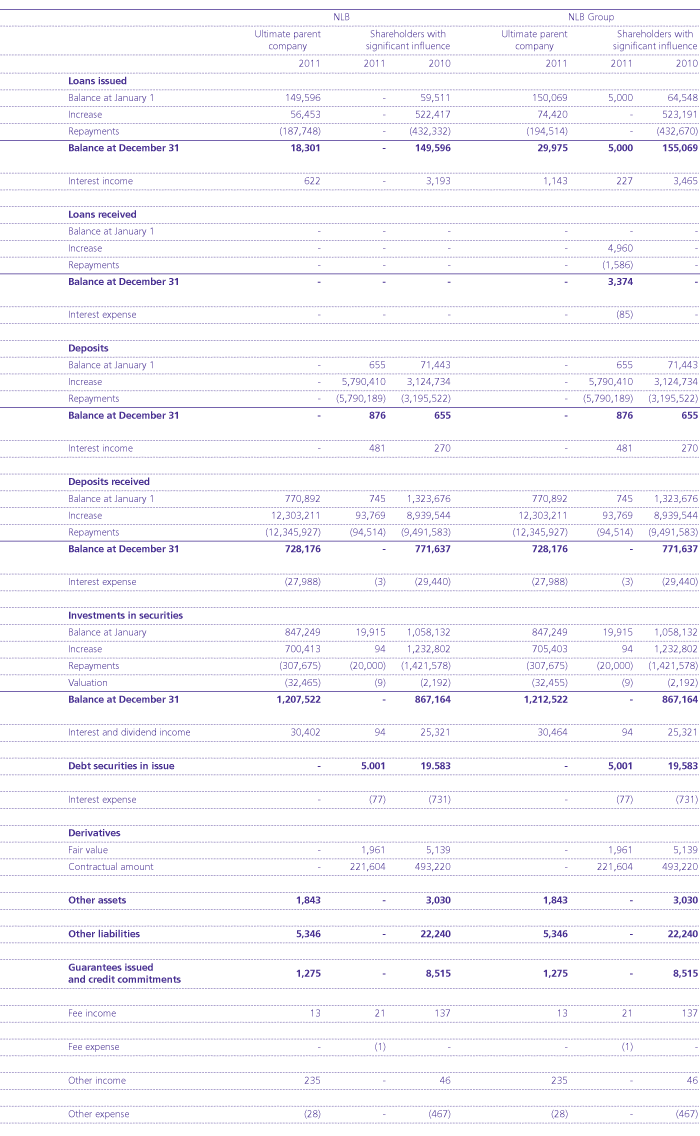
In 2010 the Republic of Slovenia was included in shareholders with significant influence. Since March 2011 it is shown as the ultimate controlling party as its direct and indirect holding in NLB exceeds 50%.
In year 2011 NLB entered into transactions with government related entities under usual terms and market prices. Individually significant transactions with government related entities present mainly long-term loans and borrowings and interest rate swaps. In 2011 the total amount of individually significant transactions for long-term loans (7 transactions) in the amount of EUR 657,129 thousand (December 31, 2010: 10 transactions in amount of EUR 1,107,792 thousand), long-term debt security in amount of EUR 200,803 thousand (December 31, 2010: EUR 148,811 thousand), short-term loan in amount of EUR 50,026 thousand (December 31, 2010; EUR 50,257 thousand), long-term borrowing (11 transactions) in the amount of EUR 598,539 thousand (December 31, 2010: 9 transactions in amount of EUR 561,295 thousand) and interest rate swaps (11 transactions) in the amount of EUR 468,352 thousand (December 31, 2010: 7 transactions in amount of EUR 396,898 thousand).
For long-term loans, NLB recognized interest income in the amount of EUR 21,207 thousand (2010: EUR 13,511 thousand), for long-term debt security interest income in amount of EUR 2,930 thousand (2010: EUR 2,600 thousand), for short-term loan interest income in amount of EUR 26 thousand (2010: EUR 231 thousand), for long-term borrowing interest expense in the amount of EUR 13,190 thousand (2010: EUR 9,686 thousand) and for interest rate swaps net interest income together with net valuation result in the amount of EUR 62,711 thousand (2010: EUR 30,327 thousand). Interest rates for loans and borrowings present 6 months EURIBOR and margin under usual terms.
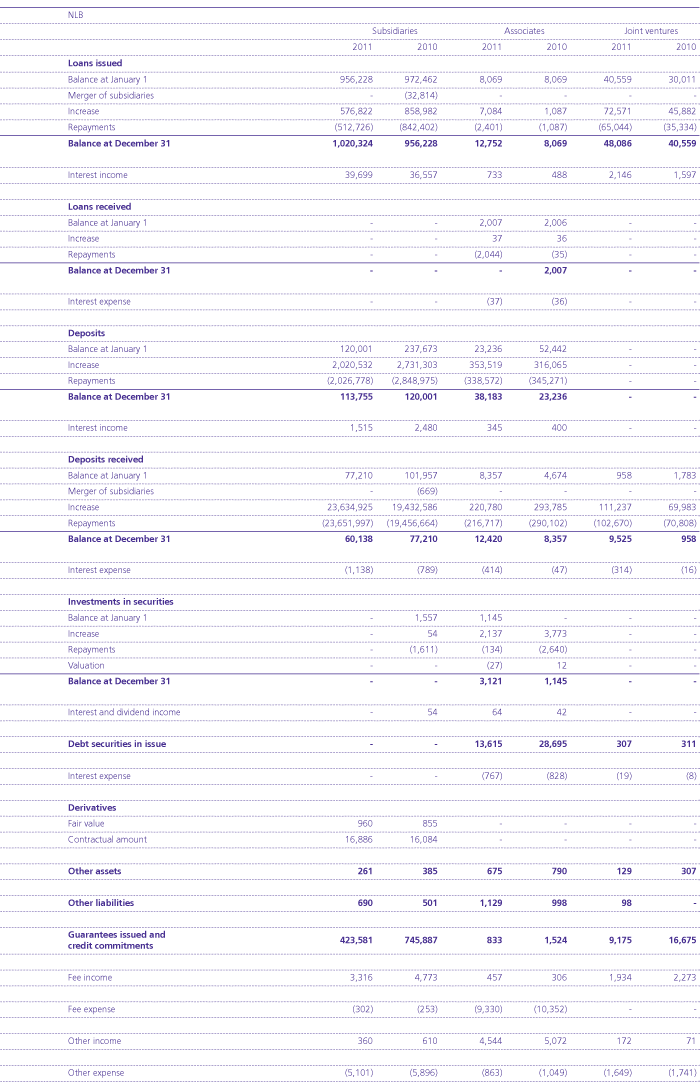
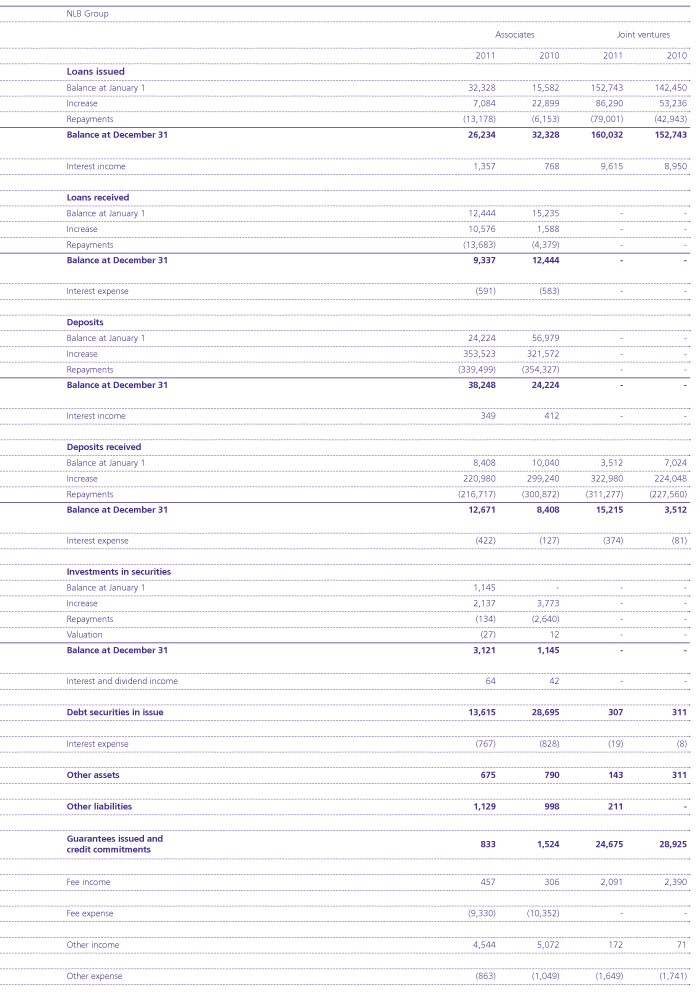
Key management compensation
In accordance with competence of the Supervisory Board, as defined by the Articles of Association of NLB, the Supervisory Board adopted the criteria for remunerating the members of the Management Board.
The basis for the collective remuneration of members of the Management Board are several quantitative indicators that compare:
- the operations of NLB and the NLB Group with respect to the plan;
- the operations of NLB and the NLB Group with respect to the previous year;
- the operations of NLB with respect to banks in Slovenia during the same year; and
- the operations of the NLB Group with respect to comparable banking groups during the same year.
The basis for the individual remuneration of members of the Management Board (qualitative part) are individual assignments from the work program for individual year.

Short-term benefits include:
- monetary benefits (gross salaries, supplementary insurance, holiday allowances, other bonuses); and
- non-monetary benefits (company cars, health care, apartments, etc.).
The reimbursement of cost comprises food allowance and travel expenses.
Post-employment benefits include additional pension insurance and annuity savings.
Accrued earnings of individual members of the Management Board
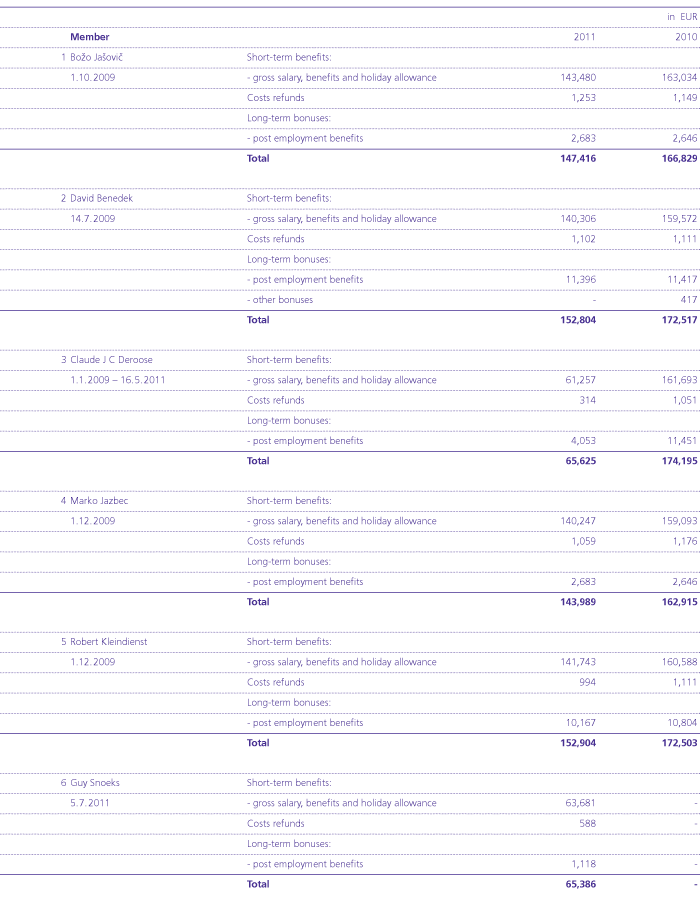
Accrued earnings of individual members of the Supervisory Board
